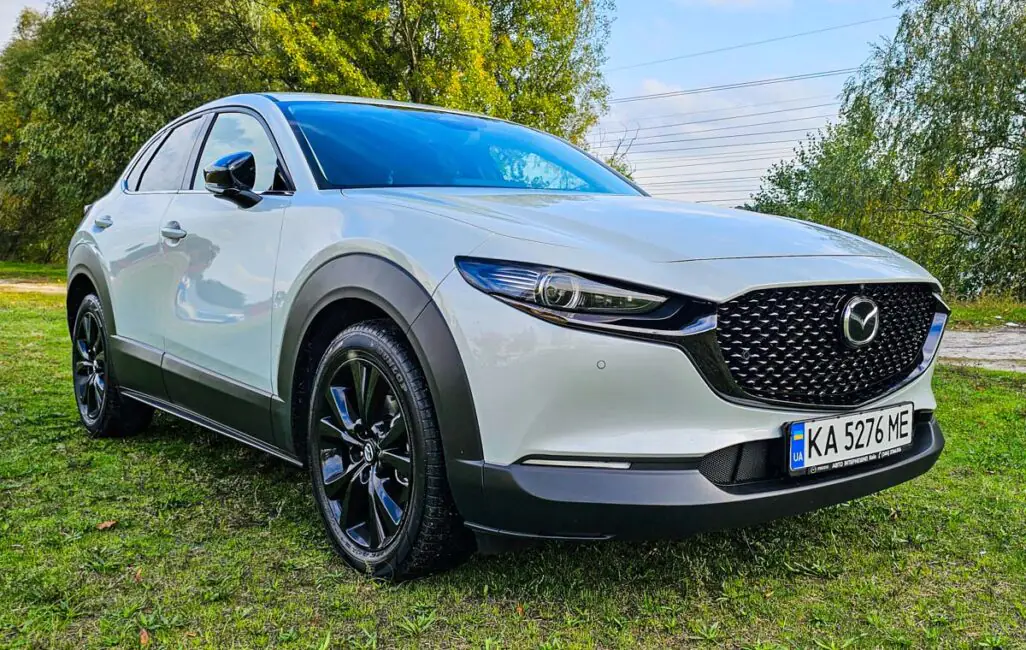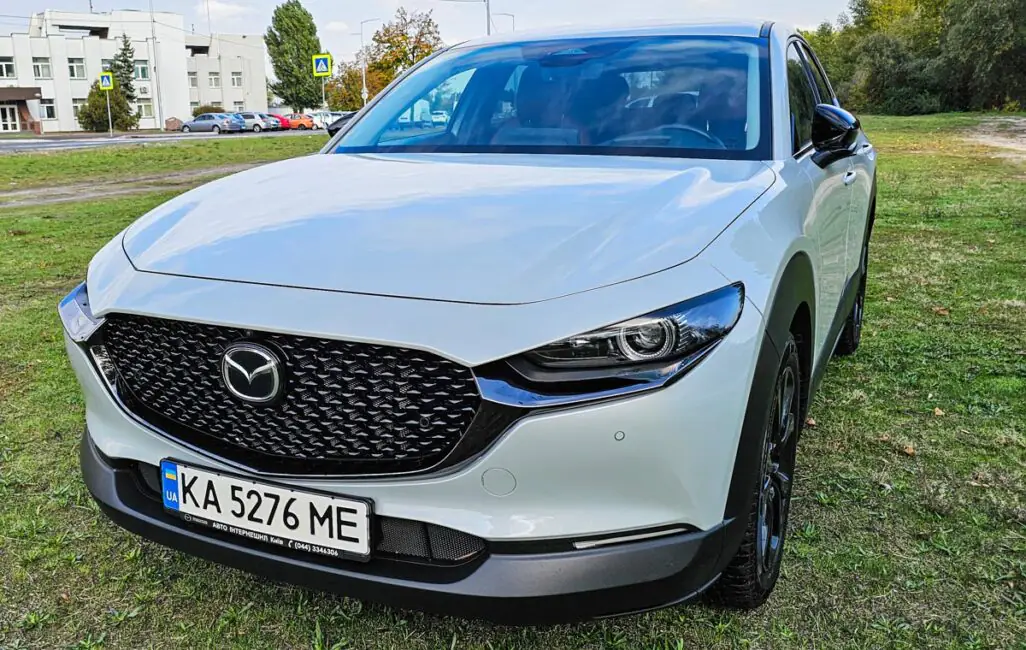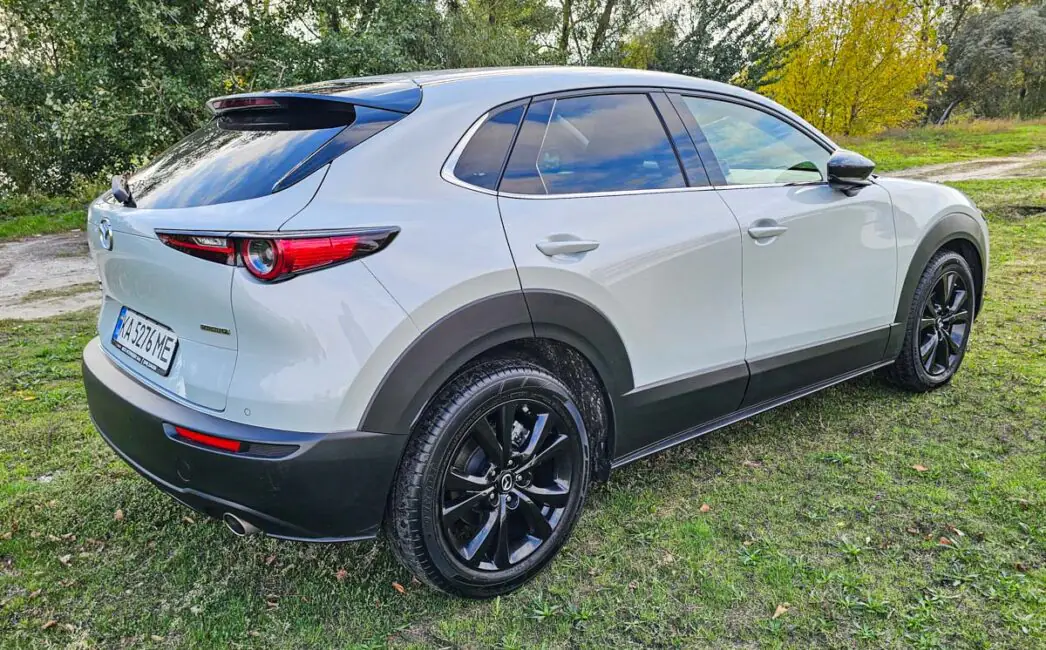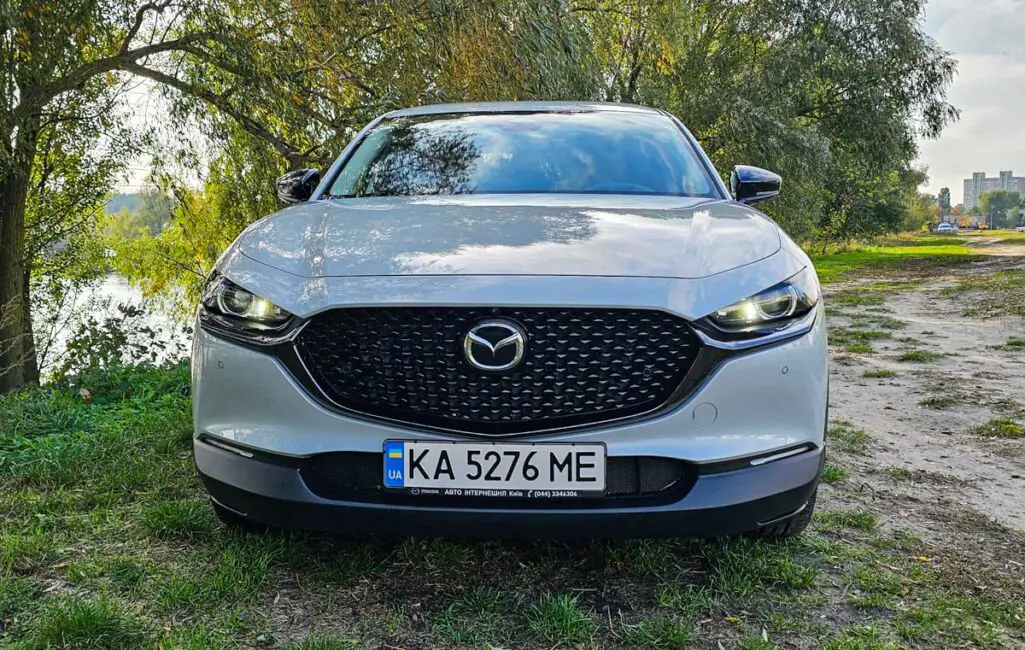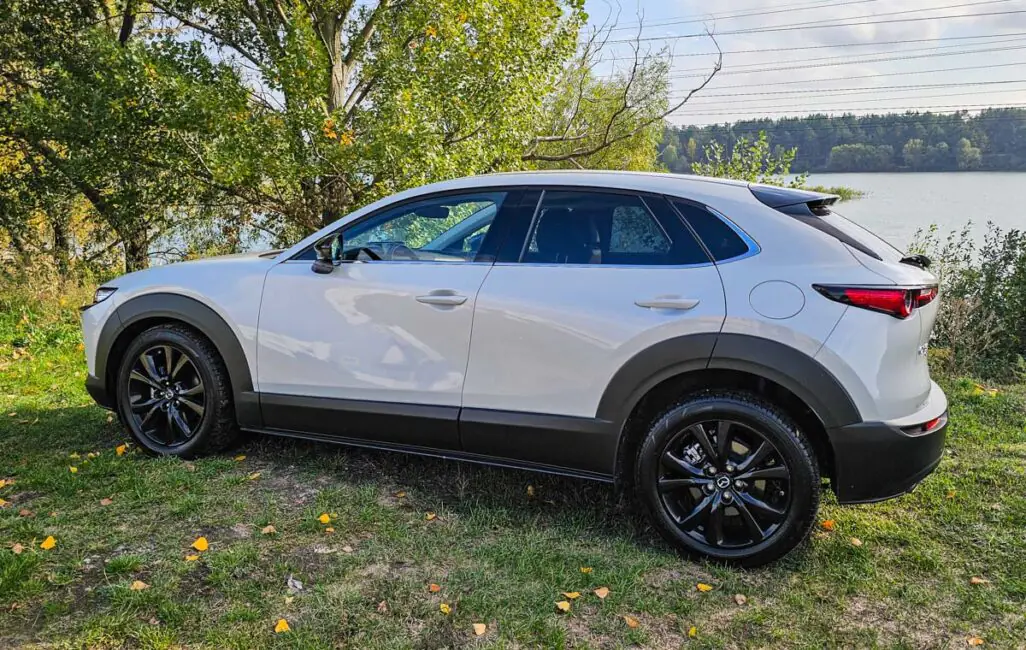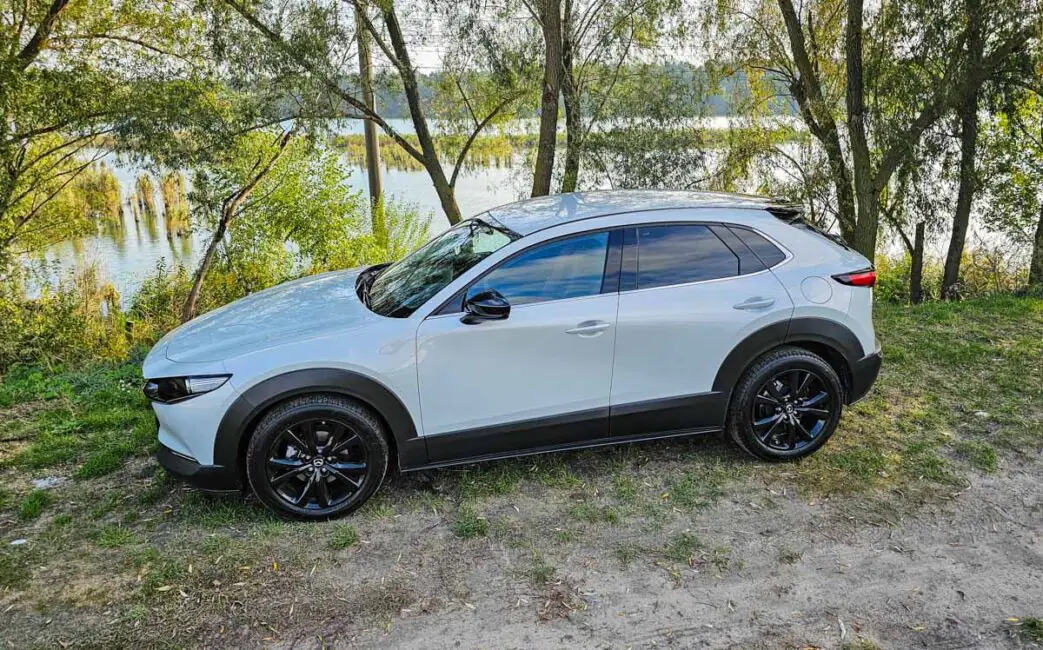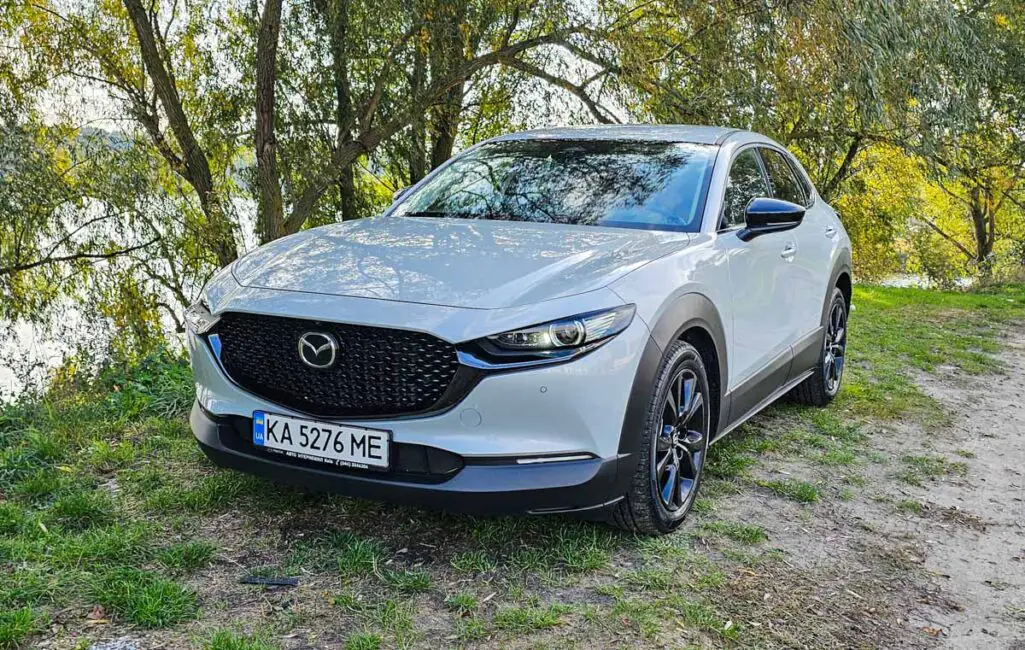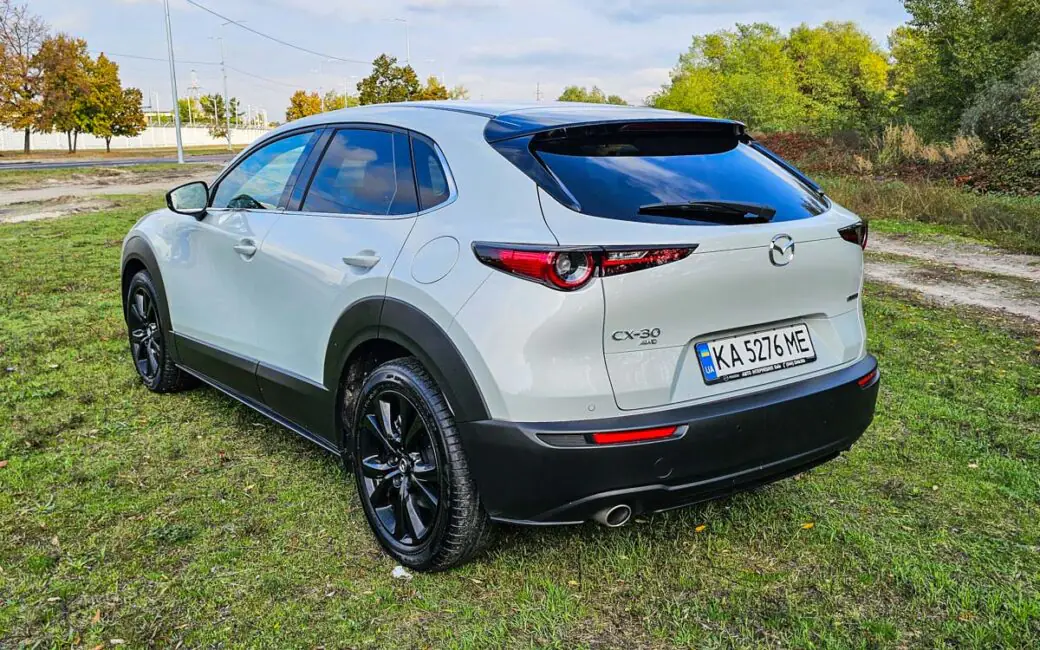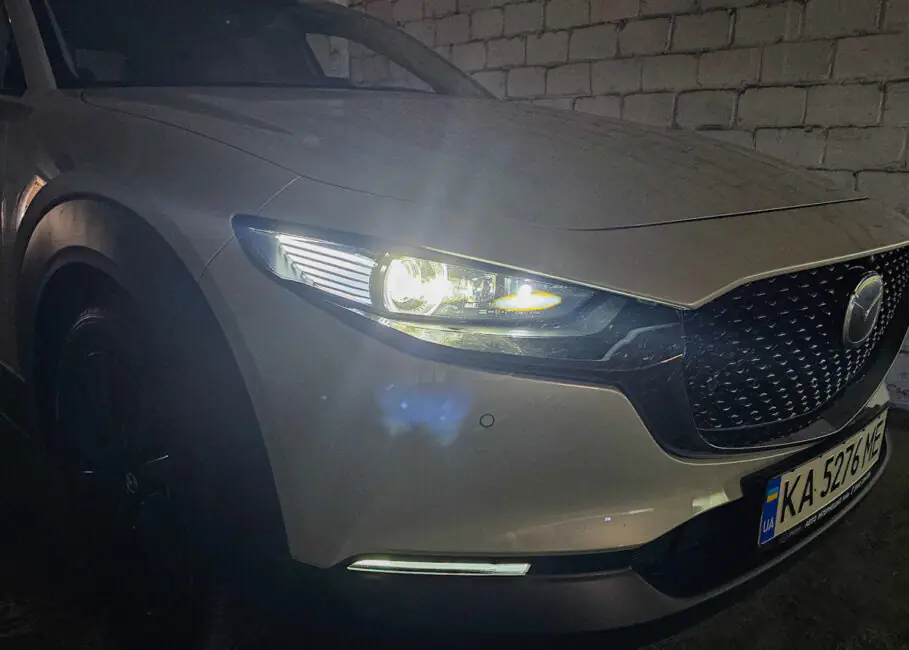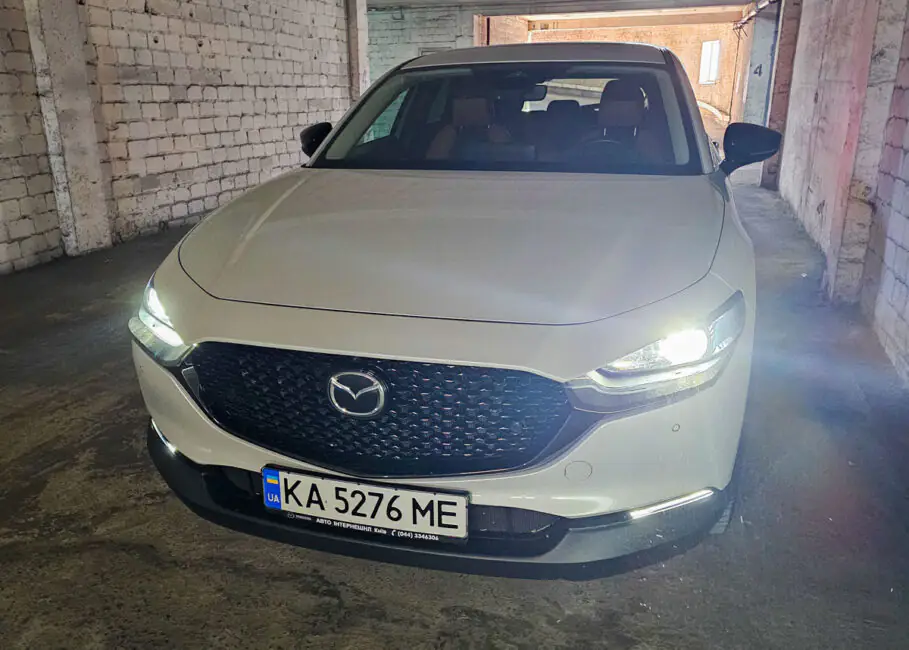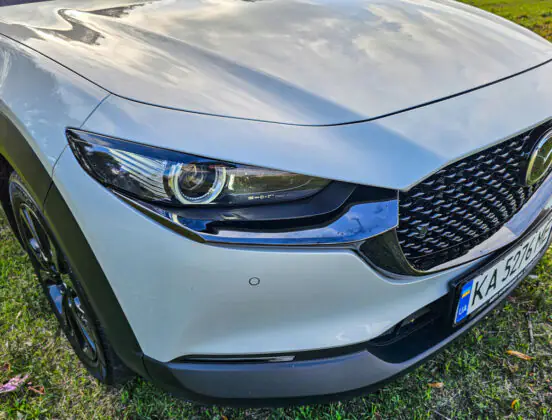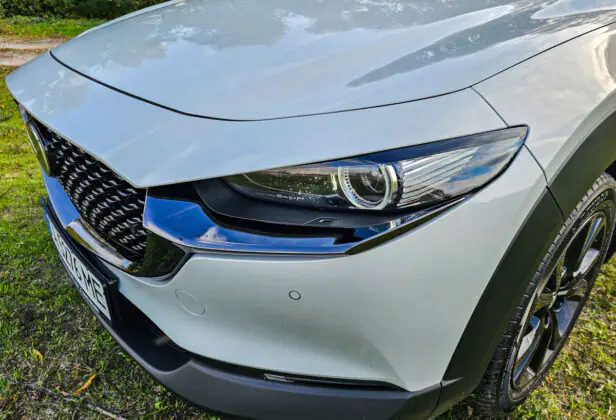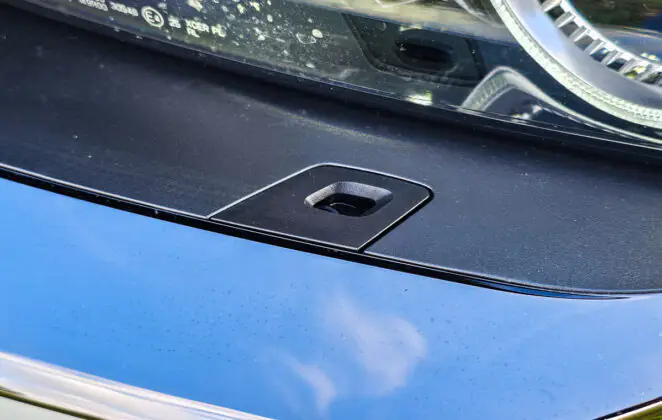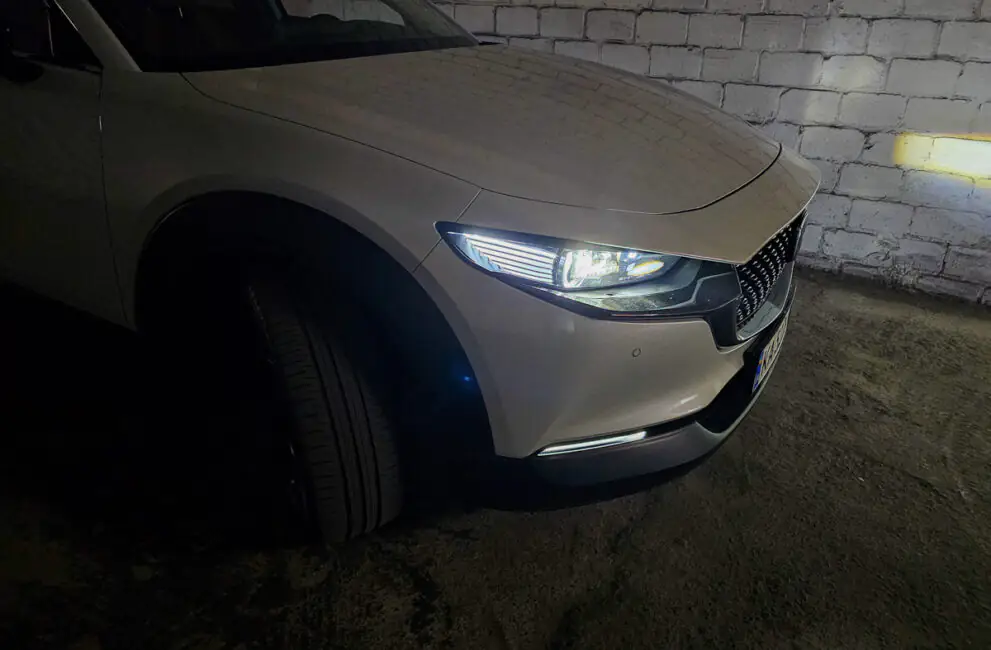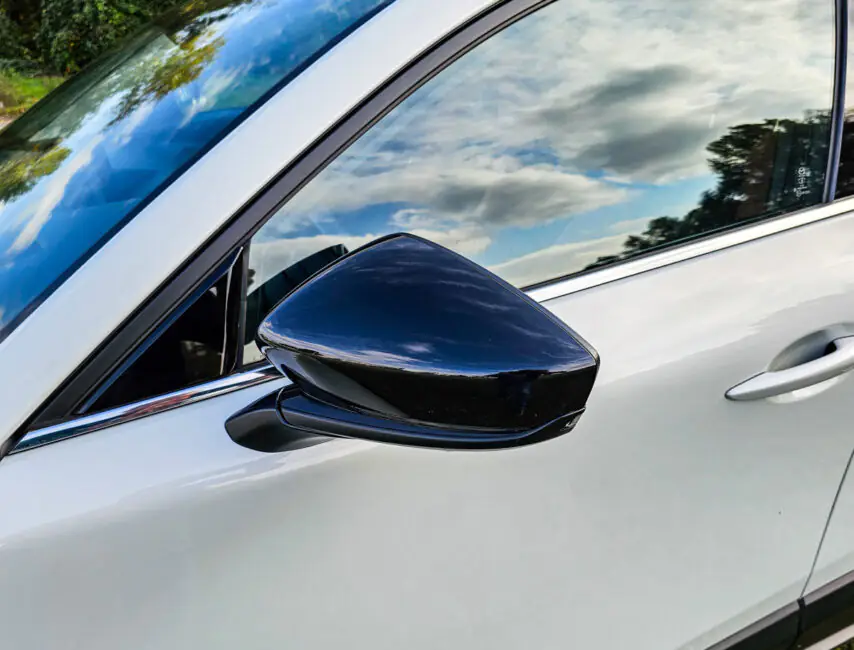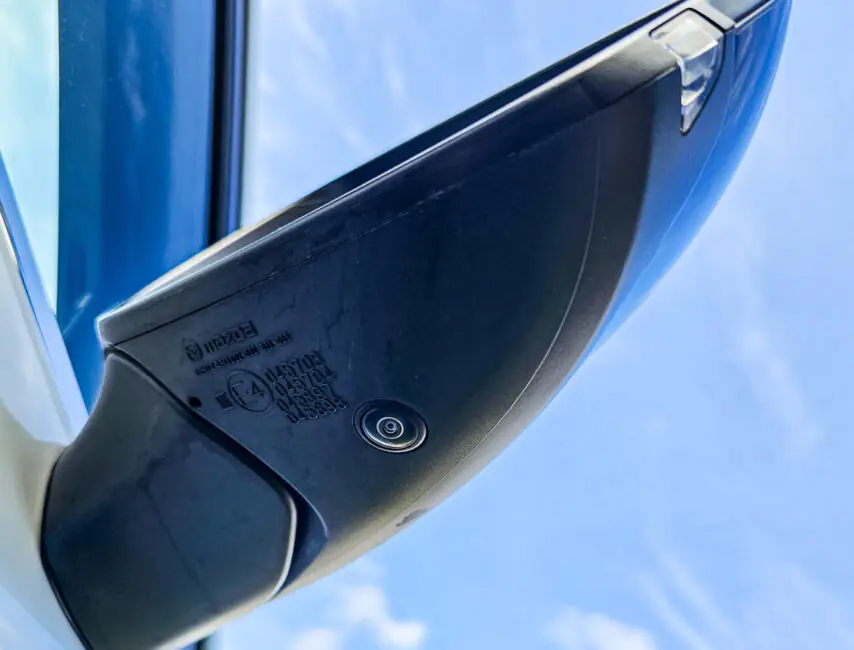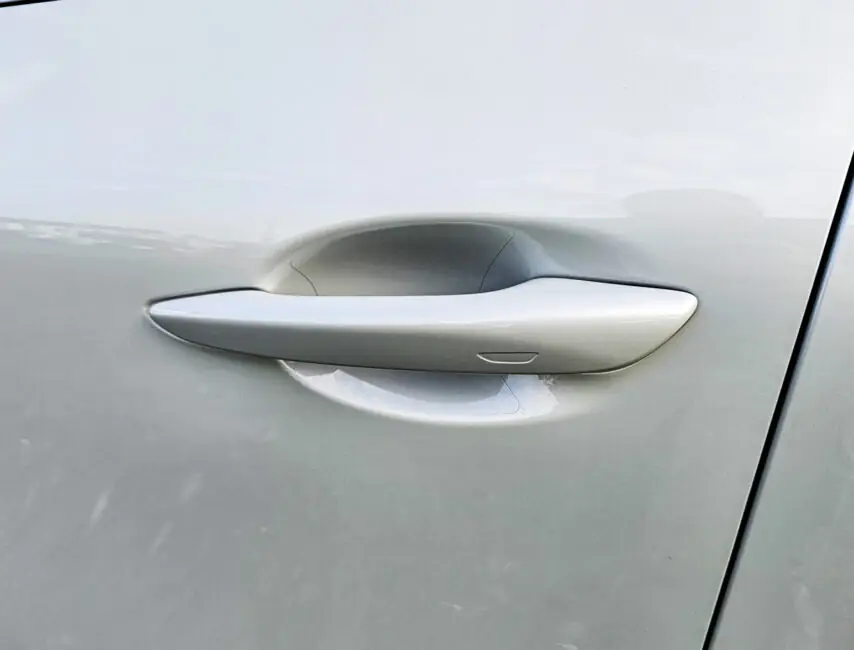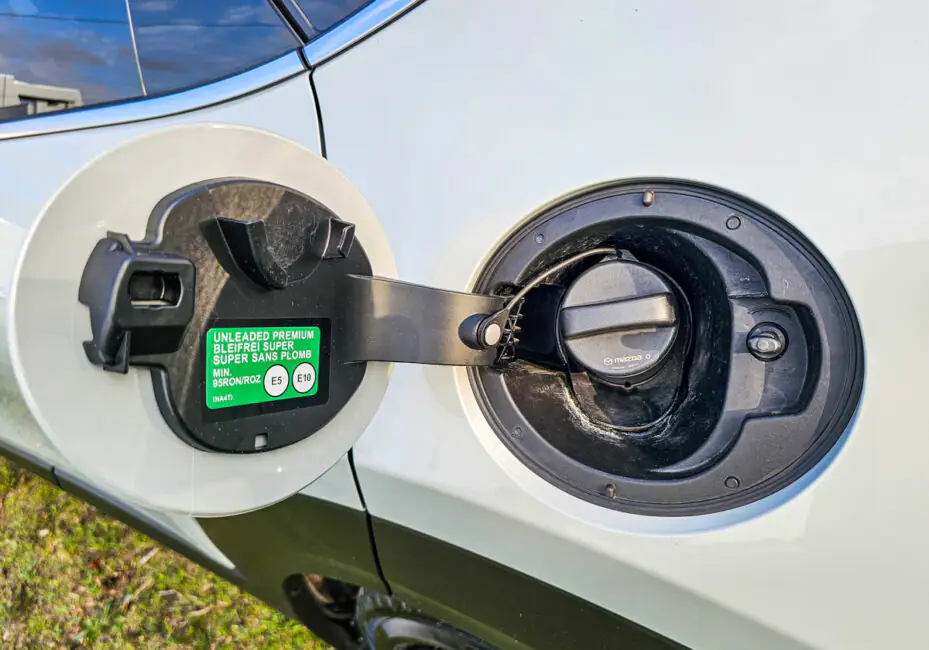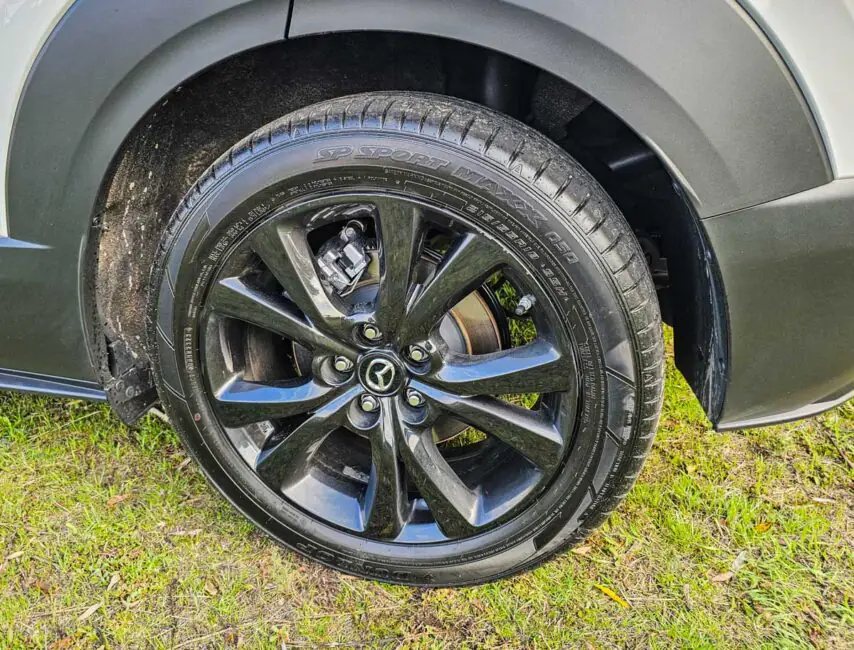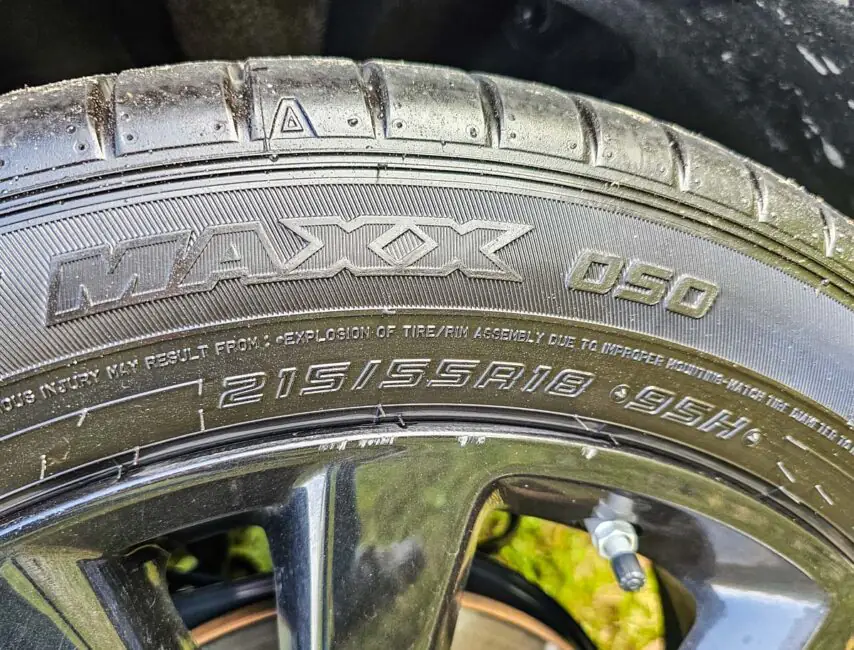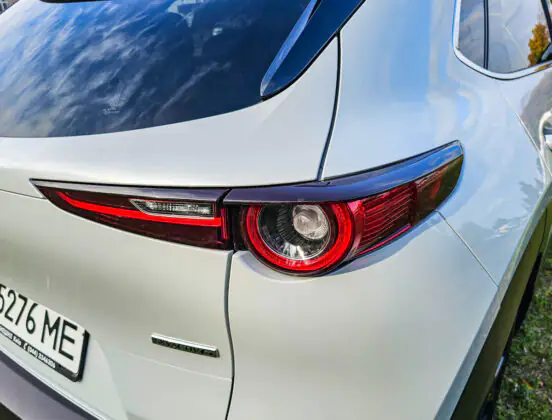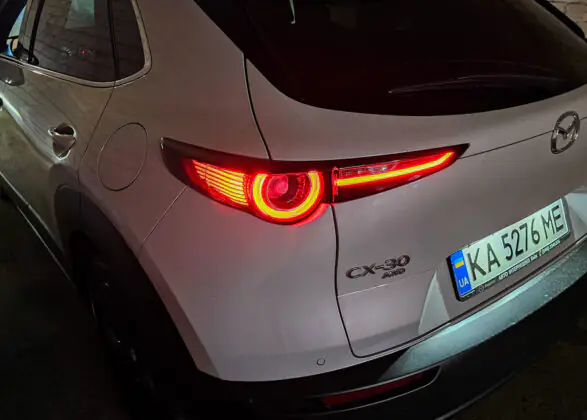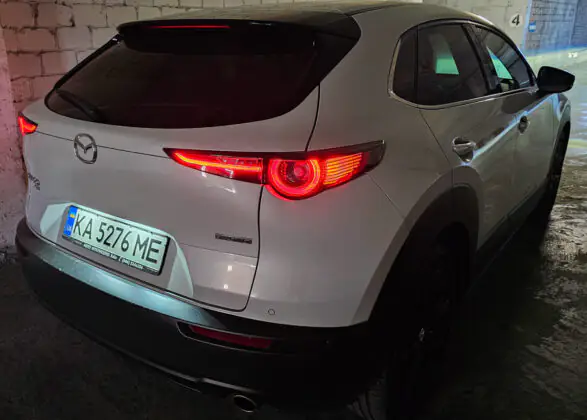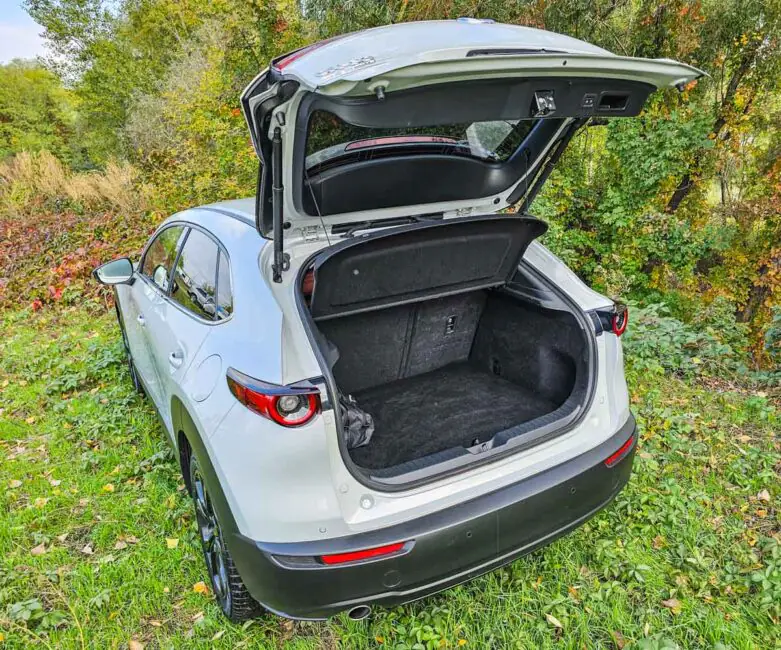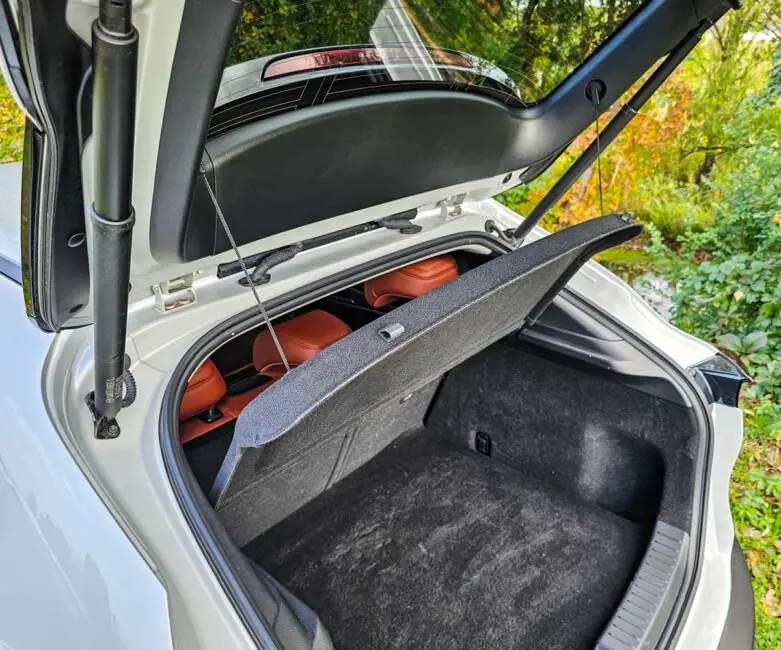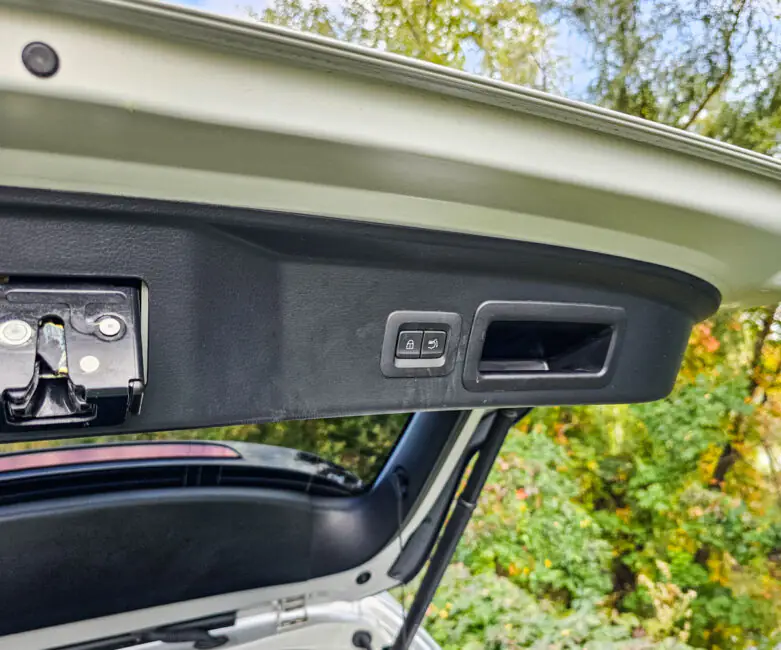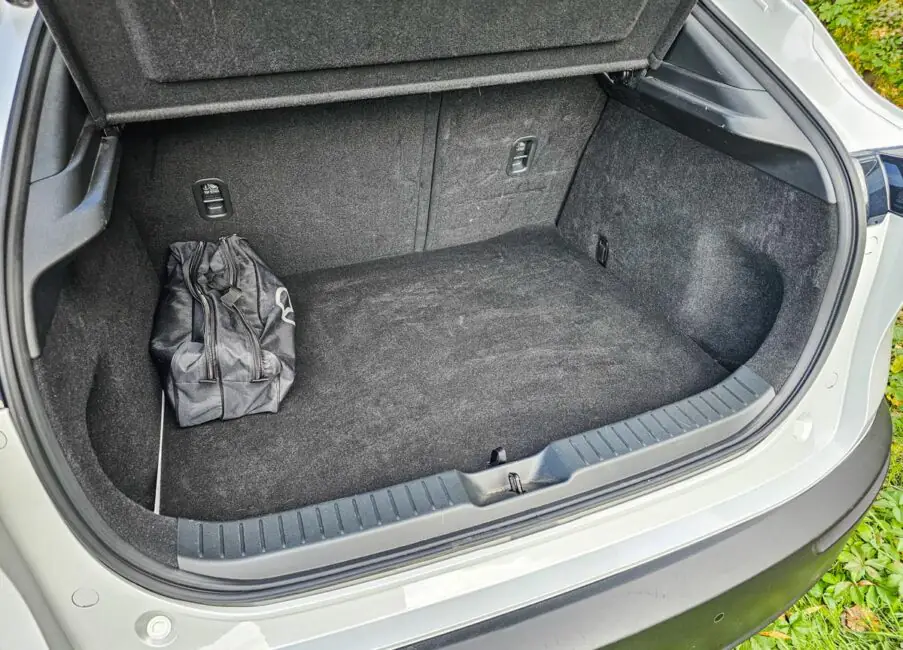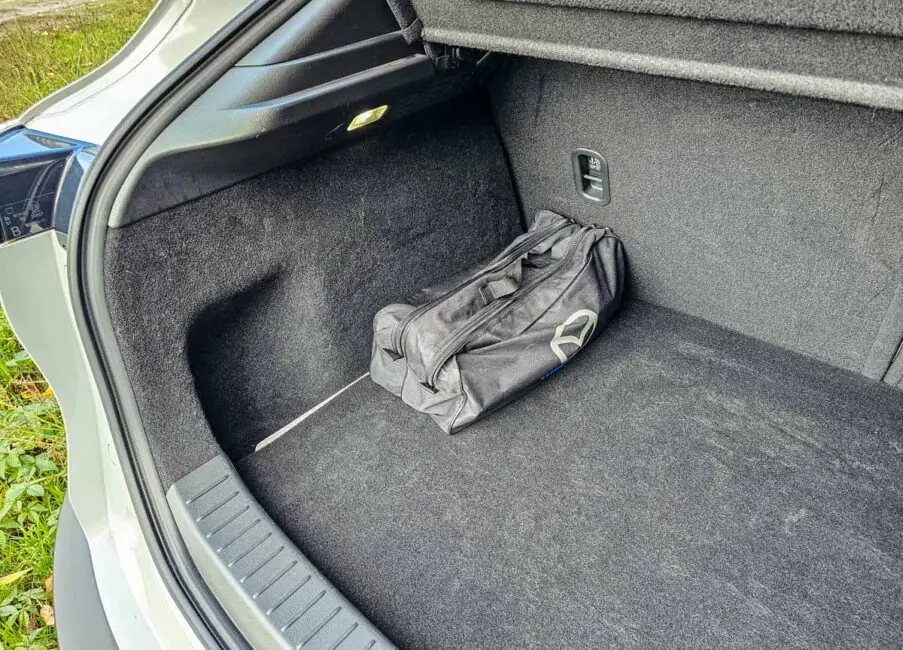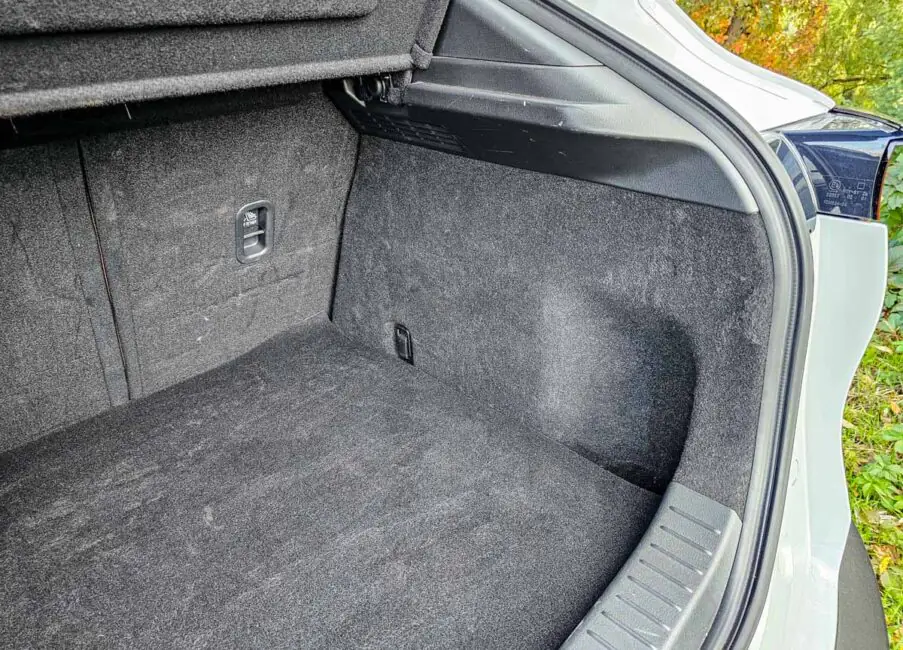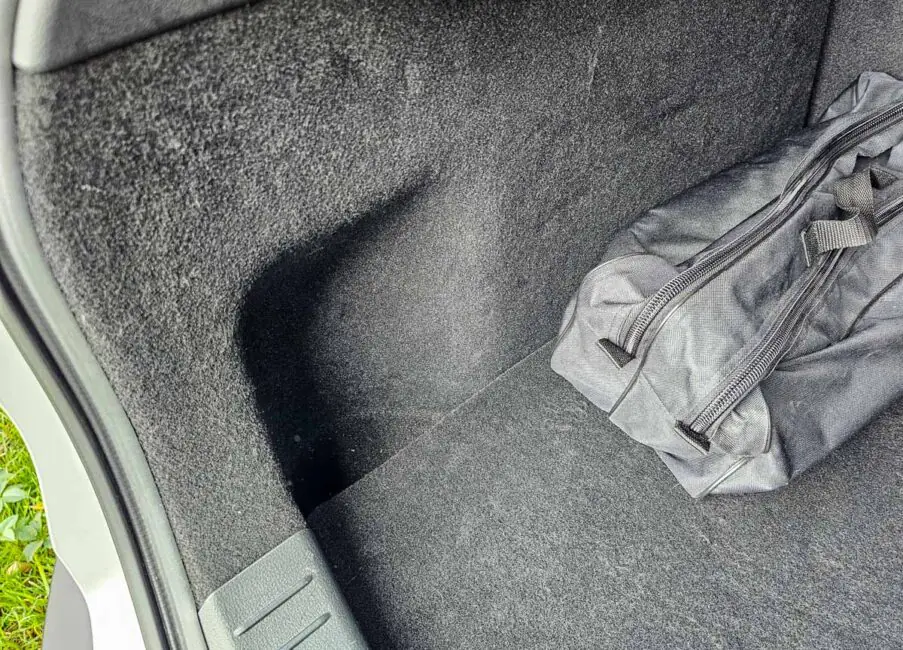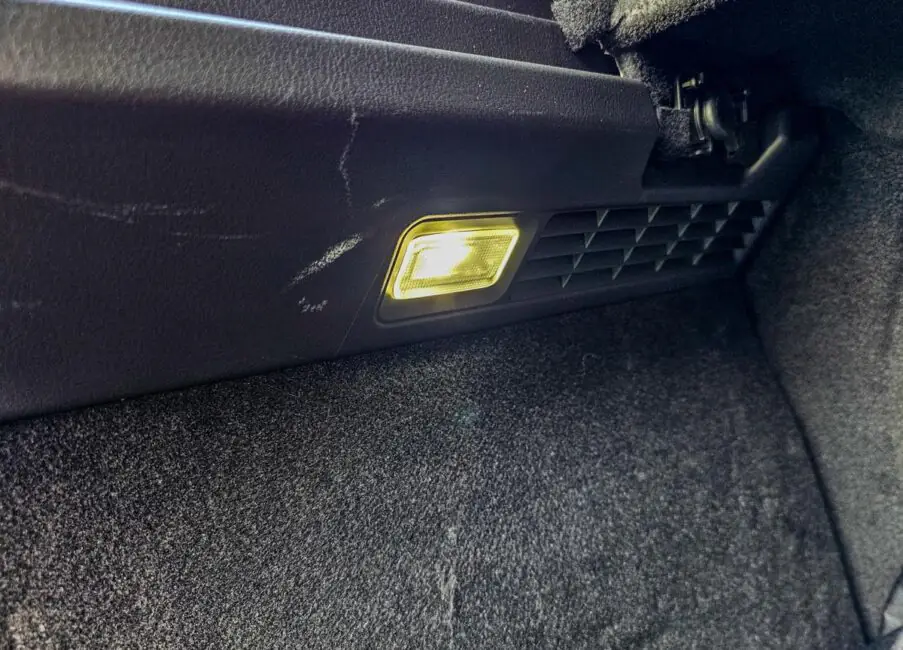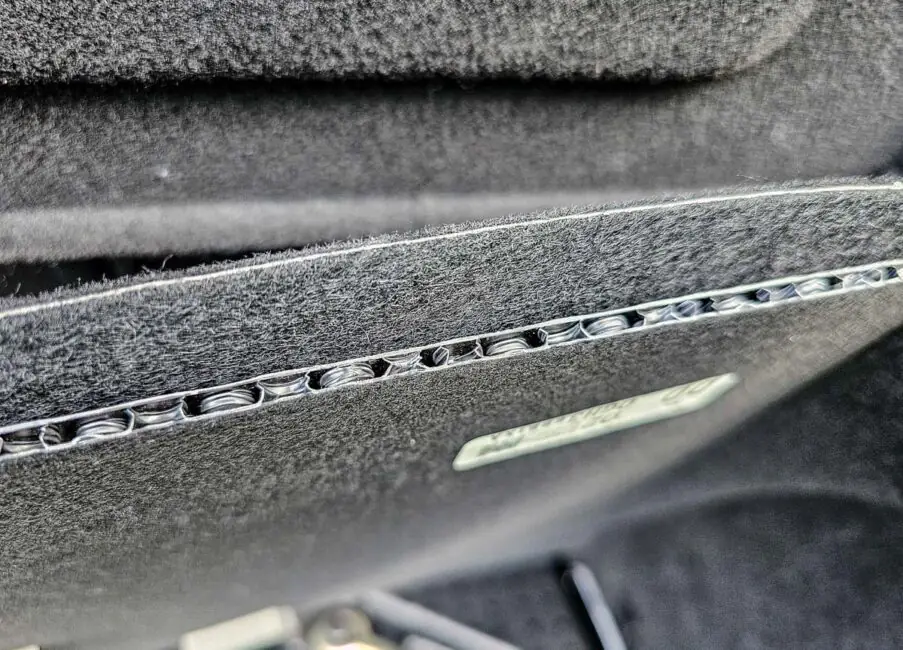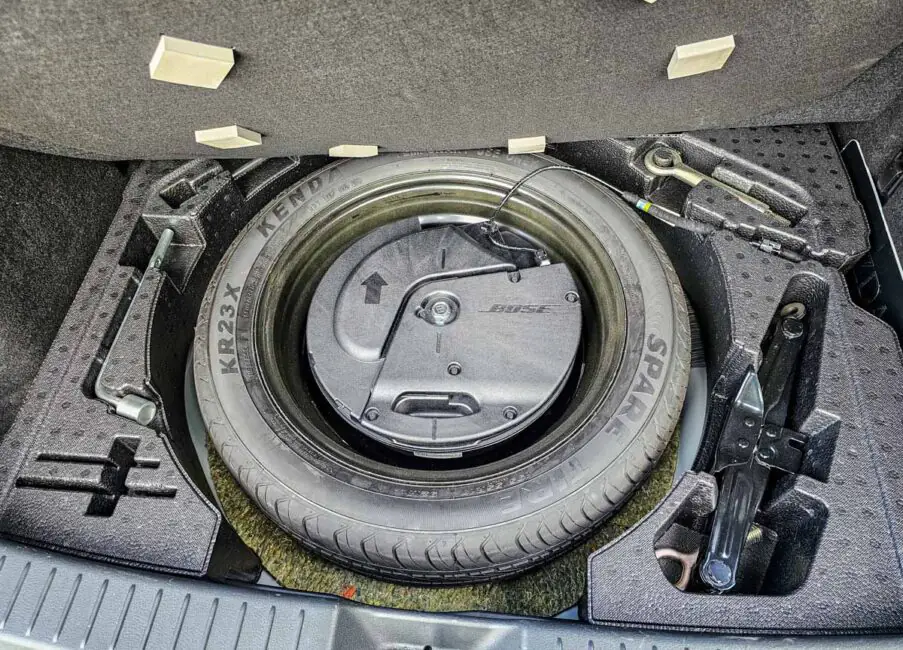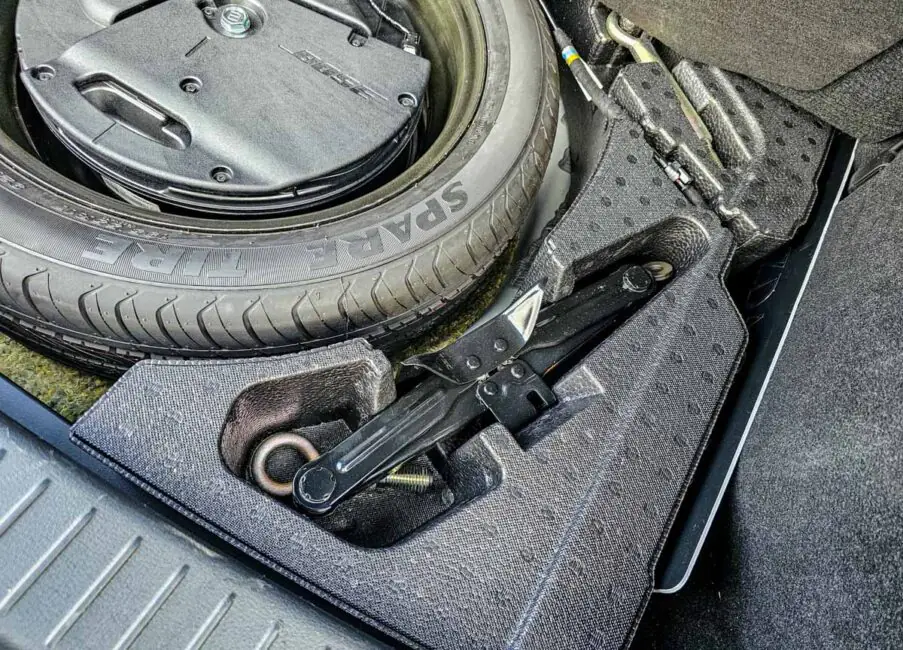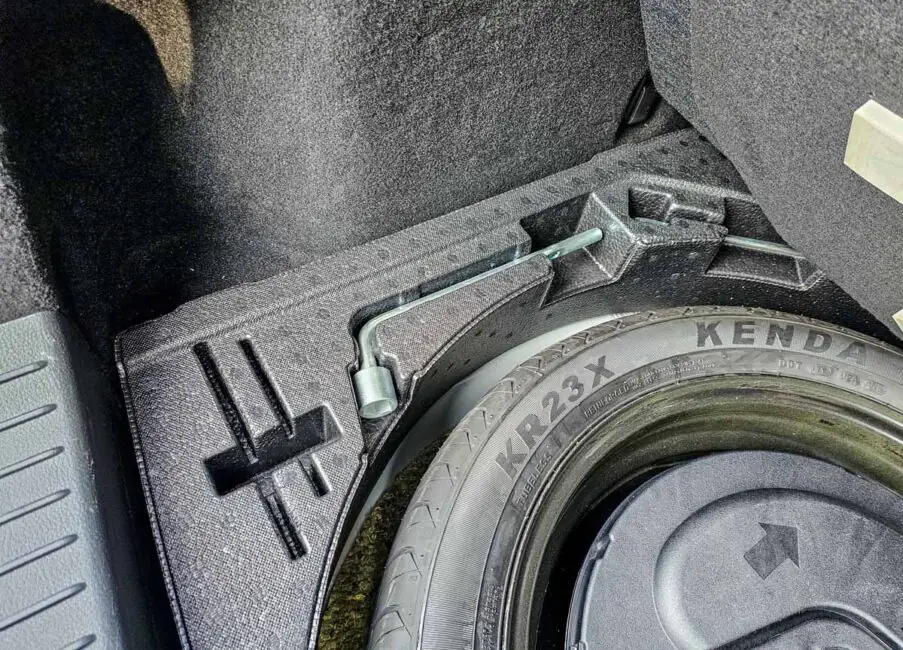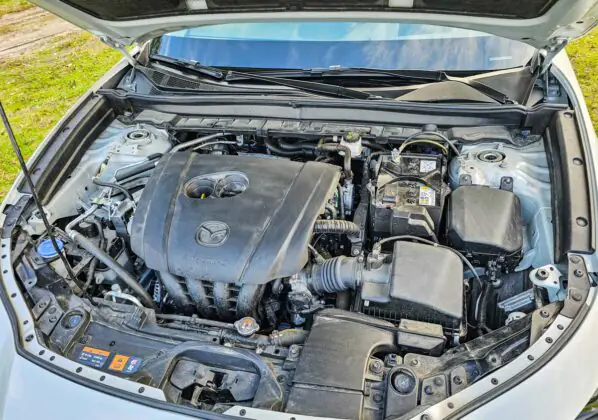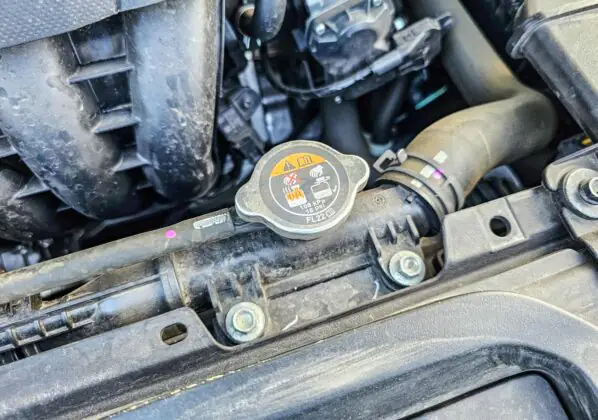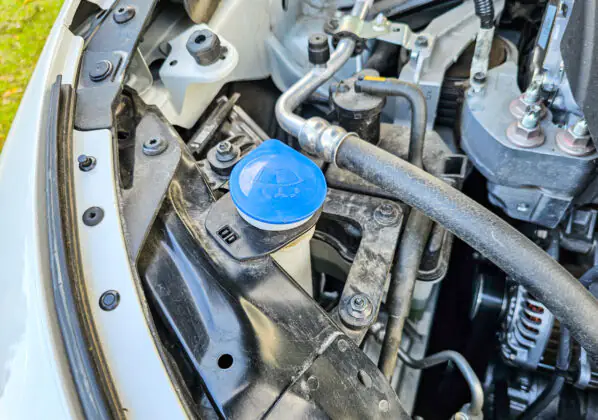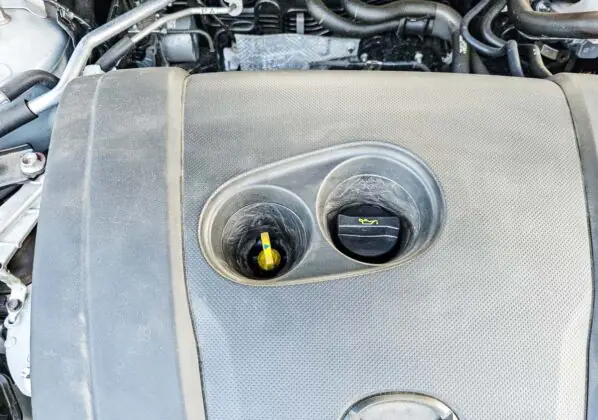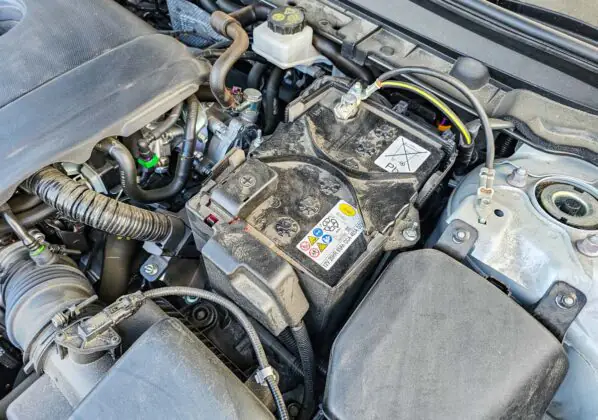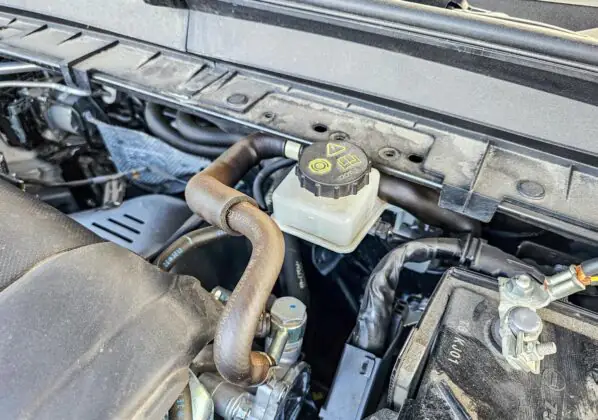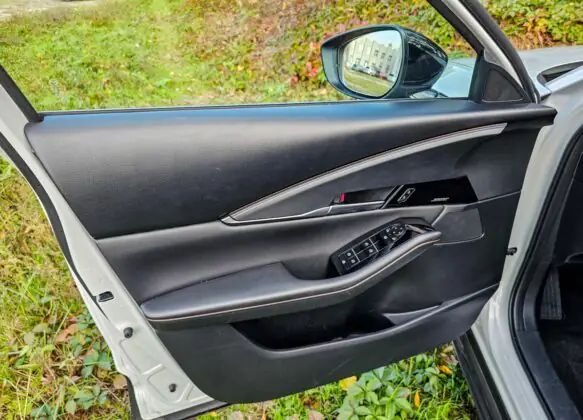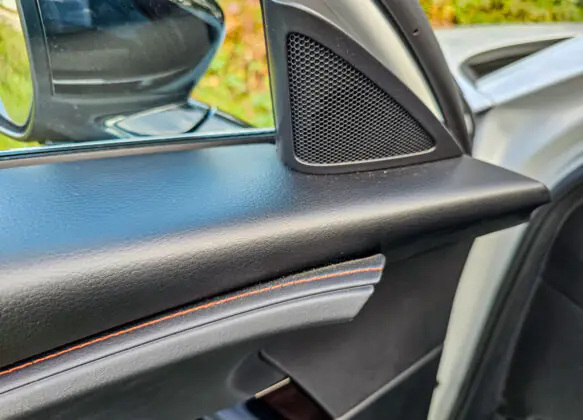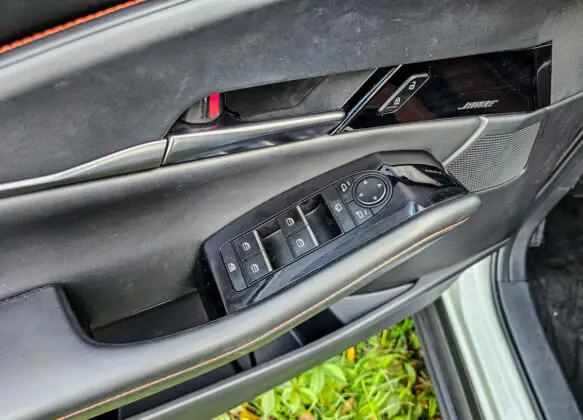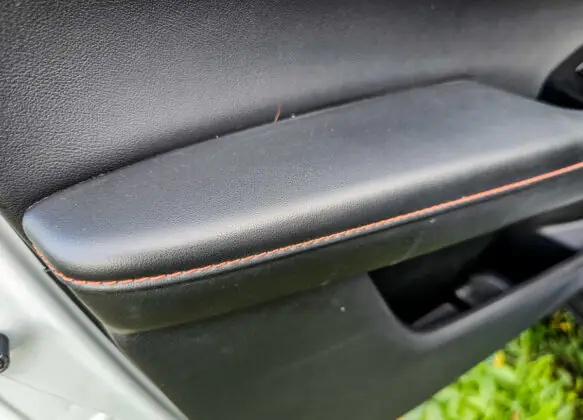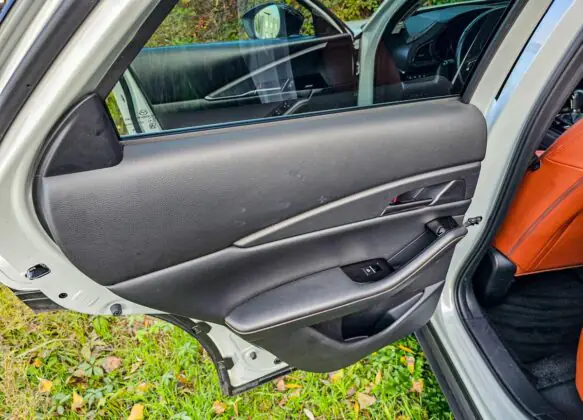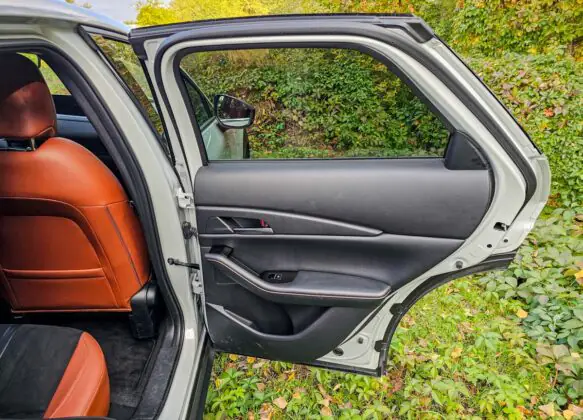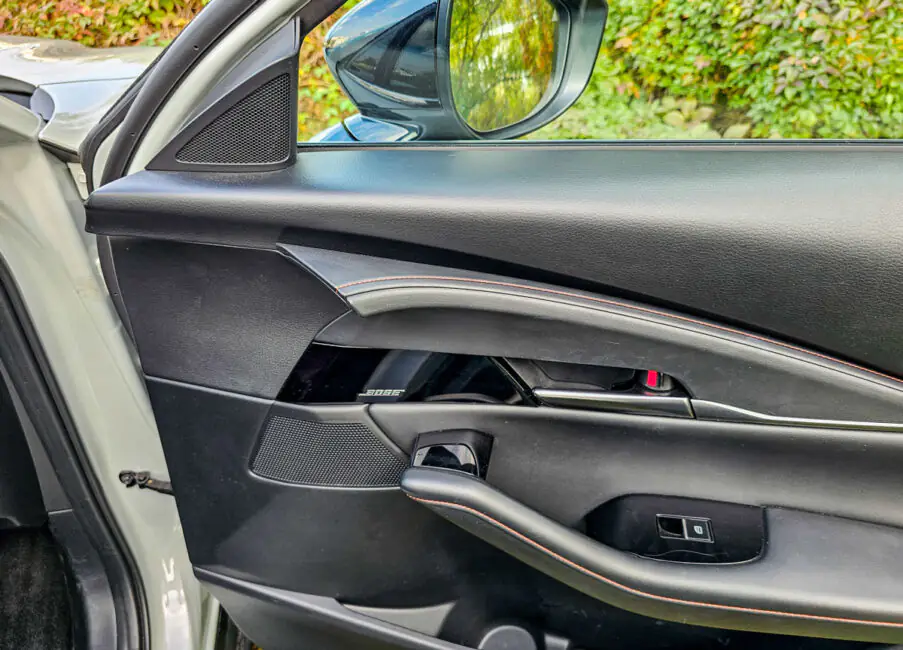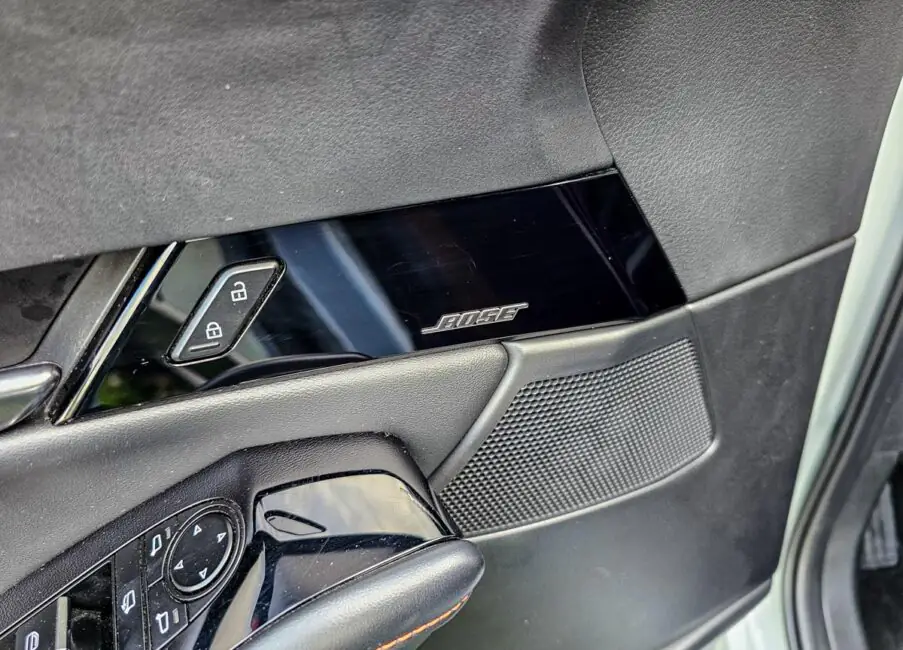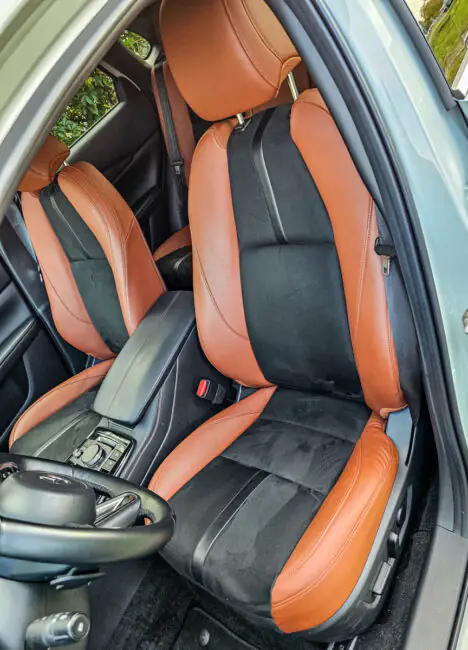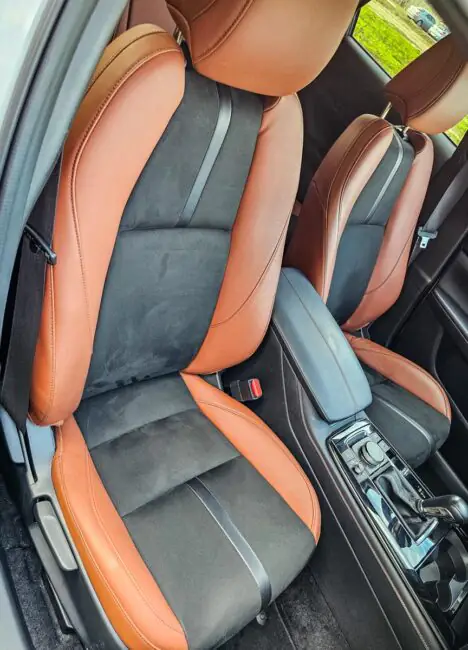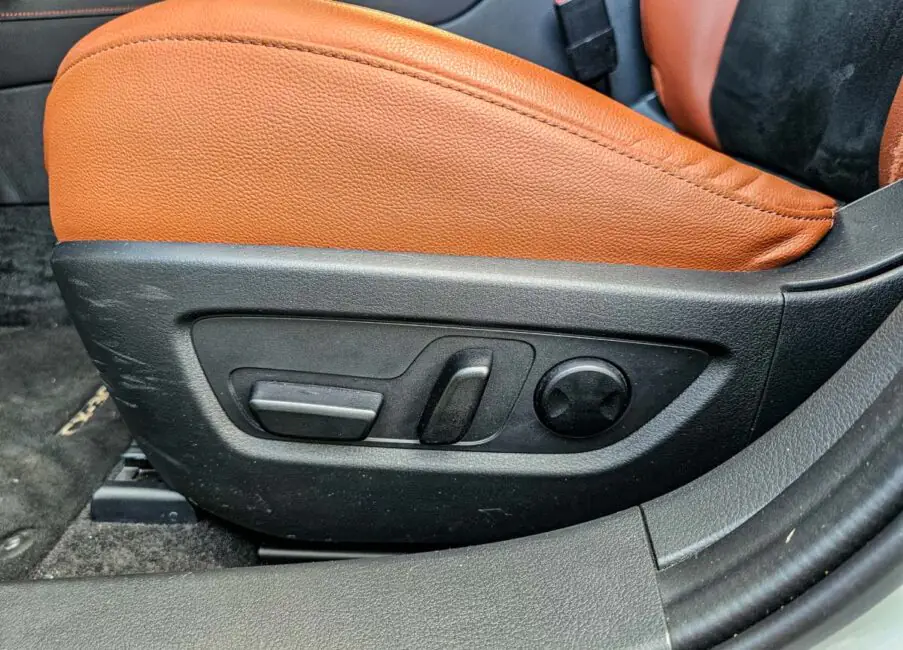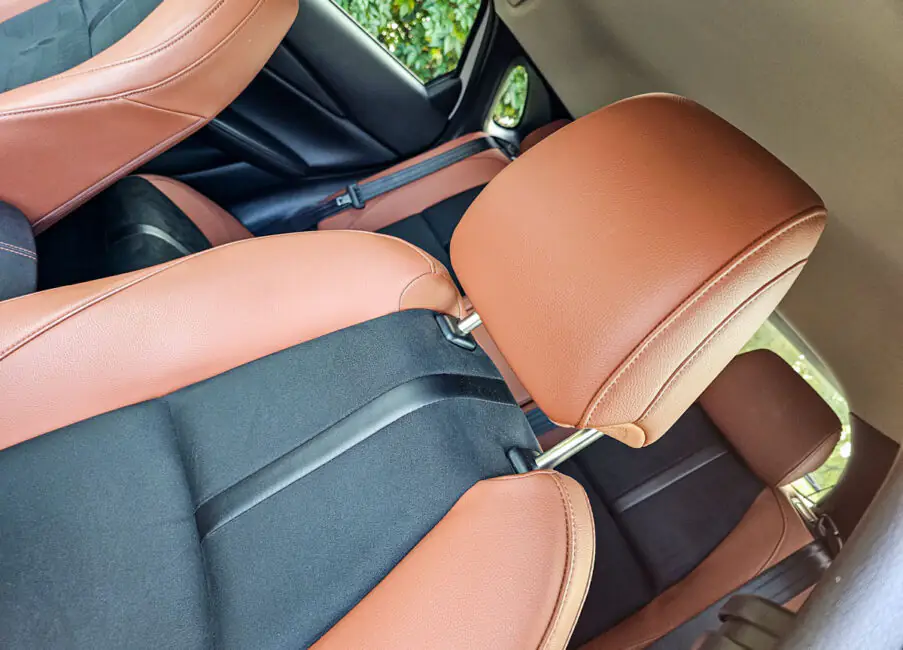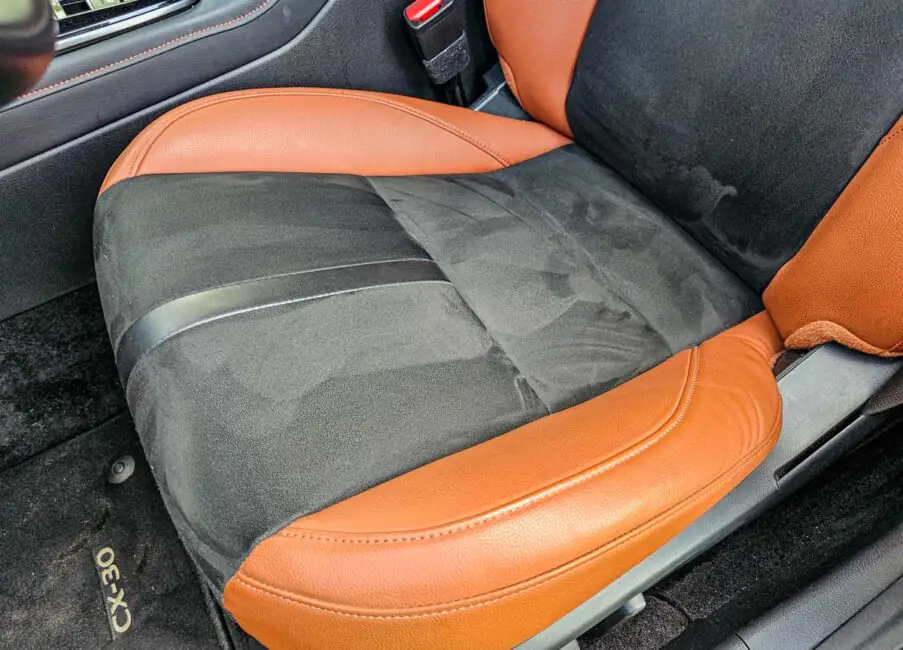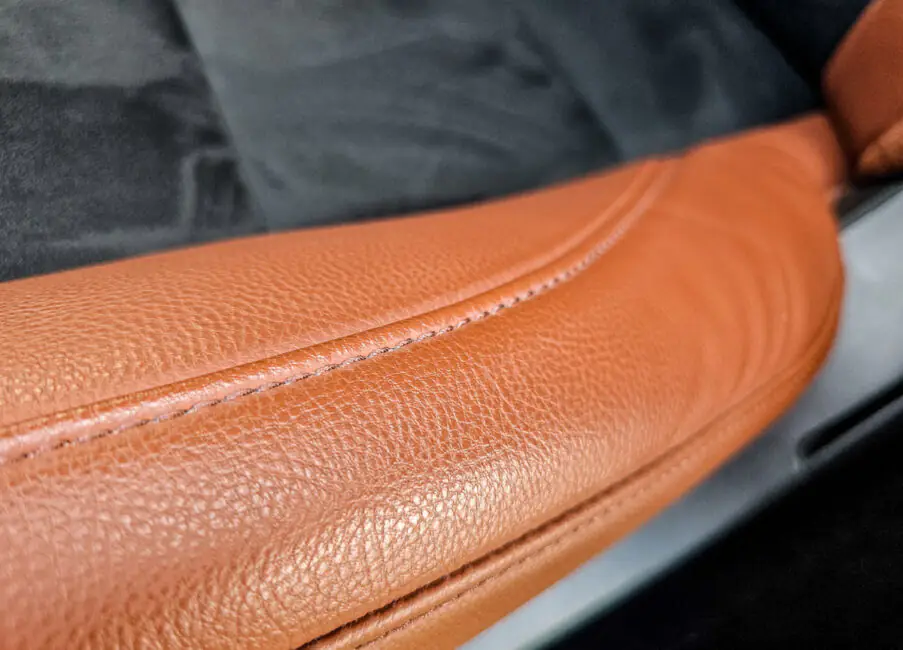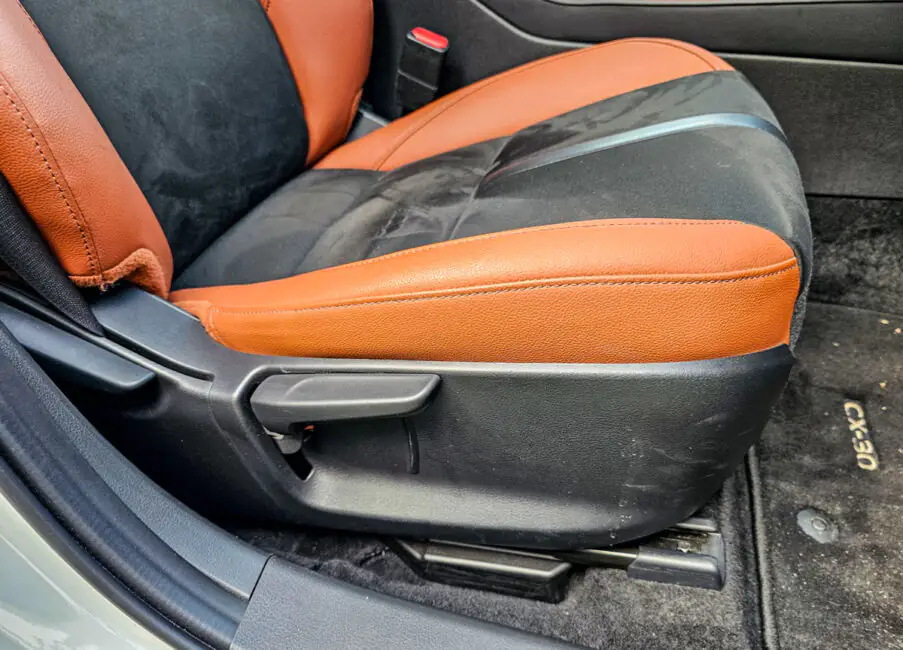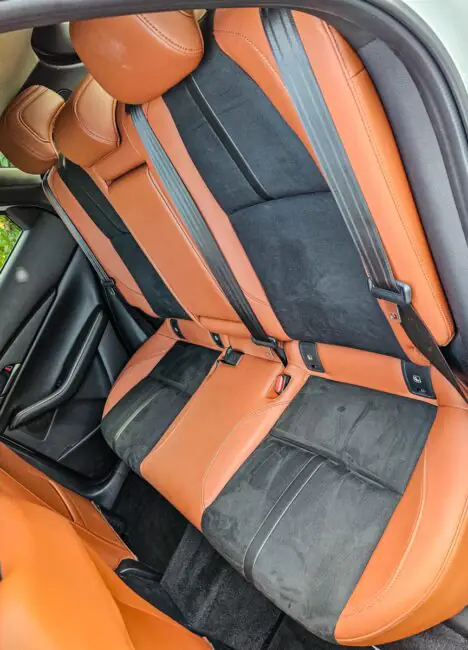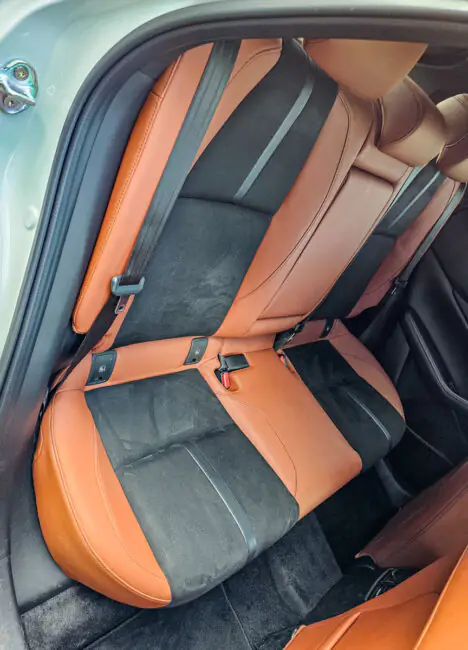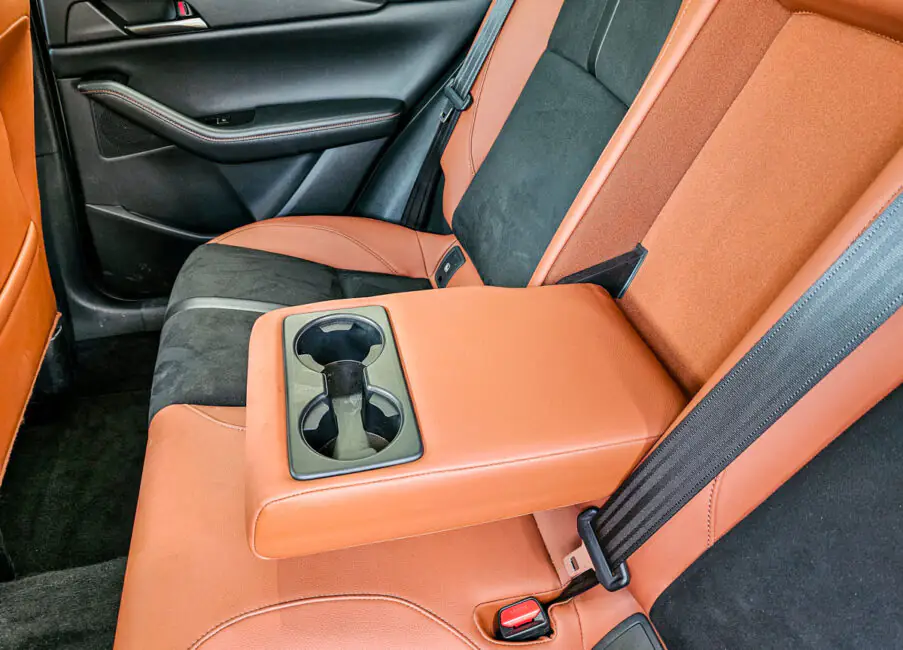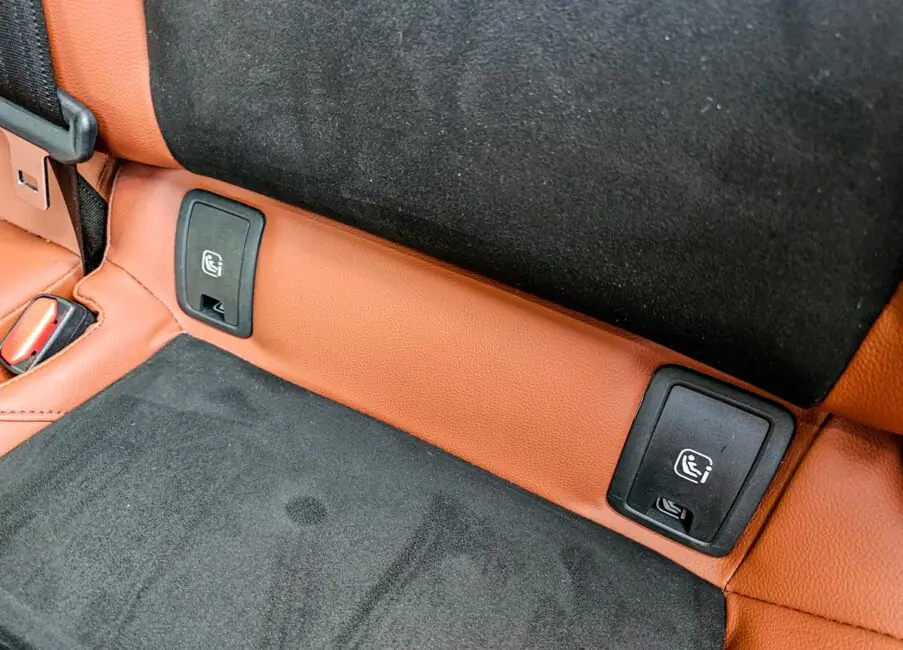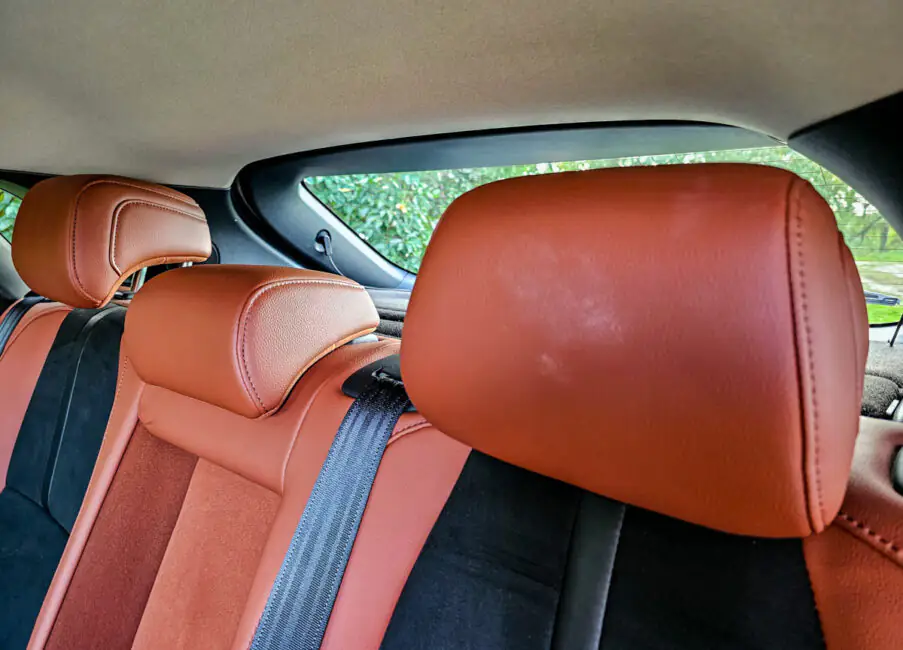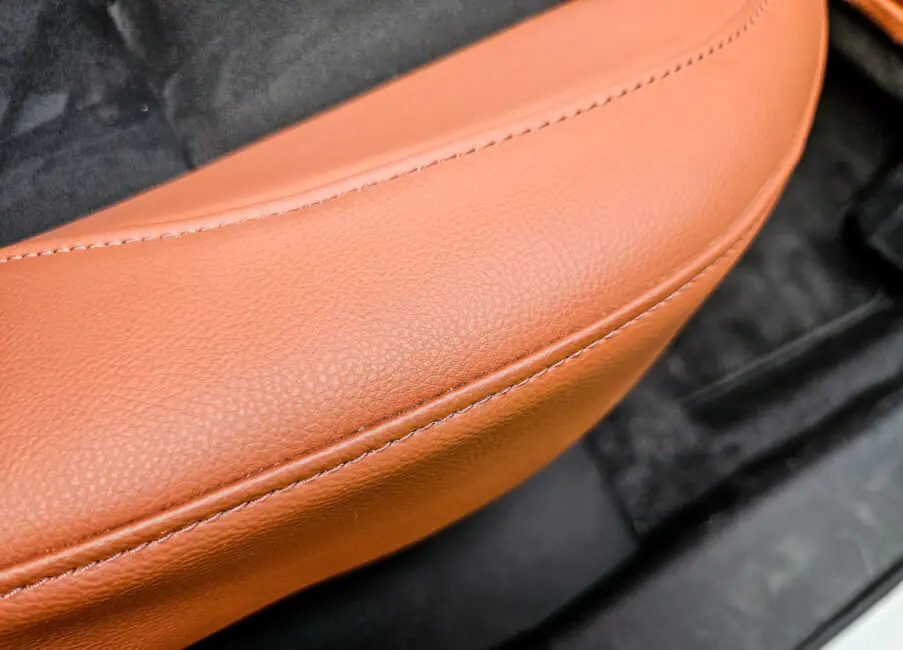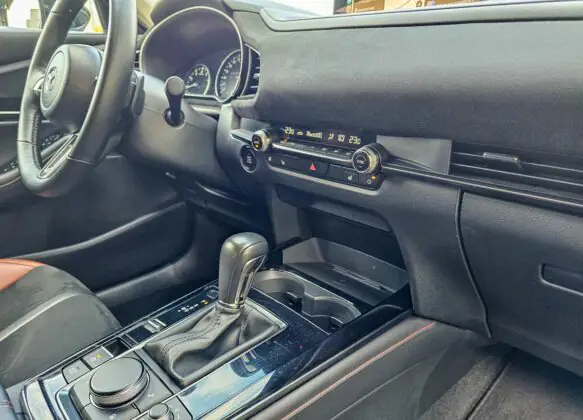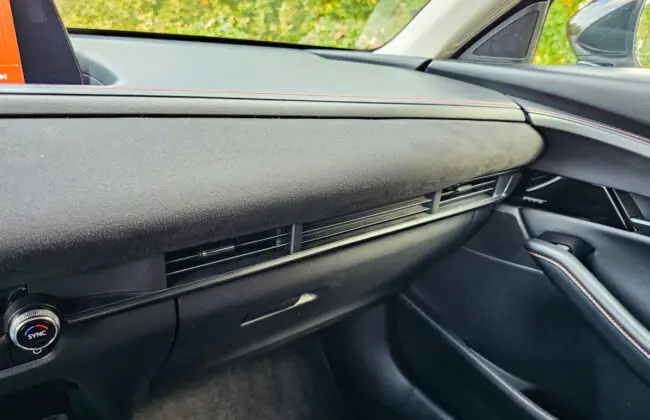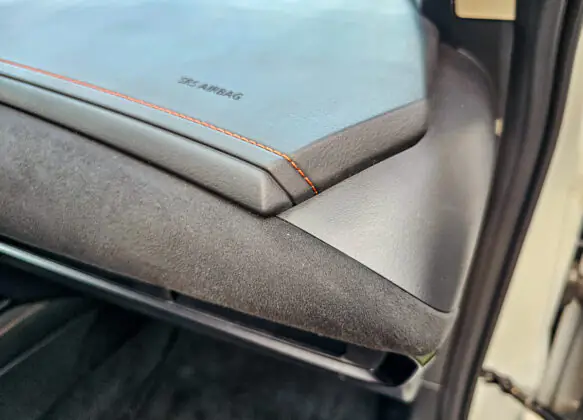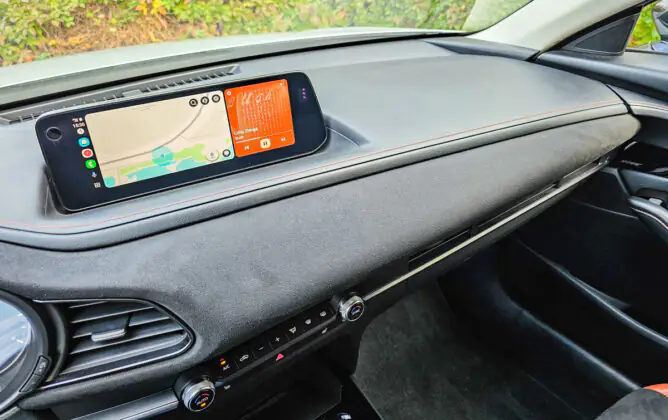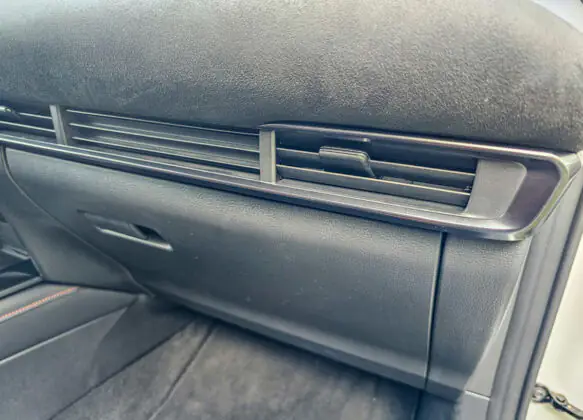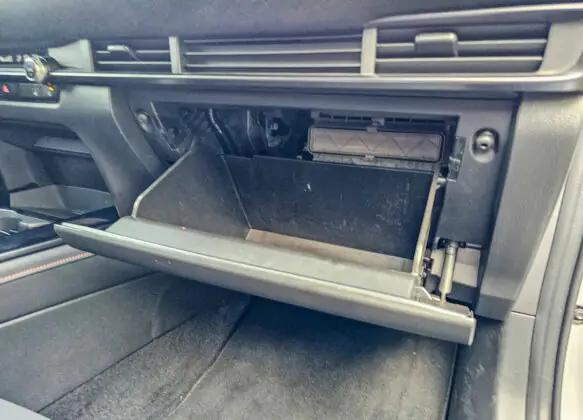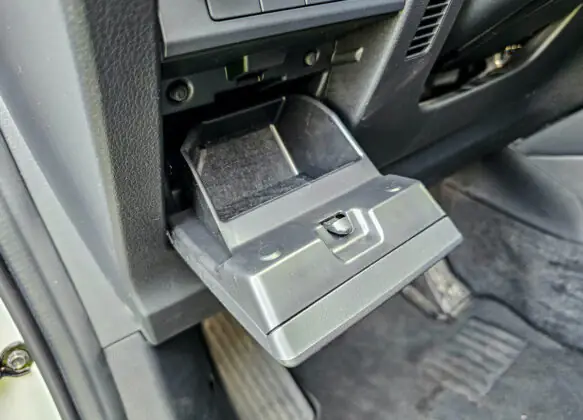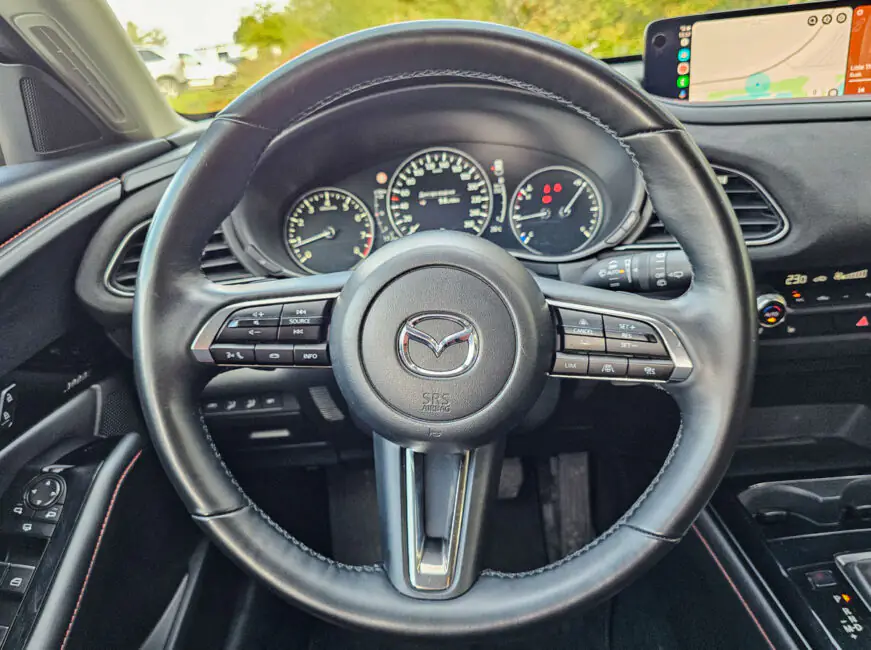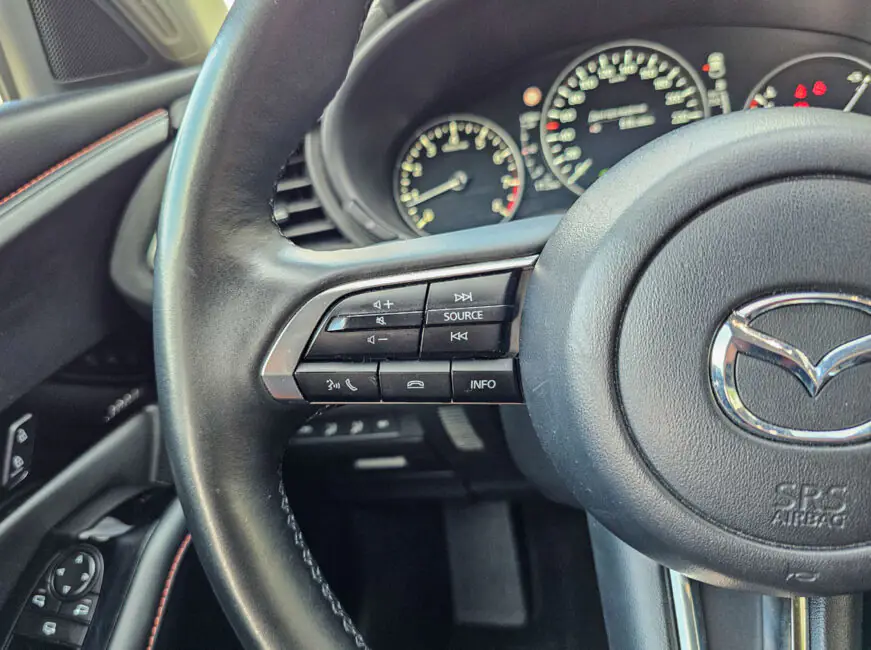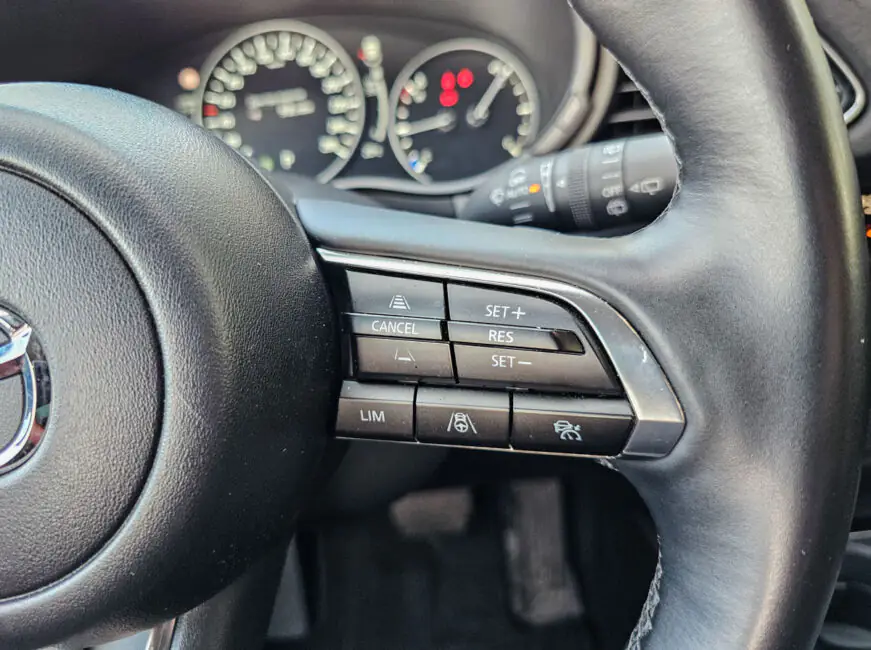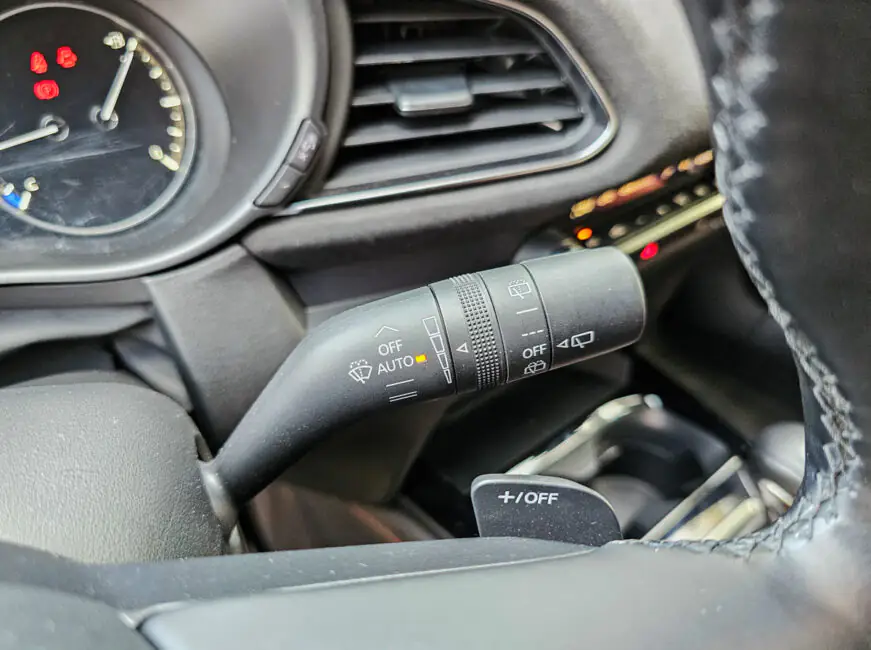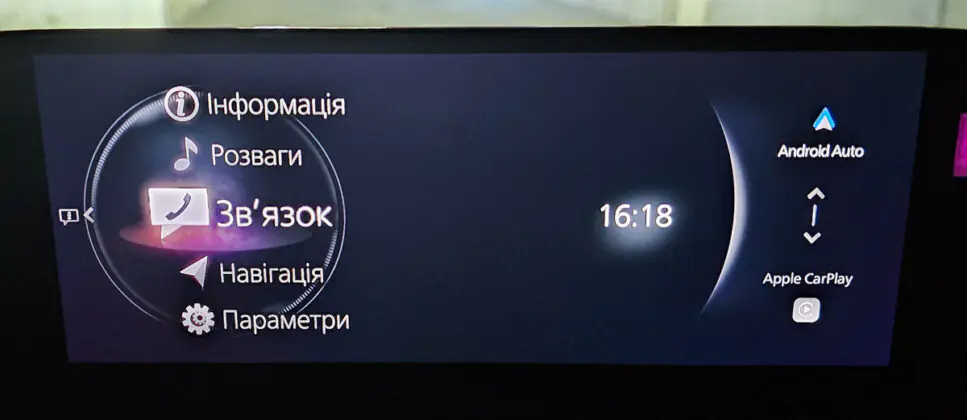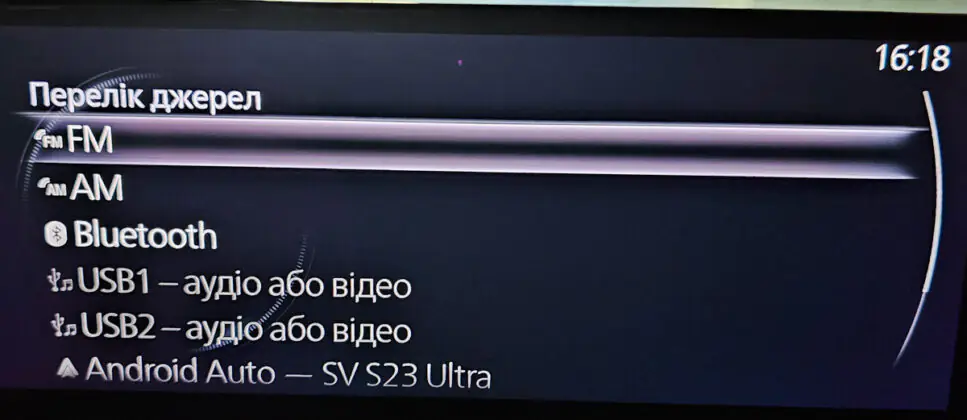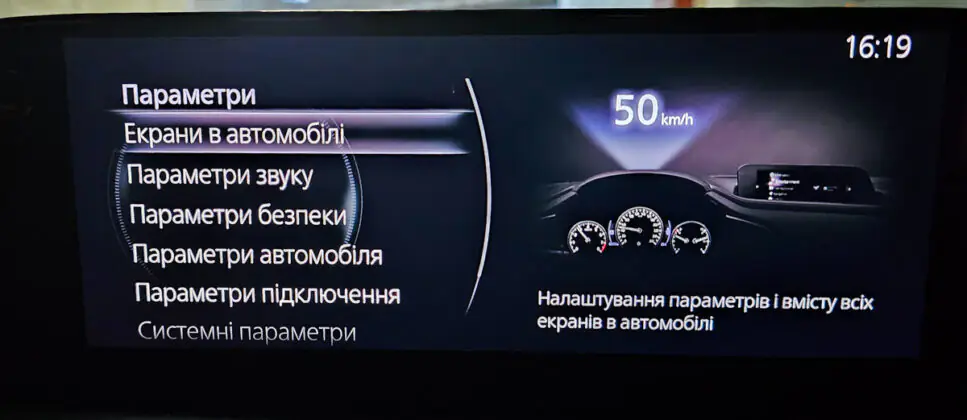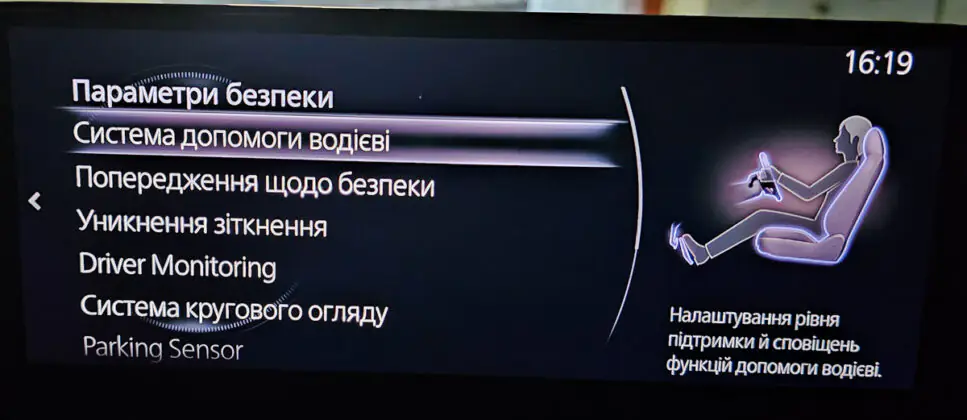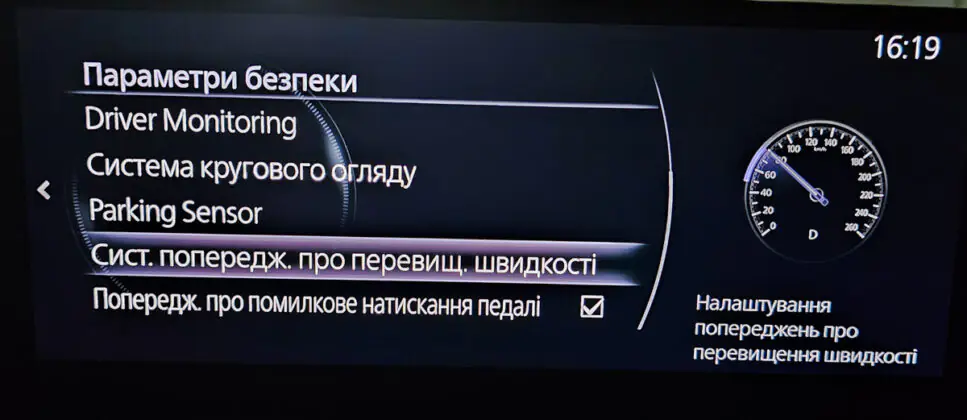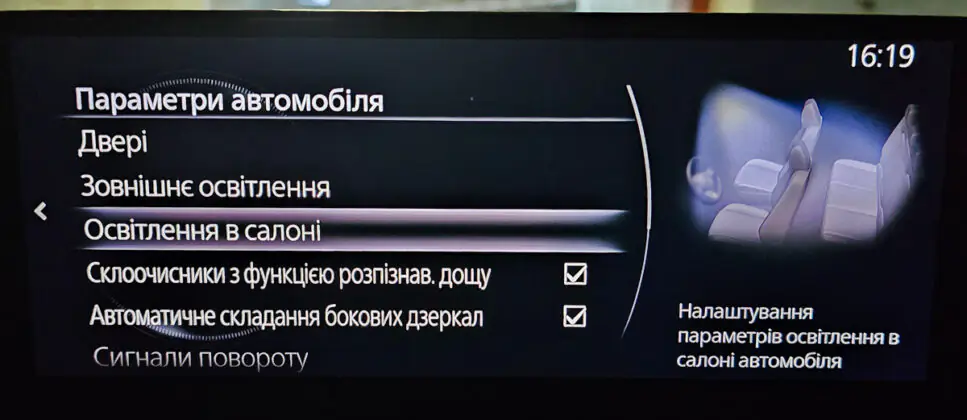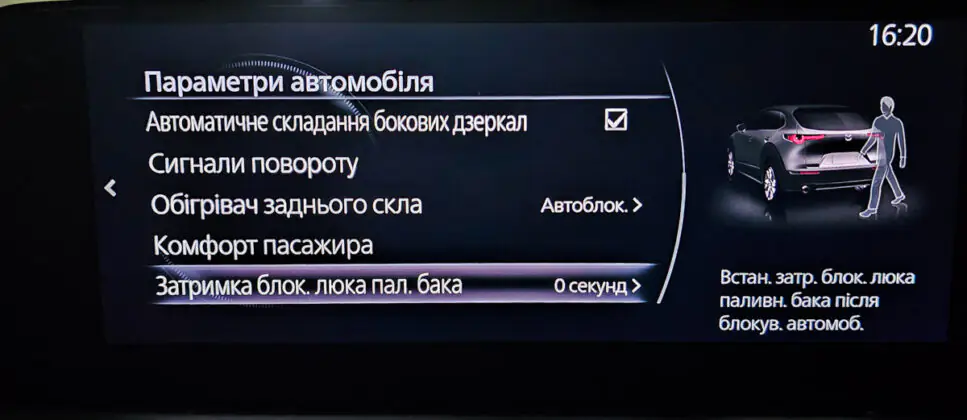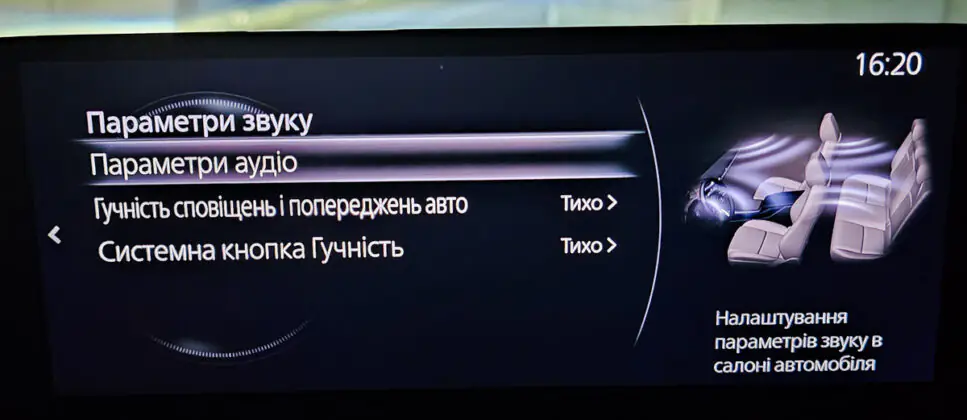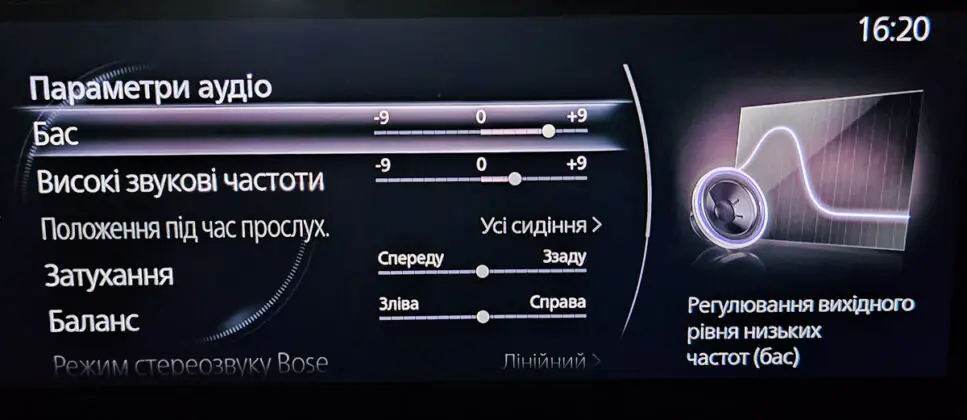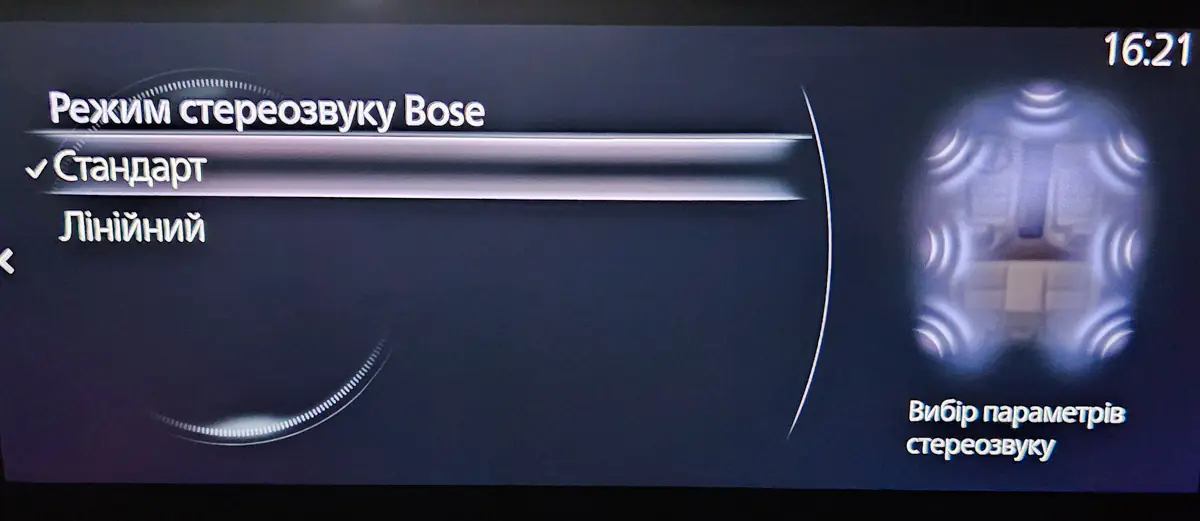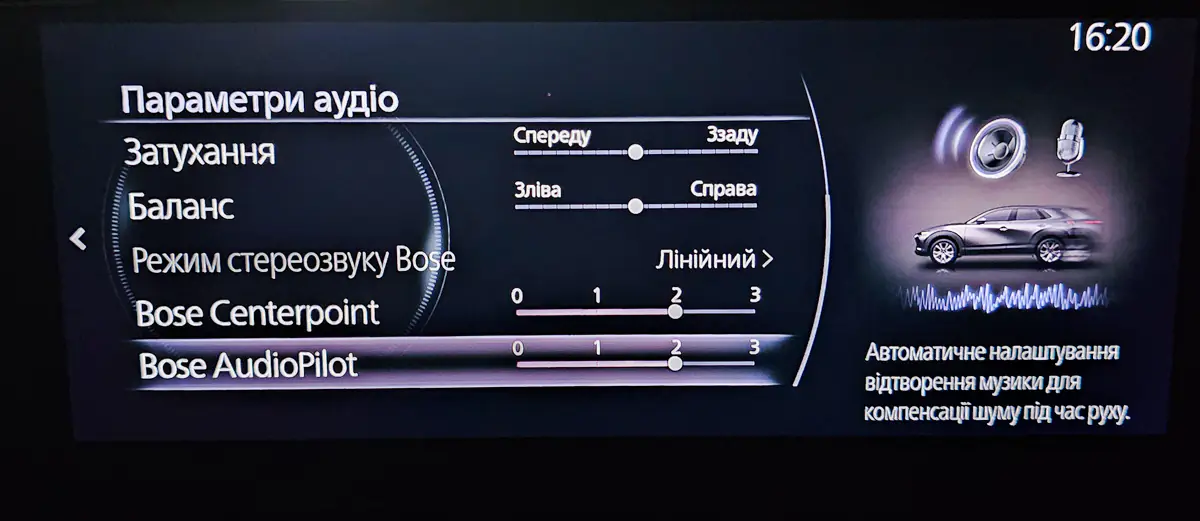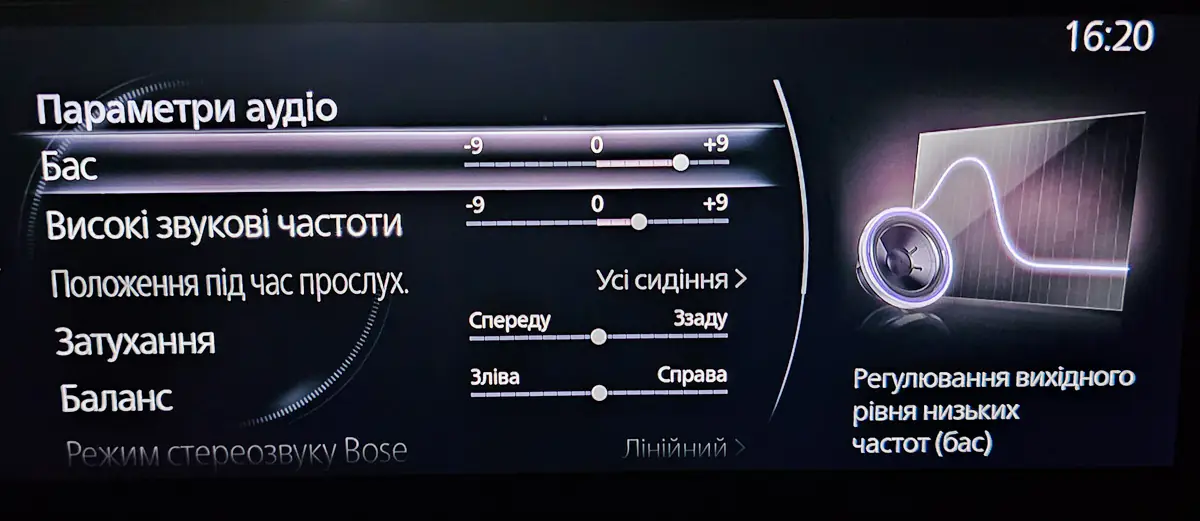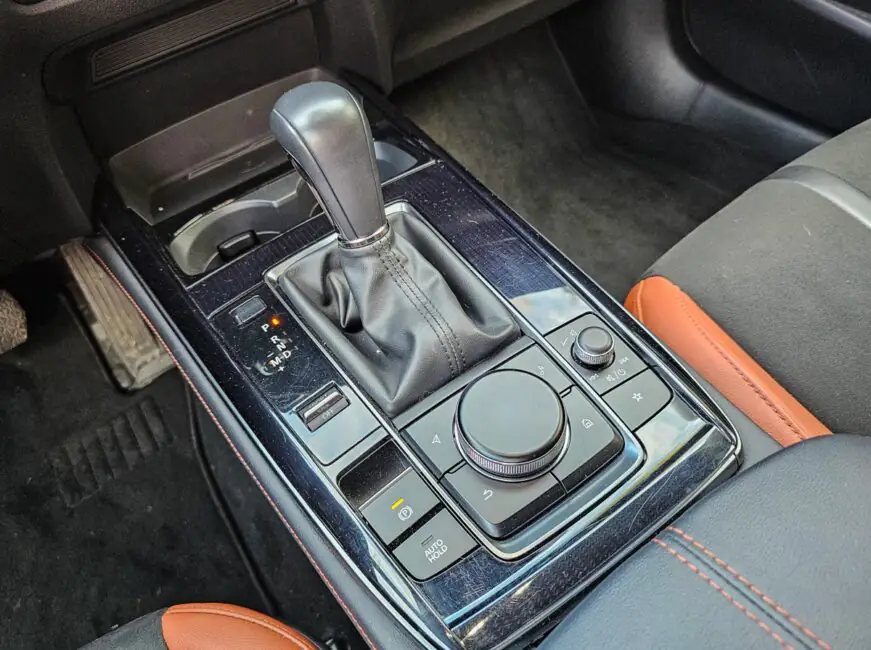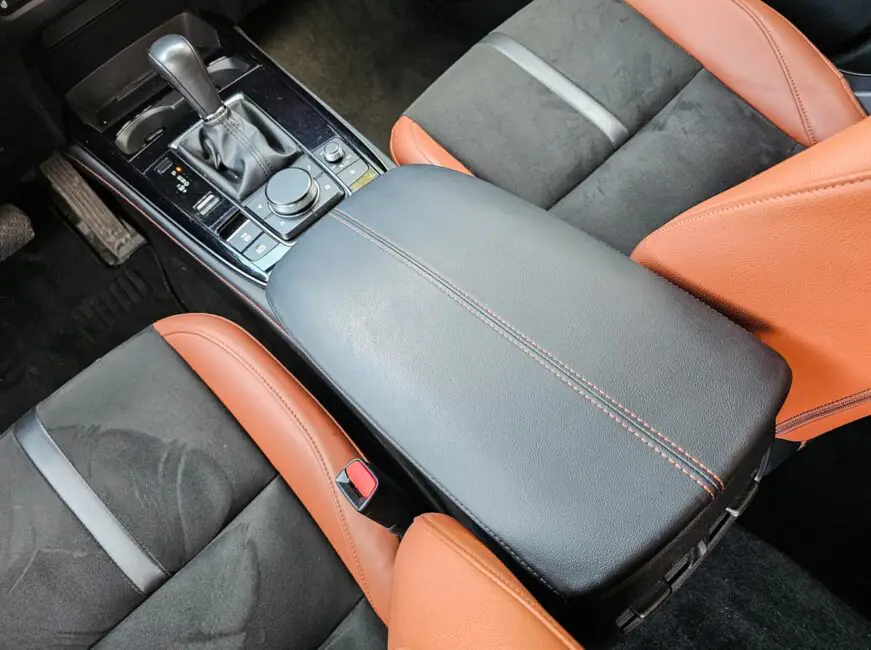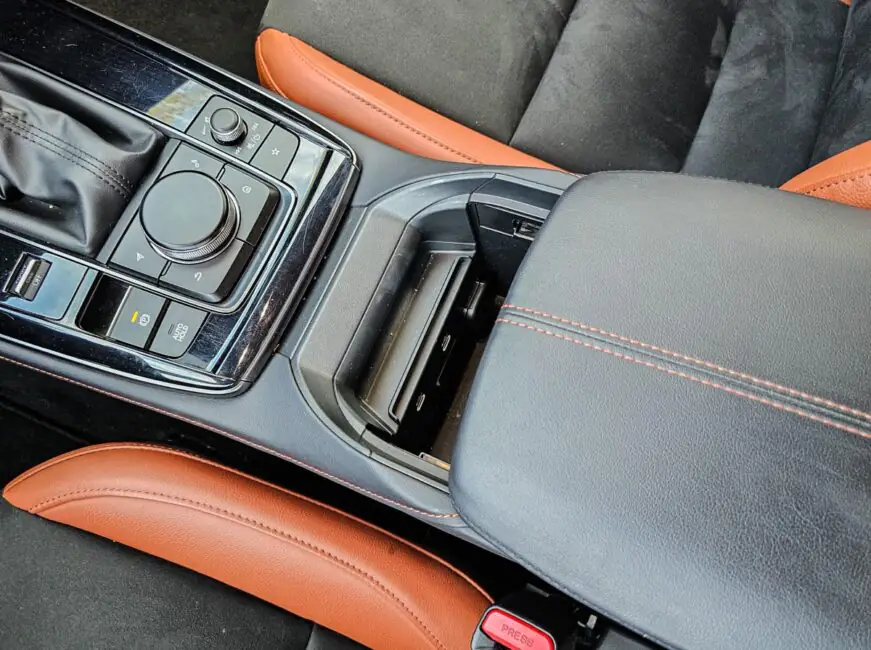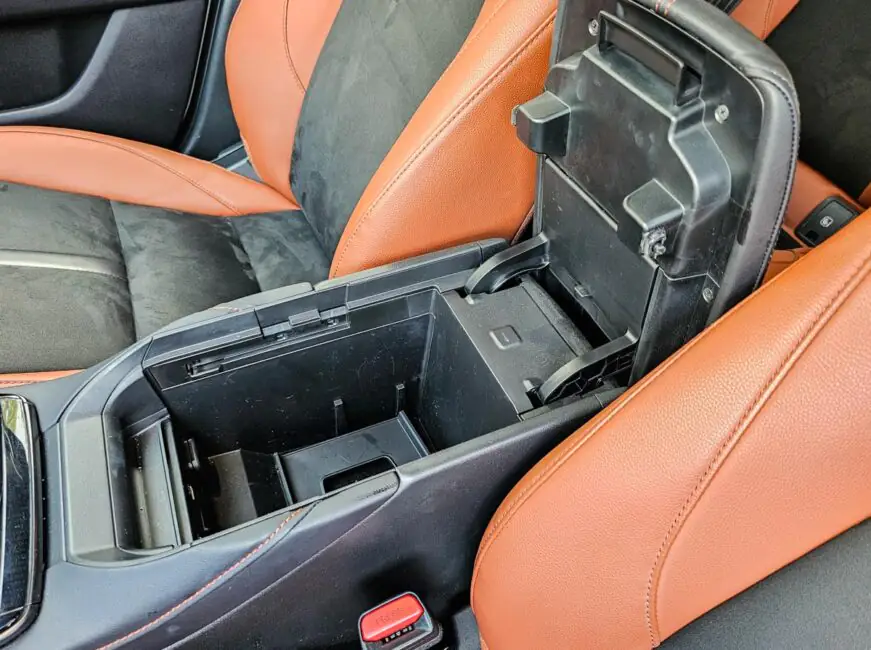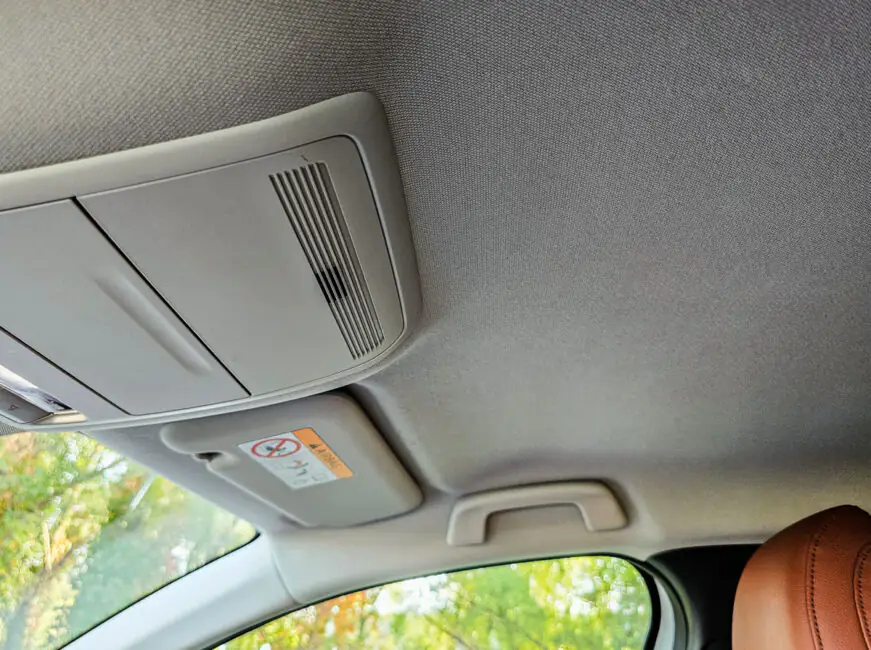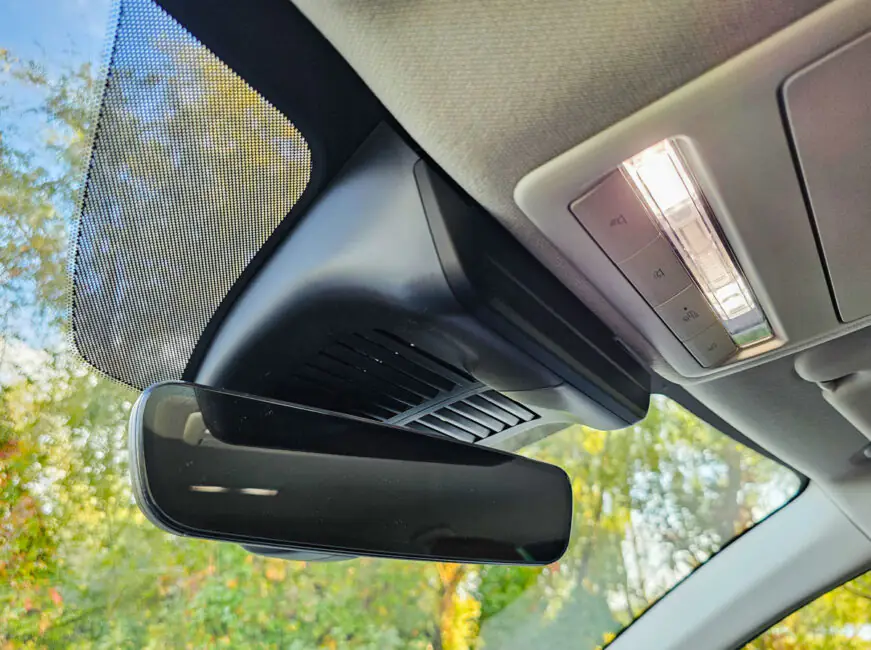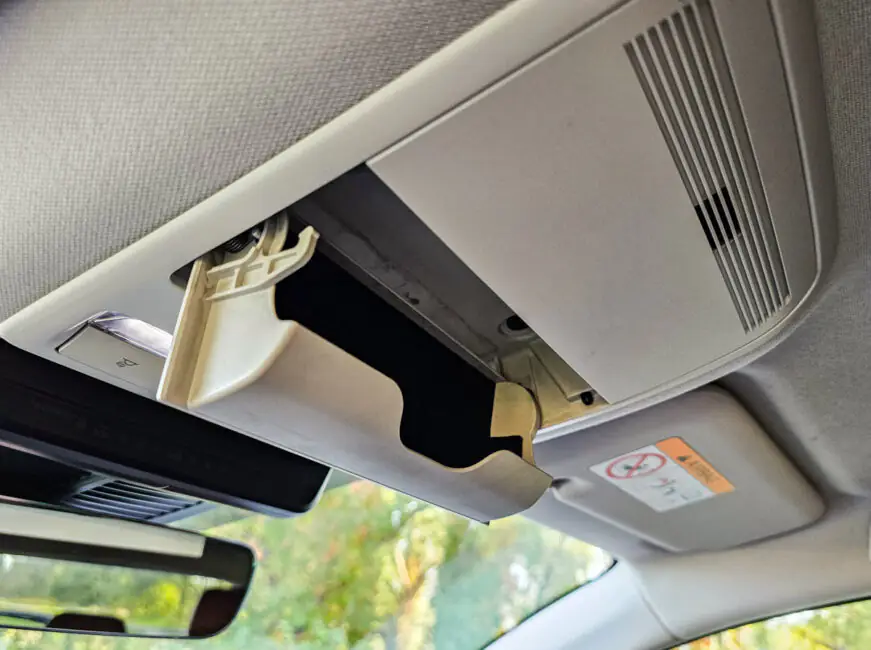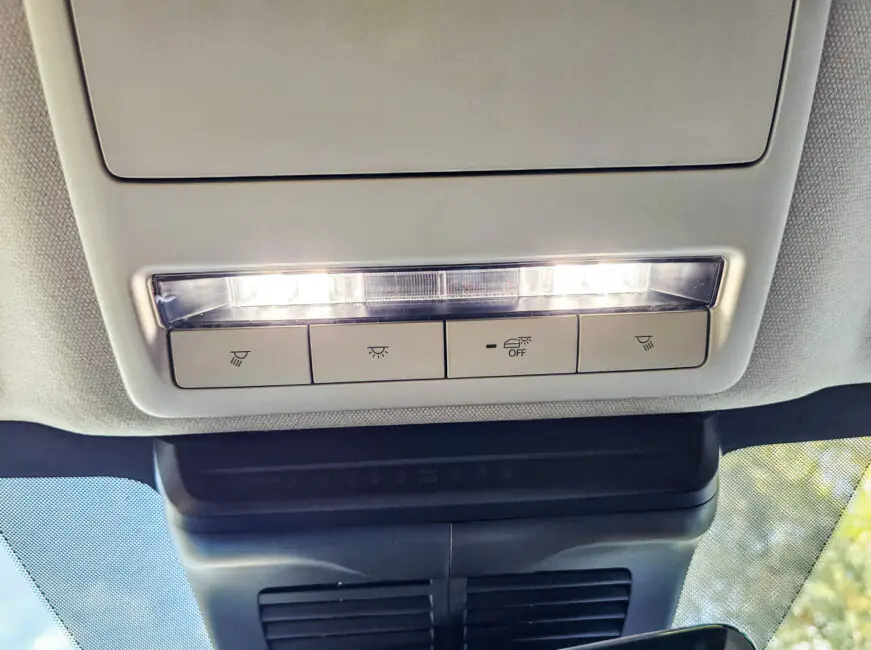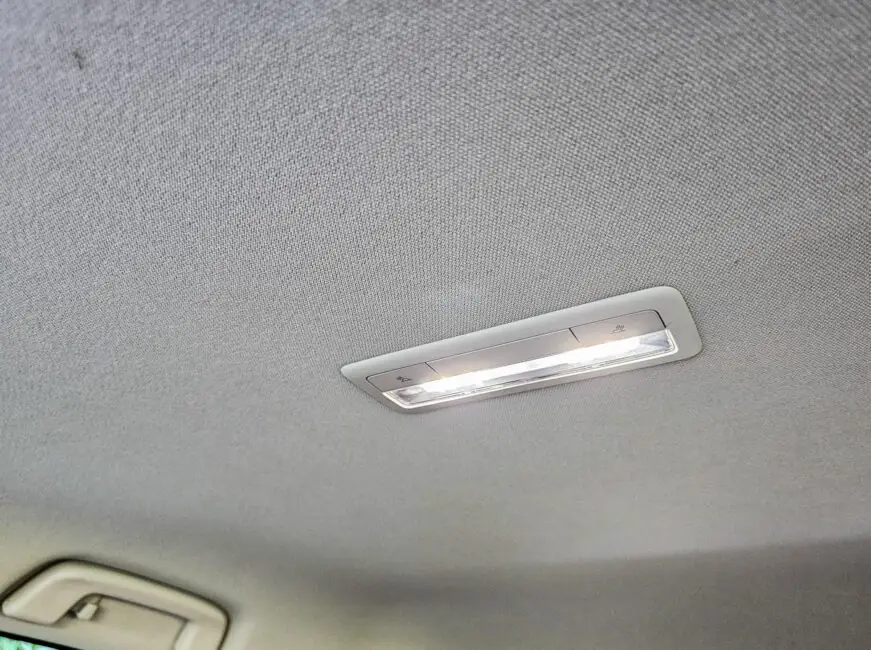© ROOT-NATION.com - Use of content is permitted with a backlink.
In the fall of 2024, I had the chance to test the compact crossover Mazda CX-30. I drove the car for a week, gathered my impressions, conducted tests, and took plenty of photos. However, I couldn’t quickly write the review at that time due to a heavy workload in my main business. But today, I finally have the time to gather my thoughts and share my experience with this rather interesting urban SUV. So, I apologize for the delay and let’s get started.
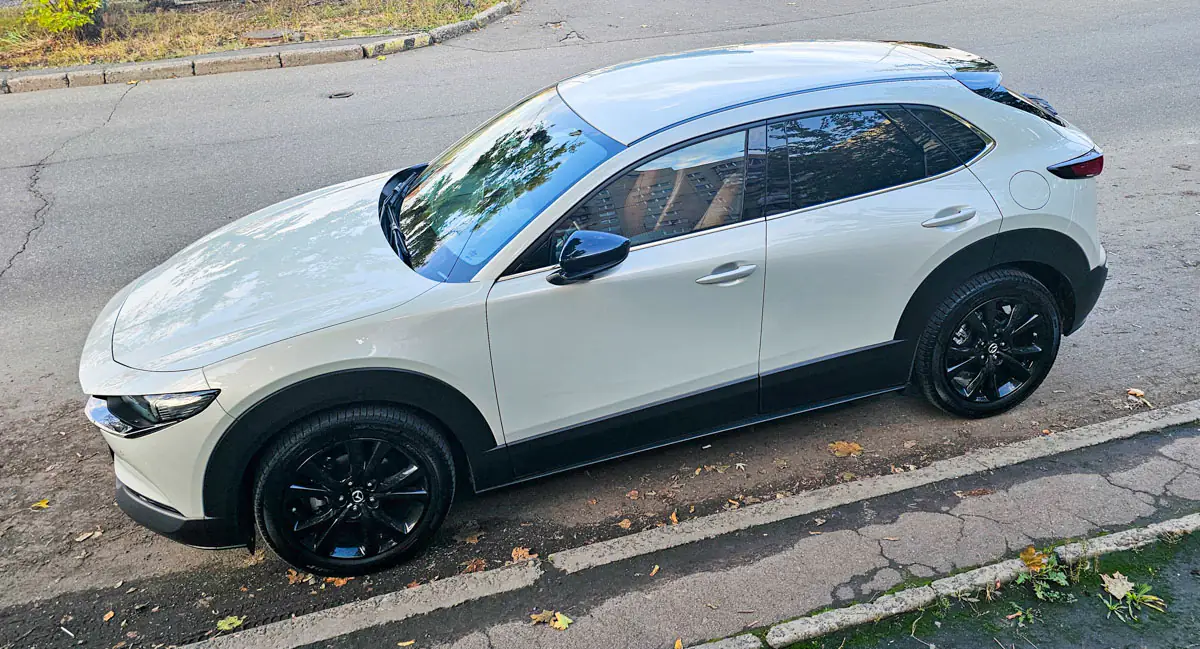
Mazda CX-30 positioning
The Mazda CX-30 is the smallest crossover in the brand’s lineup (until the potential release of the CX-20 later this year). As a result, it is the most affordable “crossover” SUV Mazda sells in Ukraine. However, despite this, I didn’t get the feeling of driving a cheap car—in fact, quite the opposite (but more on that later). As for my brief experience as a car tester, I’ve already had the chance to drive cars of similar size and in the $35,000 price range, such as the Škoda Karoq and Mitsubishi Eclipse Cross, so I have a solid basis for comparison.
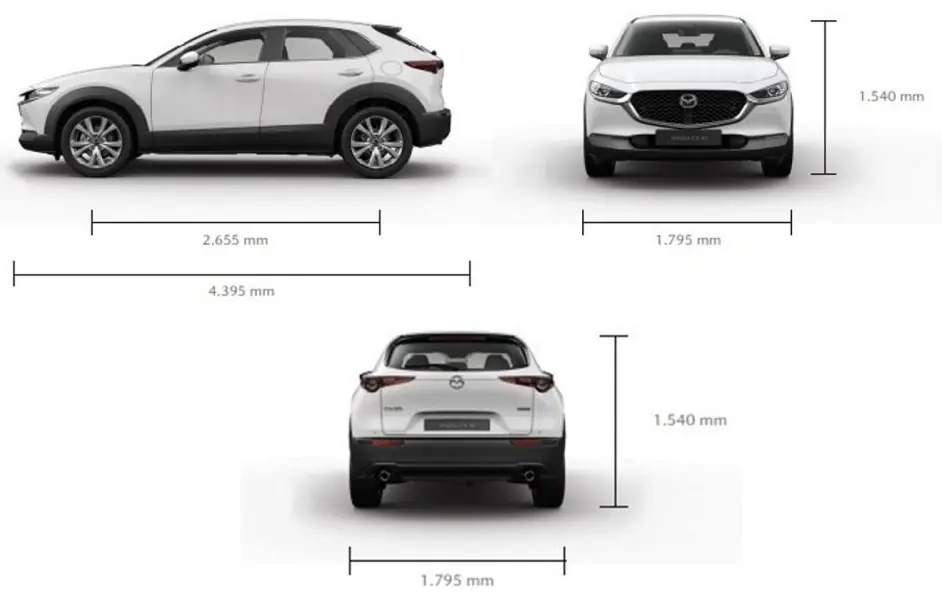
I’d also like to remind you that I’ve previously reviewed the Mazda CX-60, so I’m somewhat familiar with the brand’s lineup. This gives me the opportunity to compare different models from the same manufacturer, which I’ll definitely make use of during this review.
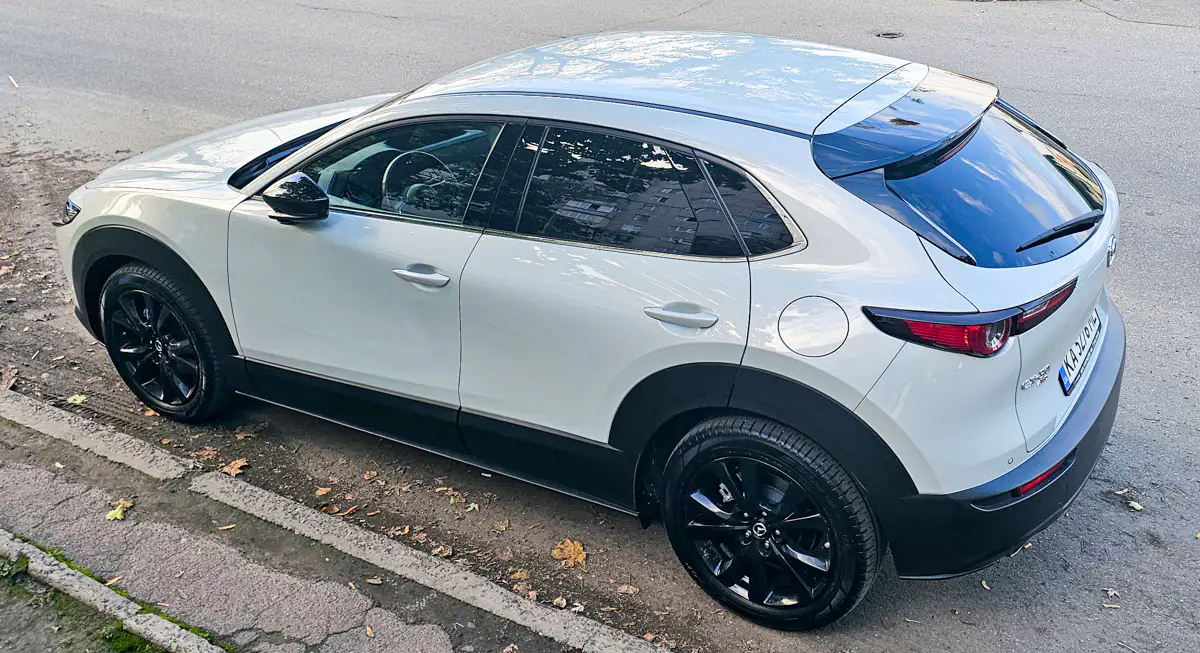
Read also: Mazda CX-60 Premium-Sport Review: Not Enough Premium Quality, But Too Much Sport
Exterior
Mazda CX-30 design
The Mazda CX-30 is a very beautiful car, at least in my opinion—practically flawless in its exterior design and striking from every angle. Once again, it follows Mazda’s signature styling, which is consistent across all modern models, but it’s clear that the CX-30 is based on the Mazda 3 hatchback. This makes it slightly different from the CX-60 and CX-90, which have a more distinctive look, especially at the front.
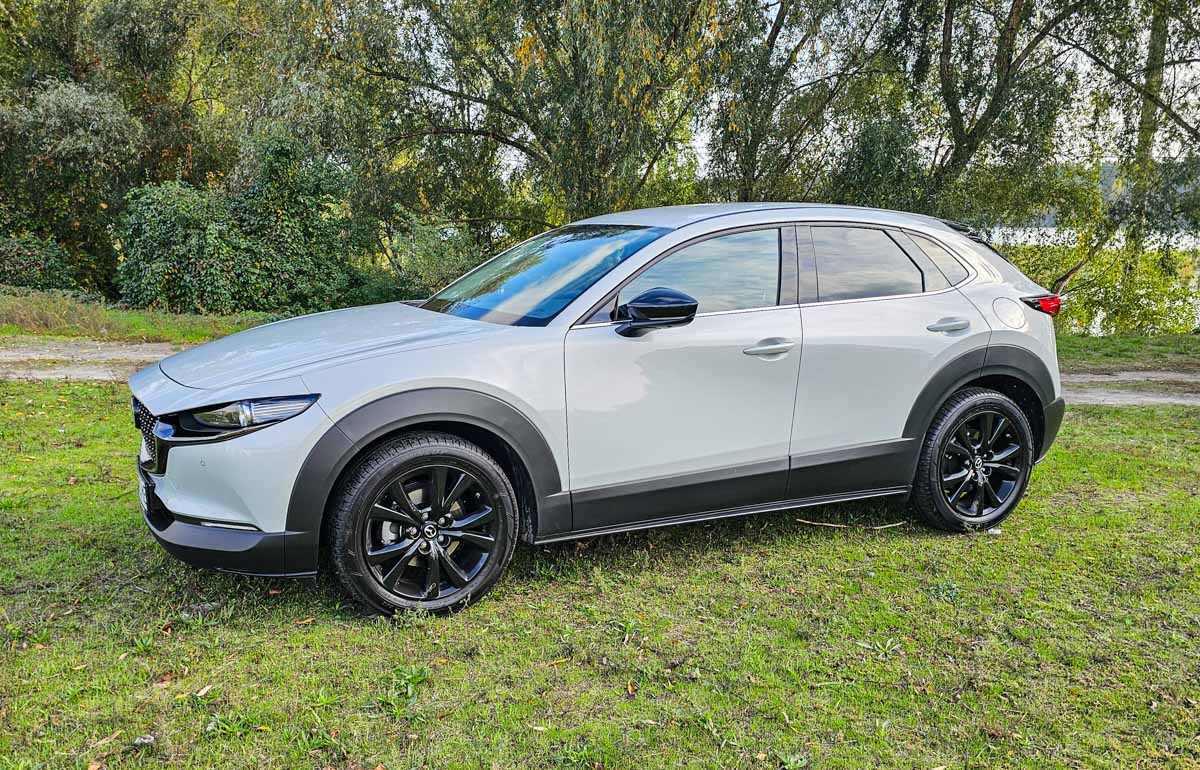
It’s worth noting that the version I tested was the Mazda CX-30 SPORT BLACK—essentially the top-tier trim. The main difference from the slightly more expensive PREMIUM version is the black styling on certain exterior elements. This includes glossy black side mirror housings instead of body-colored ones and a black grille frame instead of a chrome finish.
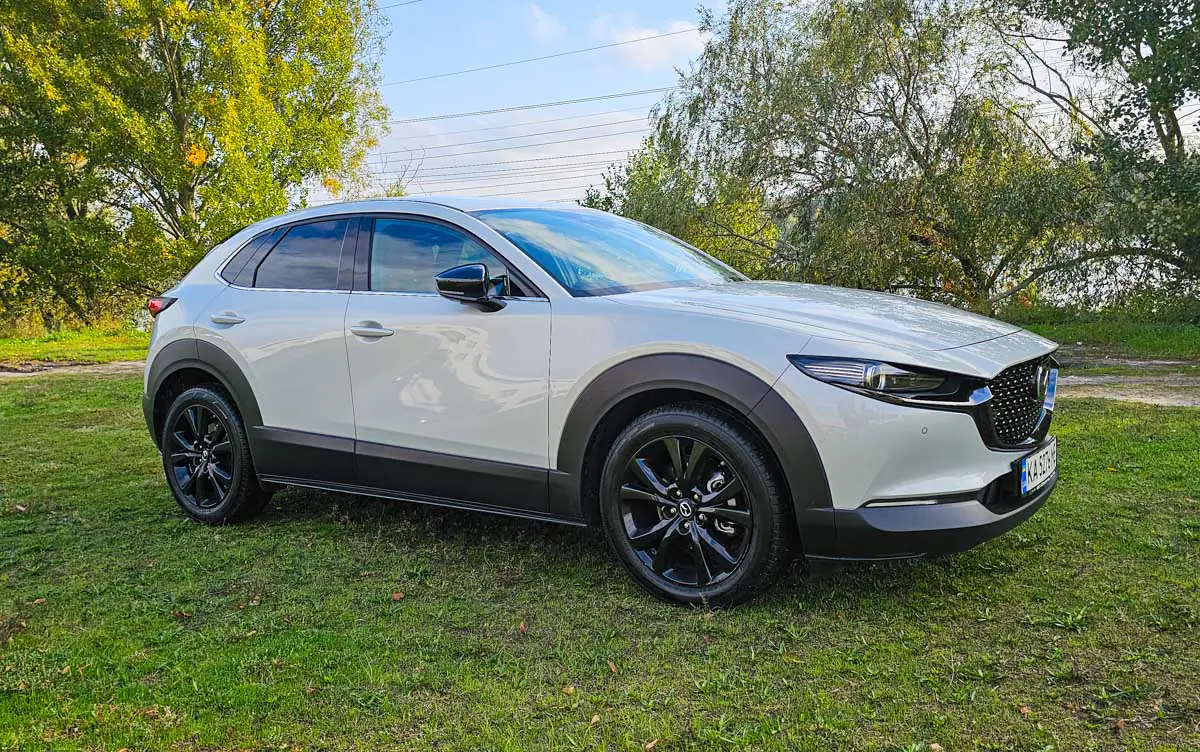
Headlight
The Mazda CX-30 in the SPORT BLACK and PREMIUM trims comes equipped with adaptive matrix LED headlights featuring automatic high beam control.
The automatic headlight operation is controlled by an intelligent system that recognizes the surroundings using a camera located under the windshield.
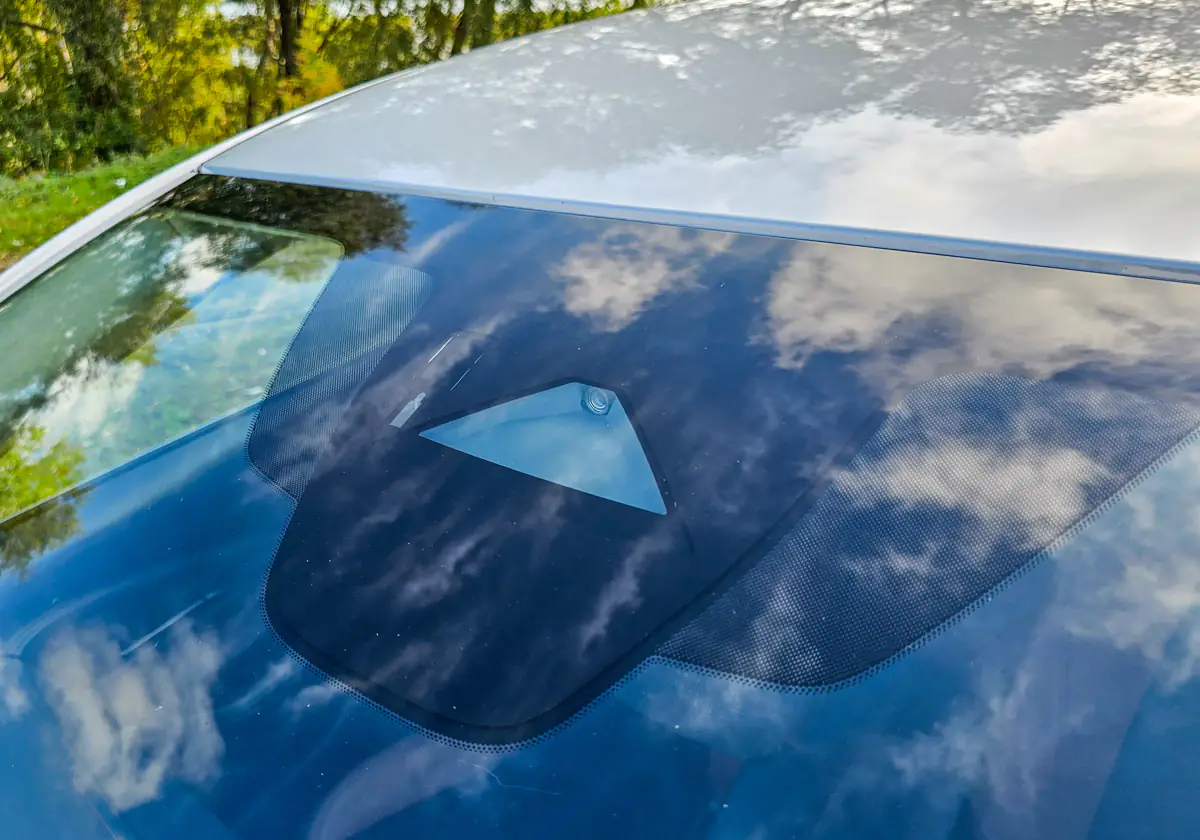
Video on how the ALH adaptive lighting system with LED segments works:

The system functions as expected, with no noticeable issues. In the STYLE+ and EXECUTIVE+ trims, the headlights are halogen and therefore lack adaptive capabilities, offering only automatic high beam switching. All CX-30 trims come equipped with headlight washers.
In addition to low and high beams, the headlight units also house position lights, daytime running lights, and turn signals. The headlights also provide cornering illumination, adjusting based on steering input. Additional daytime running light modules are integrated into the lower section of the bumper.
Side view mirrors
Both side mirrors on the CX-30 come with power adjustment, folding, and heating functions. They also feature LED blind-spot indicators positioned in the upper outer corner. Integrated turn signals and 360-view cameras are built into each mirror housing. Additionally, the driver’s side mirror includes an auto-dimming function.
Door handles and central locking
The front door handles are equipped with a keyless entry system. To unlock the vehicle, simply grasp the handle while carrying the key fob in your pocket or bag. Locking the car requires placing a finger on a designated touch sensor marked by a small indentation.
When locking the car, the side mirrors automatically fold in as well. In the vehicle settings, you can set a timer for the automatic locking of the central lock once you leave the car. The fuel cap cover also locks along with the rest of the vehicle.
Wheels
Our test vehicle is equipped with 215/55 R18 wheels, featuring black alloy rims that complement the overall sporty anti-chrome style. In other trim levels, the wheels are silver in color.
Taillights
The rear taillights are petal-shaped, a typical design for Mazda. They are fully LED, including the parking lights, brake lights, turn signals, and reverse lights. The brake light is also duplicated by a block of red LEDs in the spoiler above. Overall, the design looks sleek and modern, and there are no functional issues.
Read also: Škoda Karoq Review: Compact City SUV Focused on Comfort and Safety
Trunk lid, luggage compartment
The trunk lid features an electric drive for opening and closing. The process can be controlled via two buttons on the lid (one on the outside and one on the inside), a button inside the cabin near the driver, or the key fob. A removable cover is placed over the trunk, which opens and closes along with the lid.
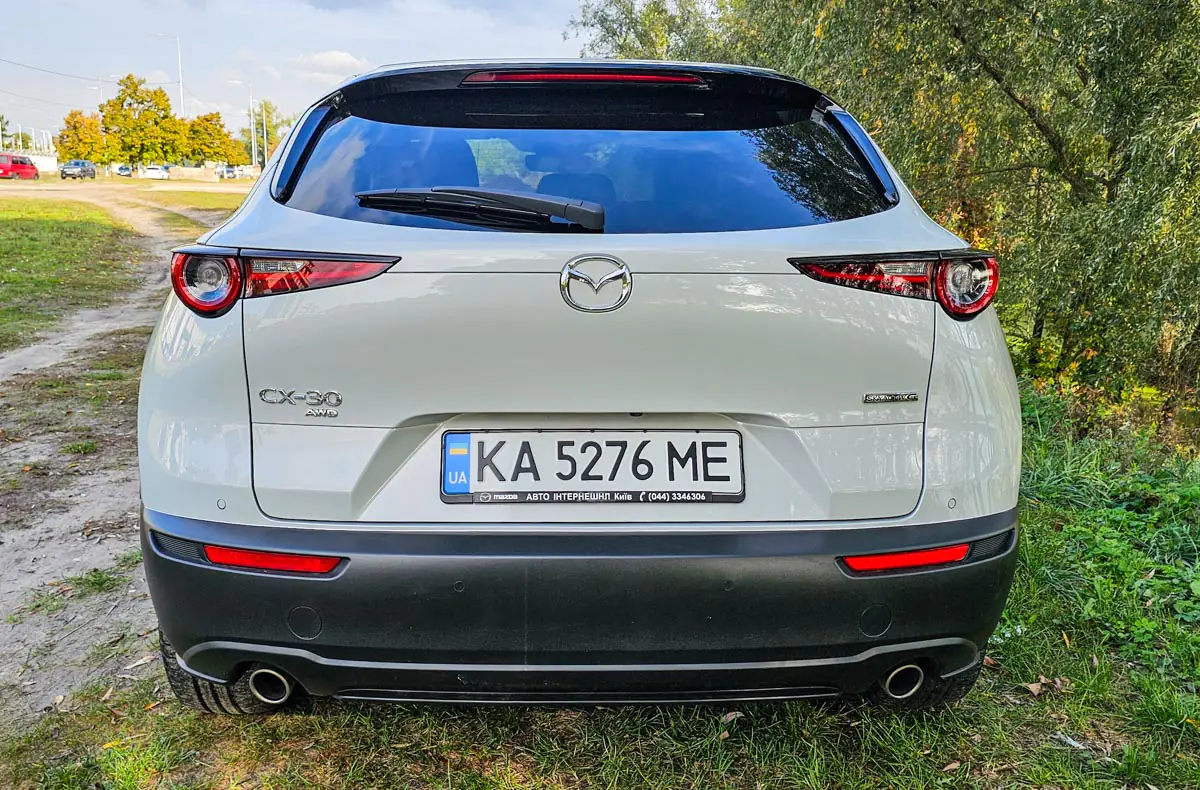
The CX-30’s trunk offers 420 liters of space. Of course, the useful volume can be expanded by folding down the rear seatbacks. The interior walls of the trunk are lined with felt upholstery. On both the left and right, there are small storage niches for additional items.
The trunk is illuminated by a single LED light. However, its placement is well-thought-out — it’s positioned at the top on the left side. The light itself is bright, effectively fulfilling its purpose and performing better than the average trunk lighting on the market.
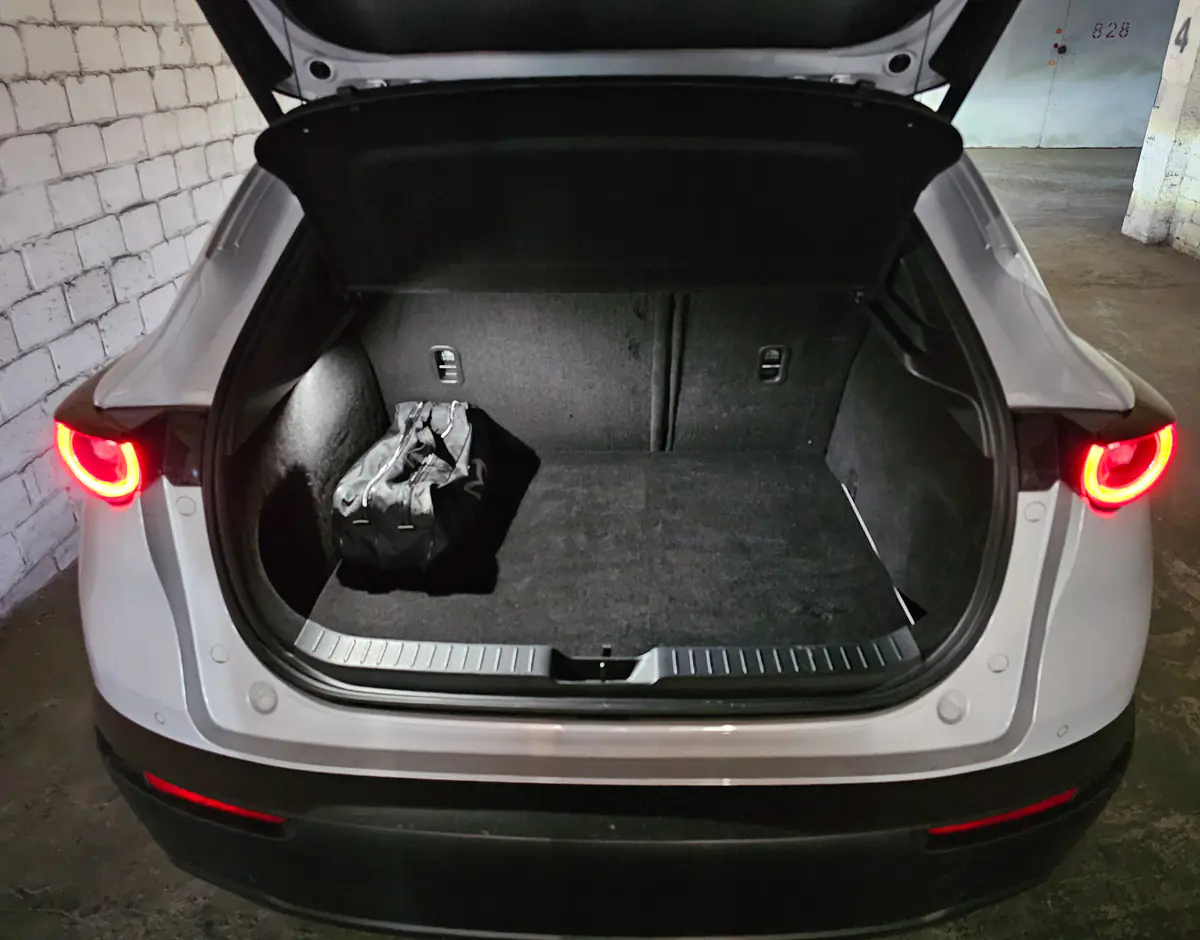
The trunk floor is made of corrugated plastic, similar to the wall panels used in construction (often referred to as “wainscoting” in common parlance). Under the floor, there’s a high-quality foam organizer that holds the spare tire, tools for tire replacement, and a subwoofer integrated into the spare wheel.
Read also: Mitsubishi Eclipse Cross Review: True Japanese Car – Modern on Outside, Conservative on Inside
Under the hood – 2.0L AT 150hp engine
The car is equipped with Mazda’s signature atmospheric Skyactiv-G gasoline engine with direct fuel injection. I’ll discuss its performance on the road later. The inside of the hood is fitted with a soundproof panel. In terms of practical features, everything in the engine bay seems to be conveniently arranged. The engine is covered by a plastic cover that is easy to remove. The maintenance points and fluid filler caps are positioned accessibly. Access to the battery and fuse box is also straightforward.
Read also: Škoda Octavia A8 Review: When You Get More Than You Expect
Mazda CX-30 interior and cabin
When I first saw the interior of the CX-30, it made a positive impression on me. To be honest, I like this interior more than the one in the larger and more expensive CX-60, even though the features here are a bit more basic. Overall, the cabin feels more modern and, to me, even more premium. Perhaps this impression is due to the bright color of the seats – a combination of terracotta and black. Also, the way the dashboard line seamlessly flows into the door panels looks really cool.
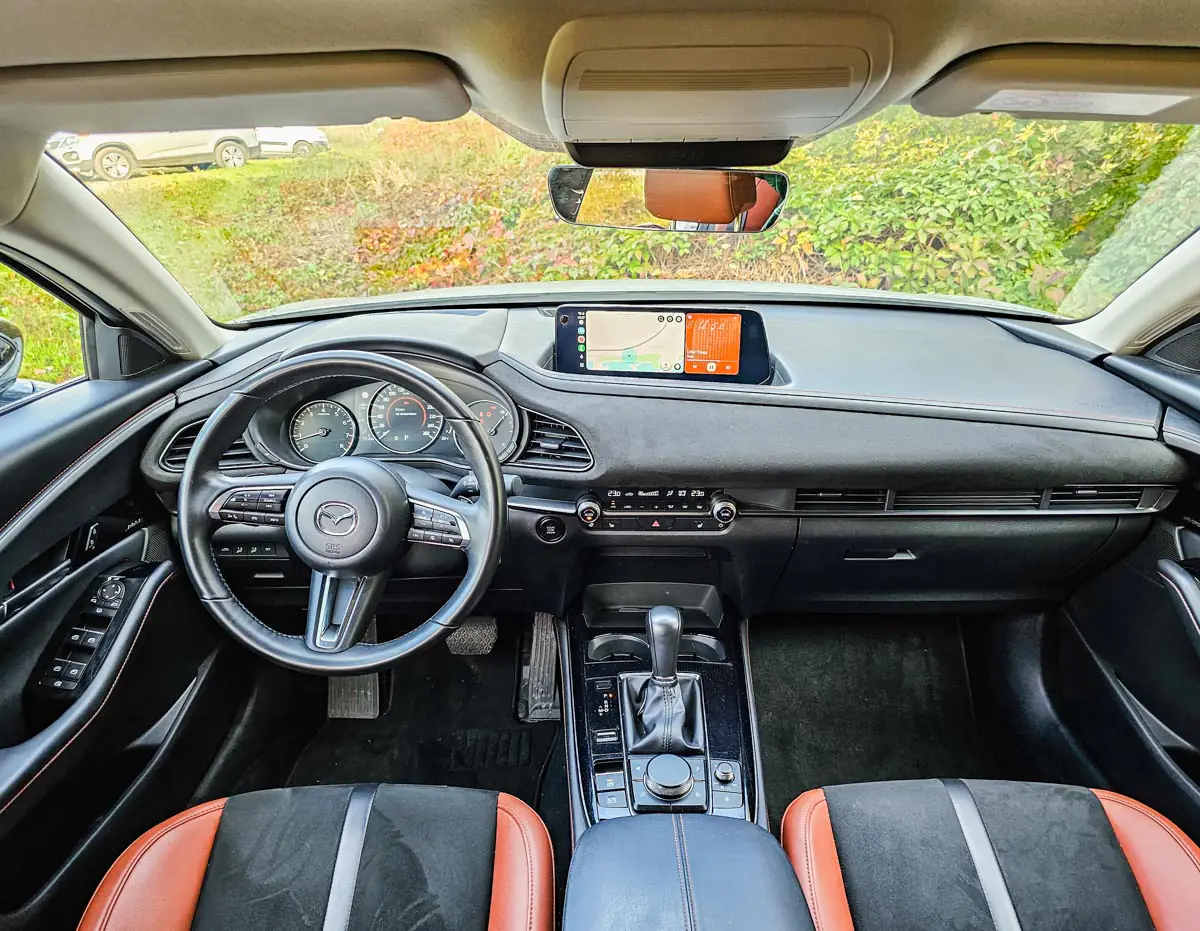
There are a few complaints about the interior, though. First, why is the ceiling light in the SPORT BLACK trim? This detail seems a bit out of place with the overall design. Just to remind you, the sport version of the CX-60 had a black ceiling. Second, the glossy black plastic on the central panel and a bit on the door cards scratches very easily.
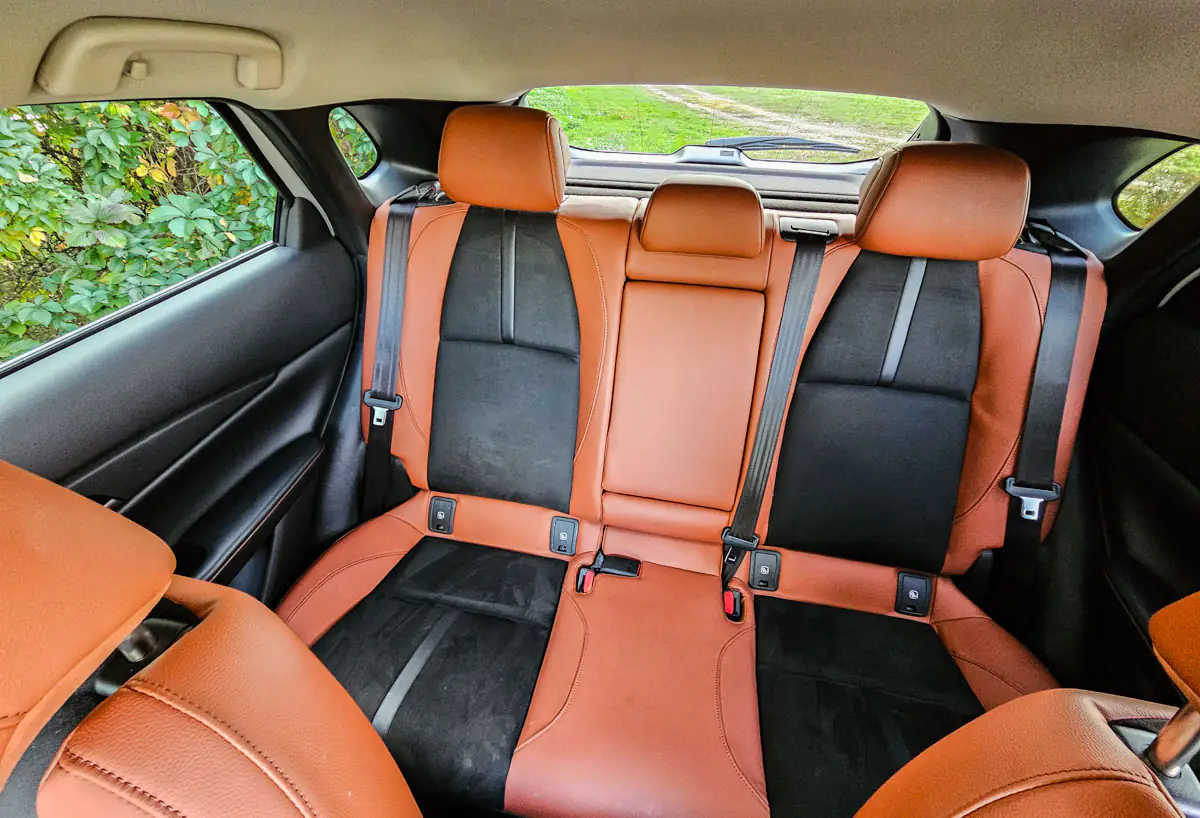
Door cards, door handles
The interior door trim is quite attractive. The panels are assembled well, and there’s nothing to complain about the soft vinyl on top, the textured plastic section, or the handle wrapped in synthetic leather with stitching. The only downside is the glossy black details, which have already shown noticeable scratches during testing, and this issue will likely continue.
As for the functionality of the doors, all of them are equipped with window lift buttons and steel door handles with latches. Additionally, the driver’s door features buttons for controlling the central locking system, all the window lifts, and the mirror adjustment panel.
The CX-30 (as well as the CX-60, by the way) has a slightly strange placement of the main audio system speakers in the doors. Usually, manufacturers use a thickening in front of the pocket for this purpose, but here they are installed in the central part in front of the armrest. Accordingly, the diameter of the speakers seems to be too small given the size of the mesh, but looking ahead, I will say that this does not affect the sound quality.
Front seats
The front seats are of good quality and fairly comfortable. They are equipped with heating, but lack ventilation. The main upholstery material is terracotta eco-leather and black suede. The driver’s seat features electric adjustments for positioning, controlled via three joysticks located on the plastic side panel at the bottom. Additionally, there’s lumbar support adjustment. The passenger seat, on the other hand, is manually adjustable using several handles and levers.
The driver’s seat also has memory functionality, which is integrated with the mirror settings. You can save the seat adjustments to one of two slots using a dedicated button located below the dashboard, to the left of the steering wheel.
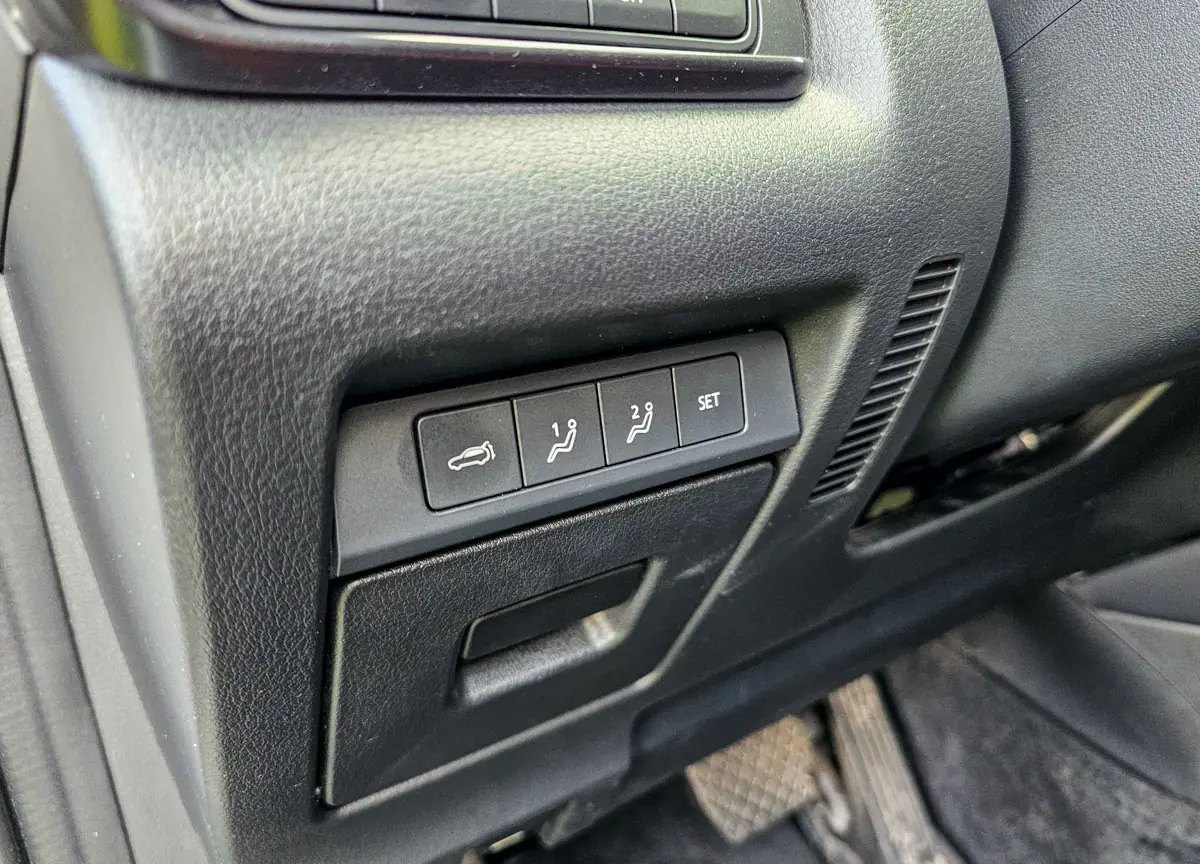
Rear seats
The rear seats have a similar design and use the same materials as the front ones. However, they lack seat heating. There are two full-sized, non-adjustable passenger seats and a third middle seat – which is only usable if absolutely necessary. All seats are equipped with seat belts and headrests.
In terms of comfort, there aren’t any major complaints about accessing the rear seats. However, it’s worth noting that there isn’t a lot of space for taller passengers, as their knees may come into contact with the front seats.
If there’s no passenger in the middle seat, the backrest can be tilted forward, transforming it into an armrest with cup holders.
Rear passengers have the option to adjust the intensity and direction of the heating system airflow through two vents. However, there are no charging ports available for devices, which is something I haven’t seen in cars of this class for quite some time.
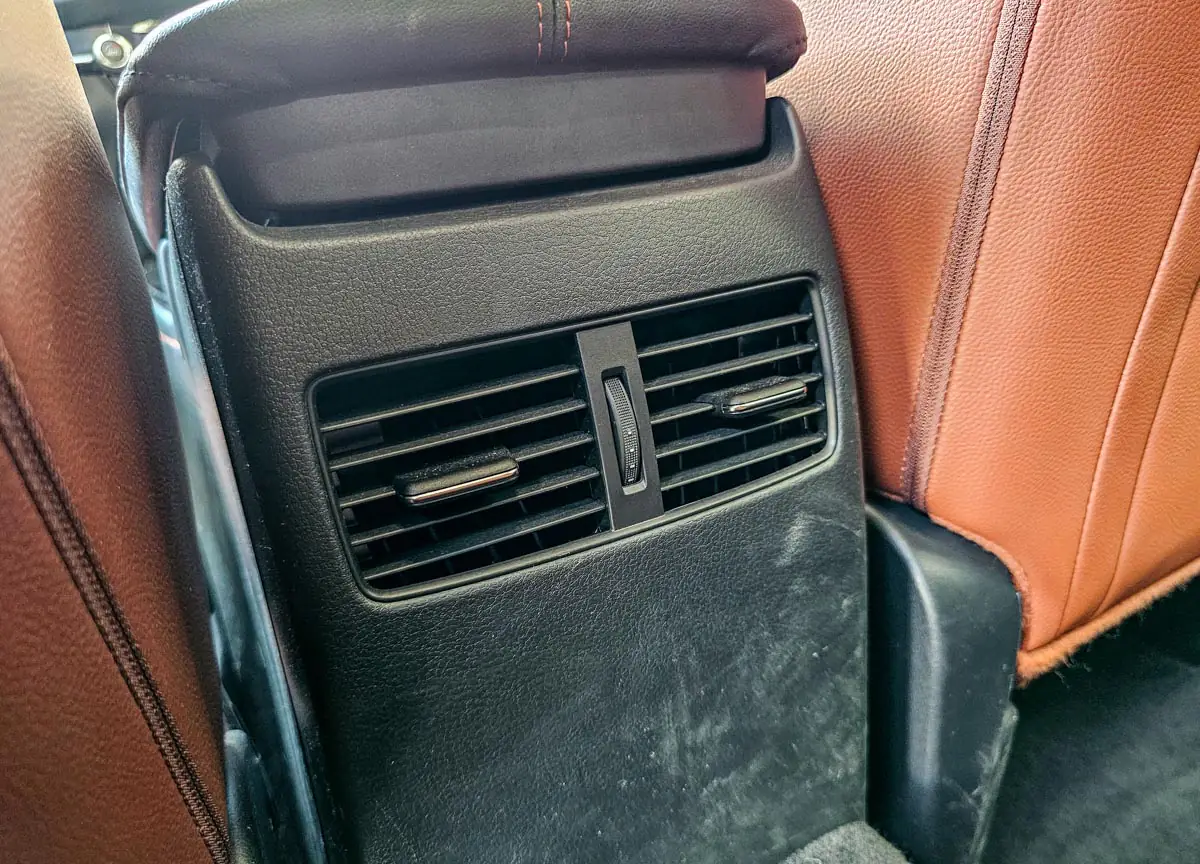
Dashboard and storage compartment
The dashboard in the Mazda CX-30 looks quite good. It features a multi-layered design, which is currently a popular trend among many automakers.
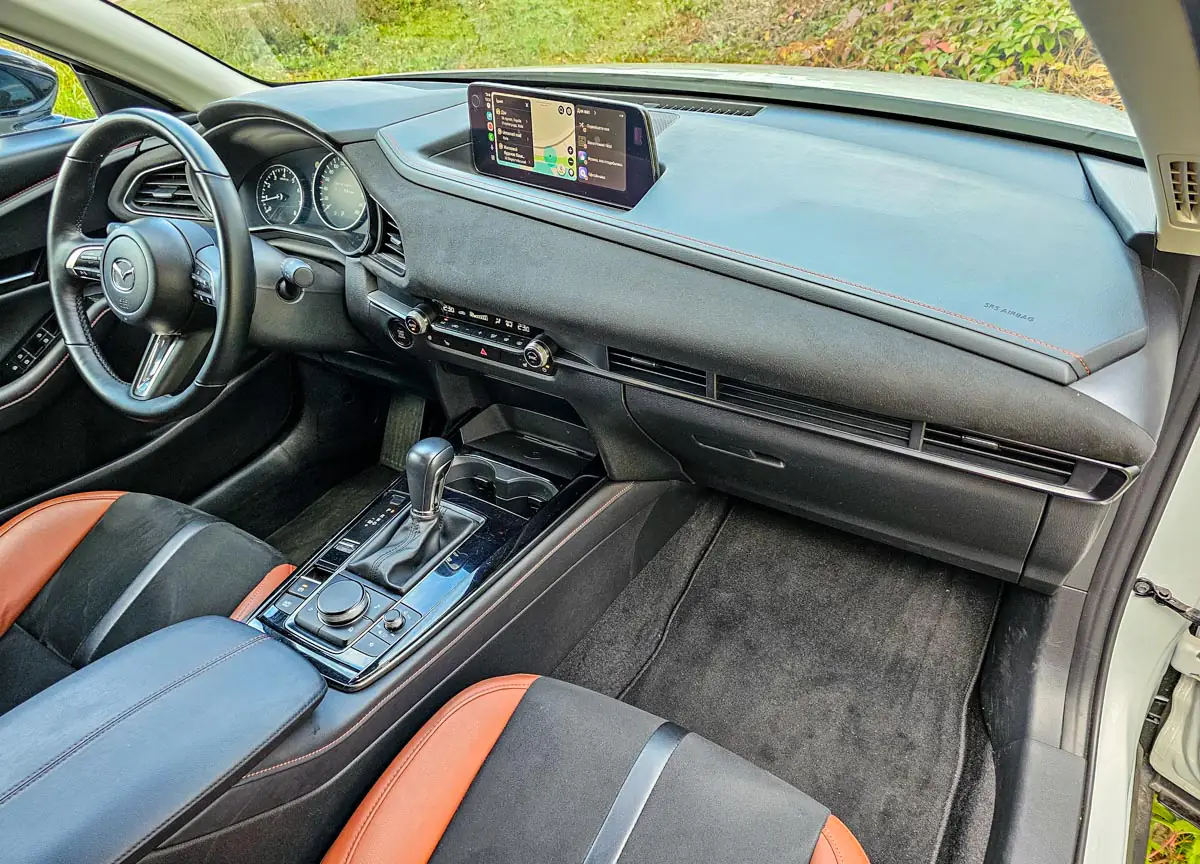
The upper part of the dashboard features high-quality thermo-vinyl with a soft base and red stitching along the edge. The middle section is covered with black suede, which looks good and feels pleasant to the touch. Below, there’s a “belt” with ventilation grilles and panels containing buttons, followed by standard textured black plastic.
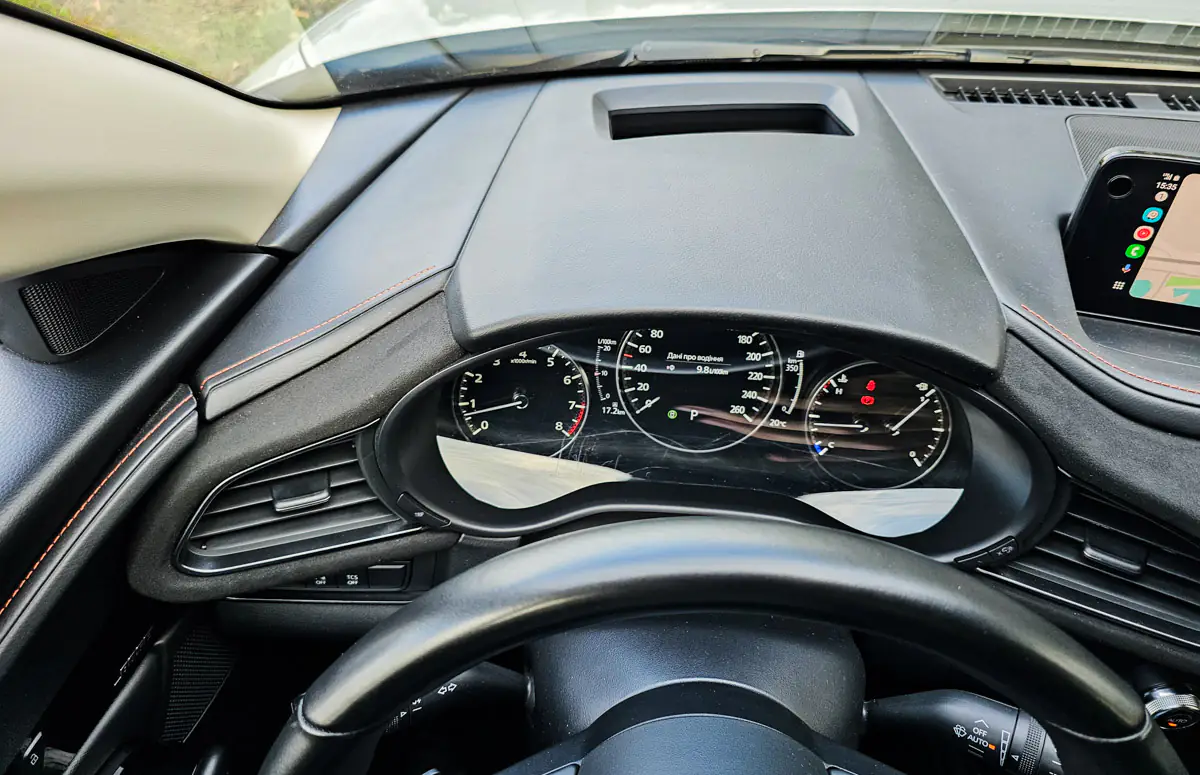
On the right side, there’s a standard glove compartment in front of the passenger seat. On the left, there is a small sliding storage compartment.
Steering wheel and steering column
The steering wheel follows the typical Mazda design, similar to that of the CX-60. It’s round with three spokes, with buttons and joysticks on the left for controlling multimedia playback, and controls for the adaptive cruise function on the right.
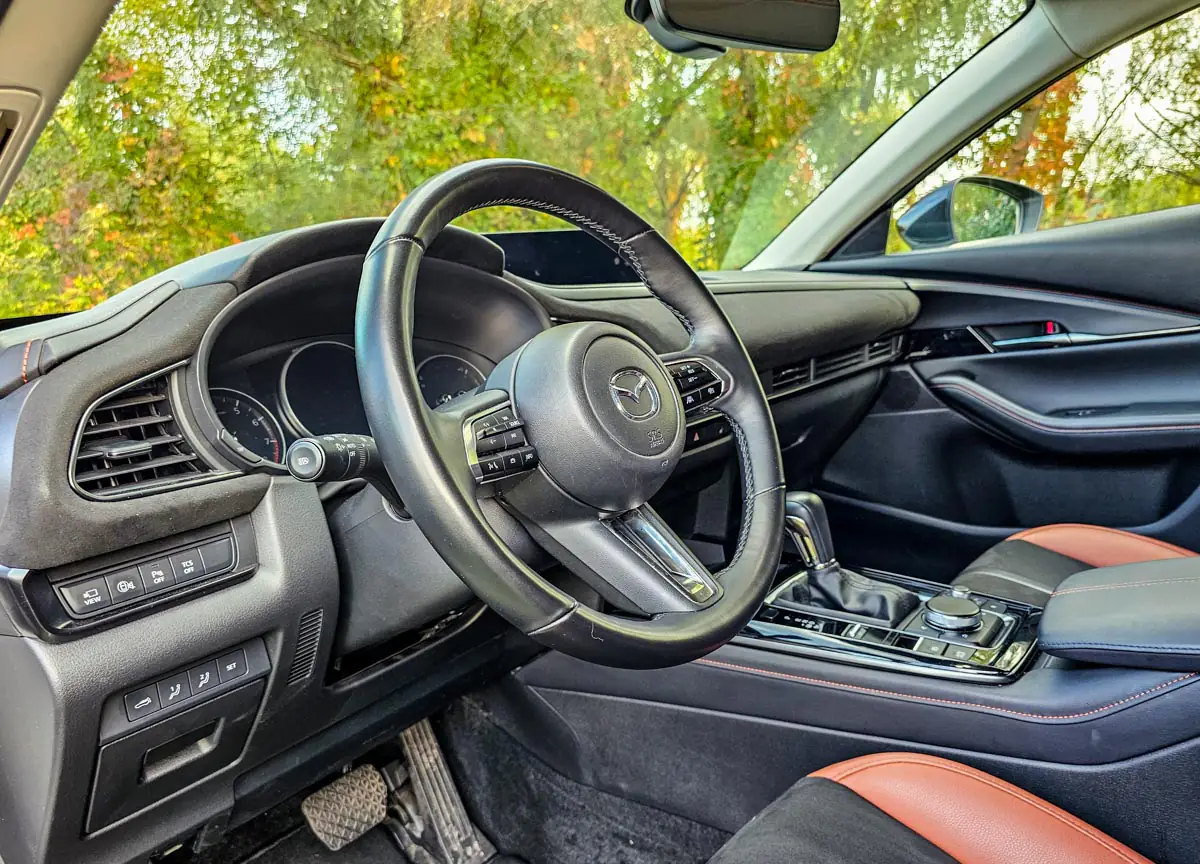
The buttons are well-separated thanks to the horizontal ridge on the upper row and the indentations on the buttons below. Overall, using them is quite convenient after a short period of adjustment. The steering wheel is wrapped in genuine leather, and there is a heating function as well.
The steering column is manually adjustable. Behind the wheel, there are two paddle shifters for gear changing and two traditional stalks – one for controlling the lights and the other for the windshield wipers. Speaking of the wipers, it’s worth noting that the windshield washer system is a bit unusual here – the nozzles that spray the fluid are not located on the hood but directly under the wiper blades. The washer fluid is delivered via flexible hoses straight to the working area of the wipers.
Dashboard
The Mazda CX-30 features a hybrid instrument panel, which includes two traditional mechanical zones: a tachometer on the left and a temperature gauge with a fuel level indicator on the right. In the center, there is just a circular frame, beneath which is a single 7-inch TFT display that shows the speedometer masks and various useful information. Here’s what the instrument panel looks like when powered off:
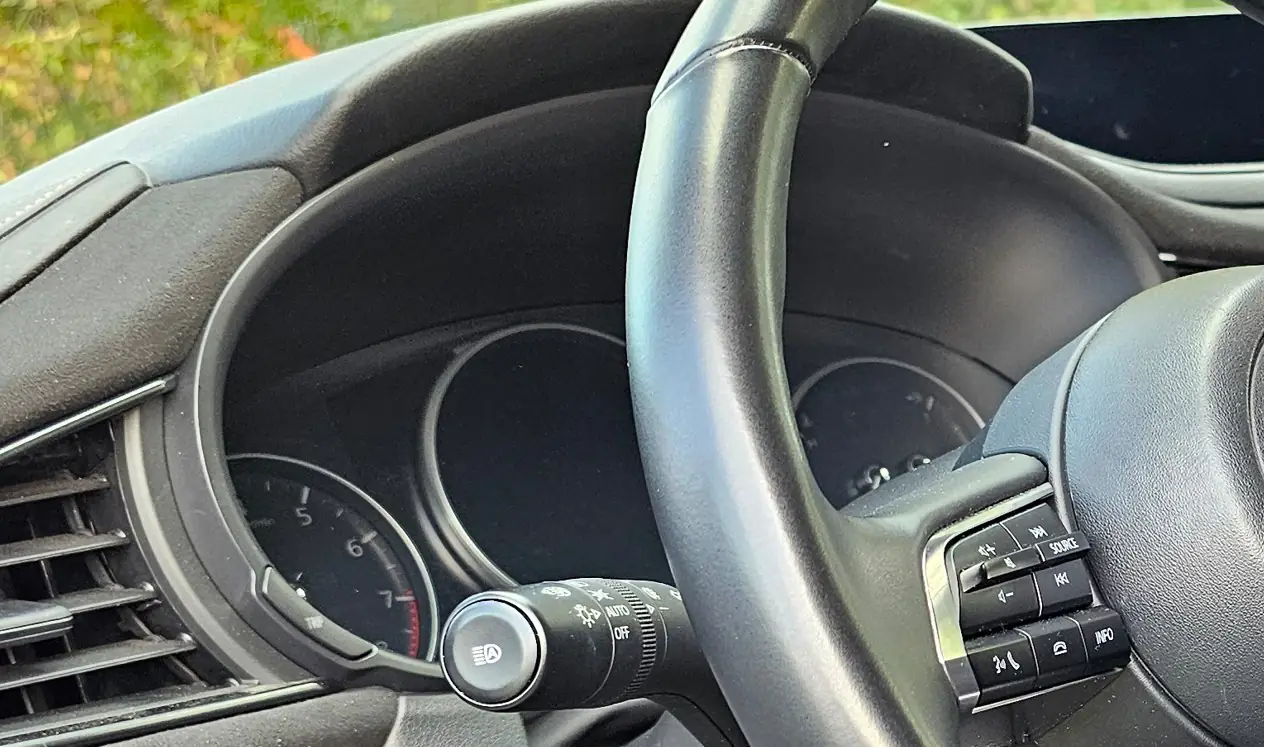
And here you can clearly see the illuminated display area:
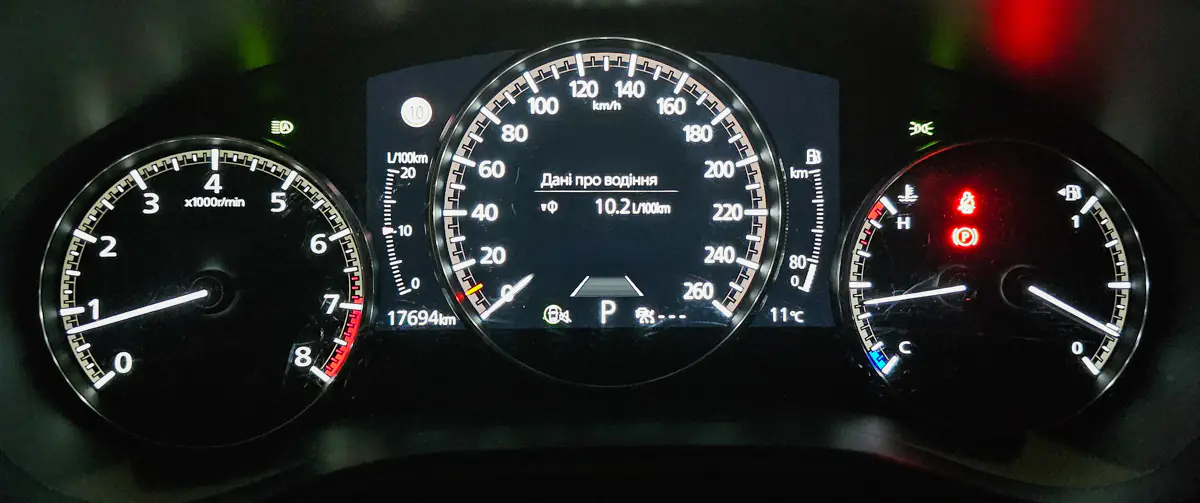
Depending on the activated modes and safety features, the instrument panel offers several different layouts. These range from traditional ones, with a circular speedometer and tachometer, to more futuristic displays with a digital speed indicator and radar data showing surrounding vehicles or obstacles when adaptive cruise control is engaged. The instrument cluster is also capable of reading traffic signs using a camera located under the windshield and displaying speed limit information for your route.

The car is also equipped with a heads-up display that projects key information onto the windshield, such as current speed, active speed limits, and navigation system maneuver warnings.
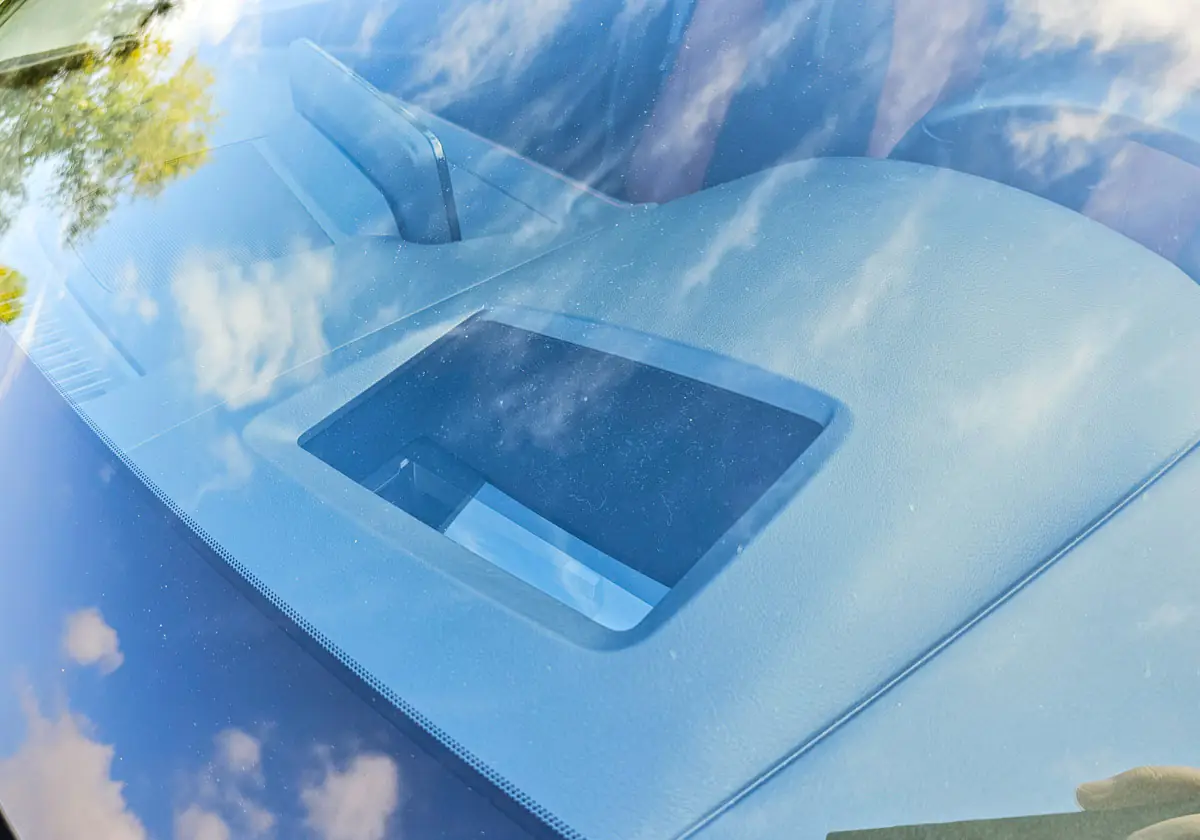
Multimedia display and entertainment system
The main component of the infotainment system is a 10.25-inch high-quality display, positioned in the center of the dashboard.
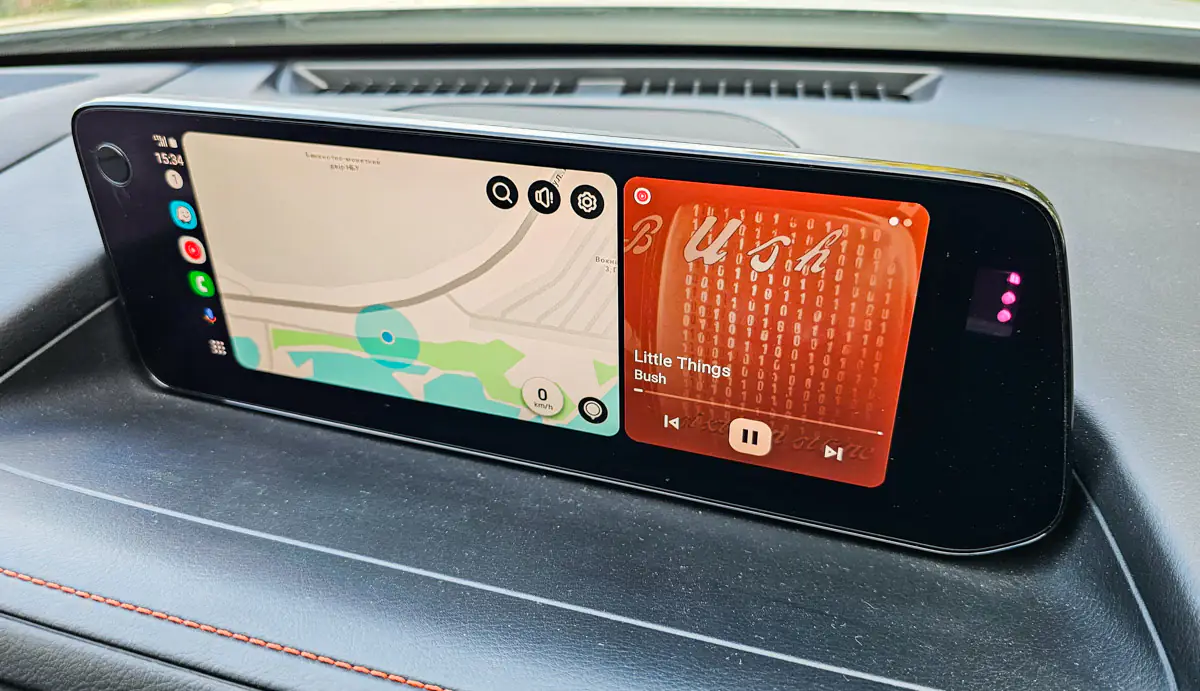
In reality, despite the seemingly large diagonal, the display isn’t that big. It’s just very wide, not tall. However, it’s sufficient for all typical automotive system tasks. Personally, I’m not a fan of large displays in cars; I feel they can be more distracting from driving.
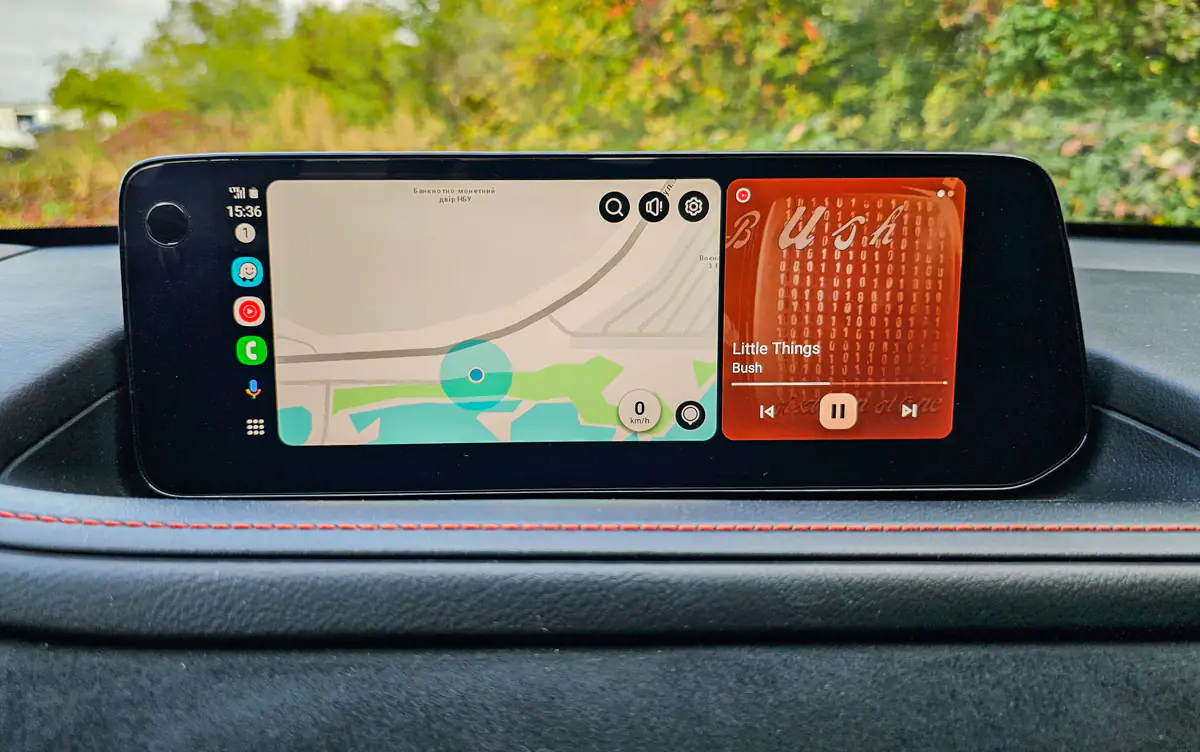
A key feature of Mazda vehicles (possibly all of them, though I’m not certain) is that the display is hardware-equipped with a touchscreen. However, touch and gesture control is only available for Android Auto and Apple CarPlay, and doesn’t work with the built-in car interface. Instead of touchscreen control, the car uses a mechanical panel with dials, joysticks, and buttons on the center console. The main large dial allows for menu navigation, with pressing it to select or confirm, and moving left or right by pressing the sides. There’s also a smaller joystick-dial for controlling sound and music playback, along with a few quick-access buttons and one customizable button for a favorite feature.
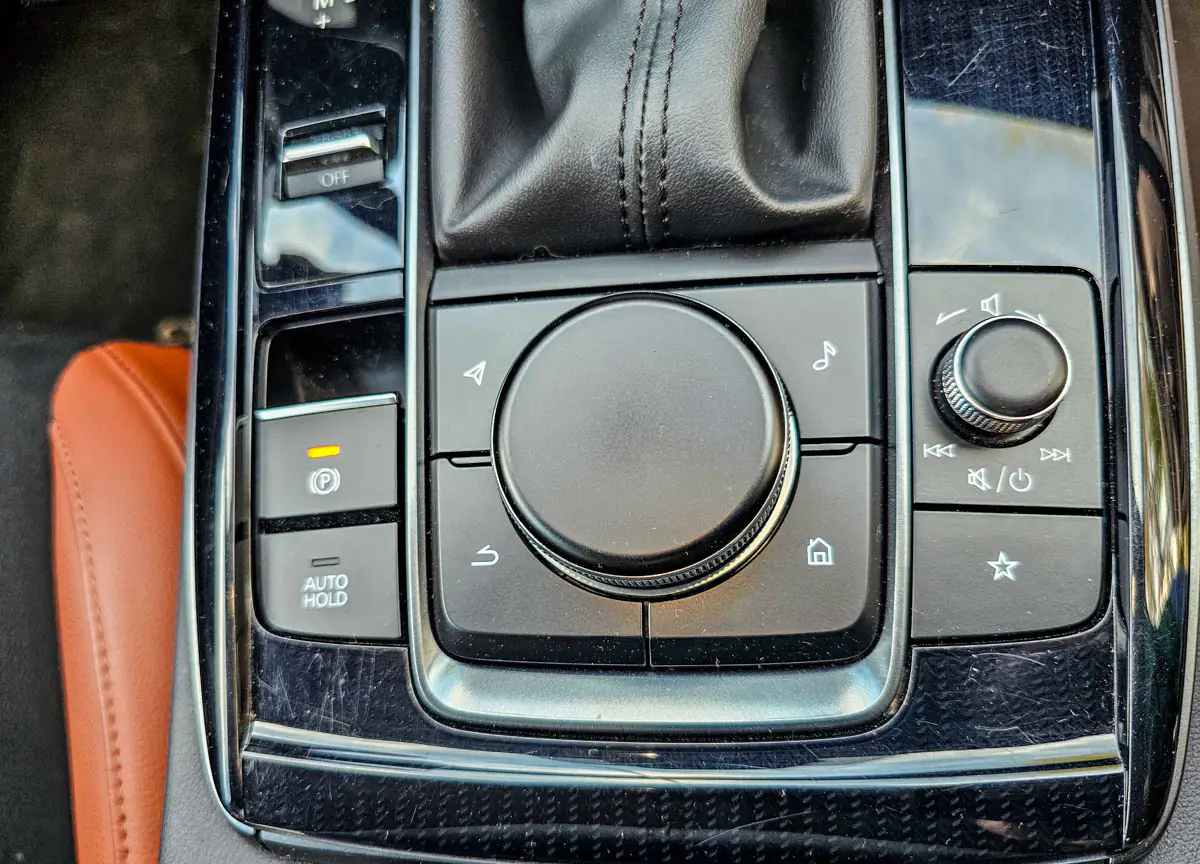
To justify the tactile control method for the entertainment system, I can note that the controls are positioned in a convenient spot—right under the right hand. After a short adjustment period, you’ll likely be able to use them by touch. However, it’s still a rather strange decision, probably driven by safety concerns that feel somewhat overblown. Personally, I’m not a fan, but I accept it, it’s fine.
Overall, I view the built-in system mainly as a menu for adjusting and storing the car’s basic settings. It also allows you to connect an Android or iPhone smartphone to the car. Once connected, all navigation, music playback, and hands-free phone calls via Bluetooth are handled through Android Auto and Apple CarPlay, where touch controls are available.
Mazda CX-30 audio system
The top trims of the Mazda CX-30 come with a Bose audio system featuring 12 speakers, including a subwoofer located in the trunk, inside the spare tire.
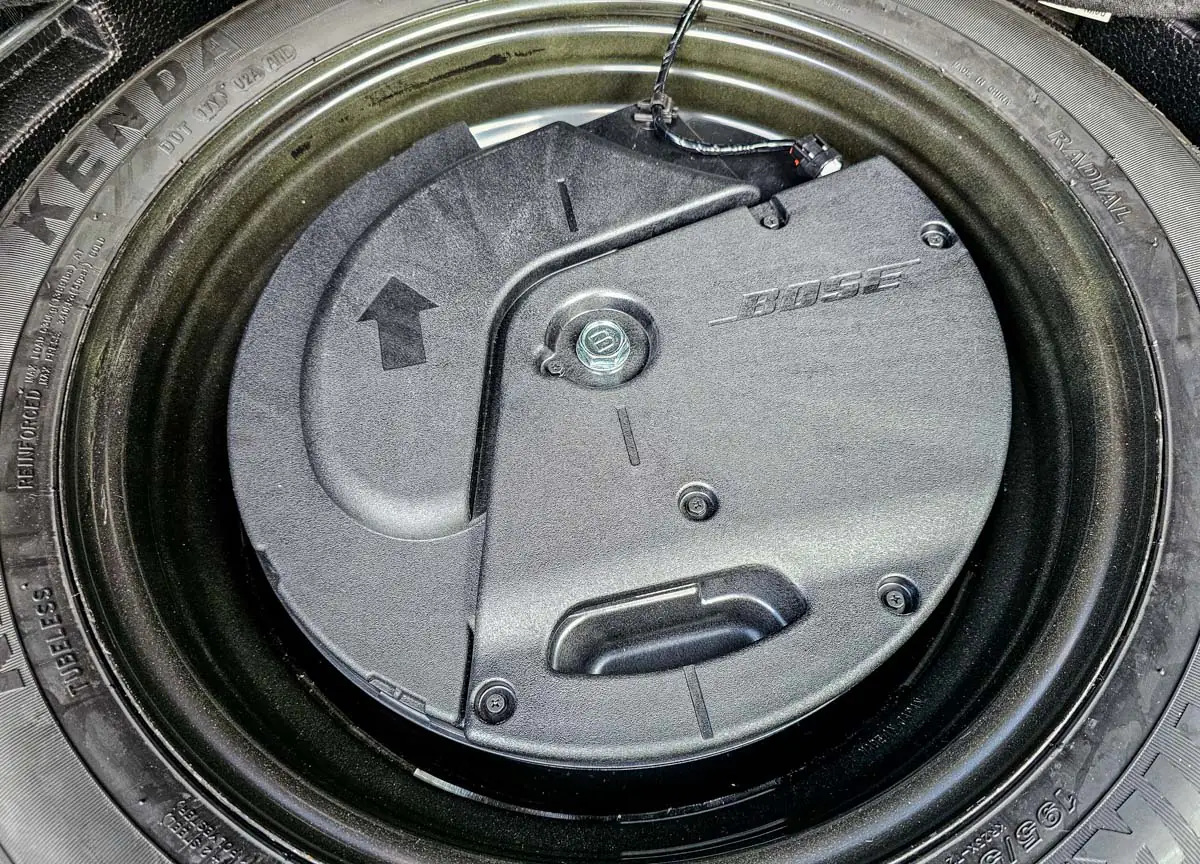
I have no complaints about the sound quality of the system; it’s excellent, and I’m fully satisfied. The sound is clear, rich, and immersive. The multimedia system menu also offers additional settings to enhance and personalize music playback.
Climate control panel
The Mazda CX-30 is equipped with a dual-zone climate control system, offering separate settings for the driver and front passenger. It also includes seat heating functions for the front seats. As for the control panel, it’s located in the center under the dashboard and features physical buttons and dials, which I personally prefer—I’m not a fan of touchscreen climate controls.
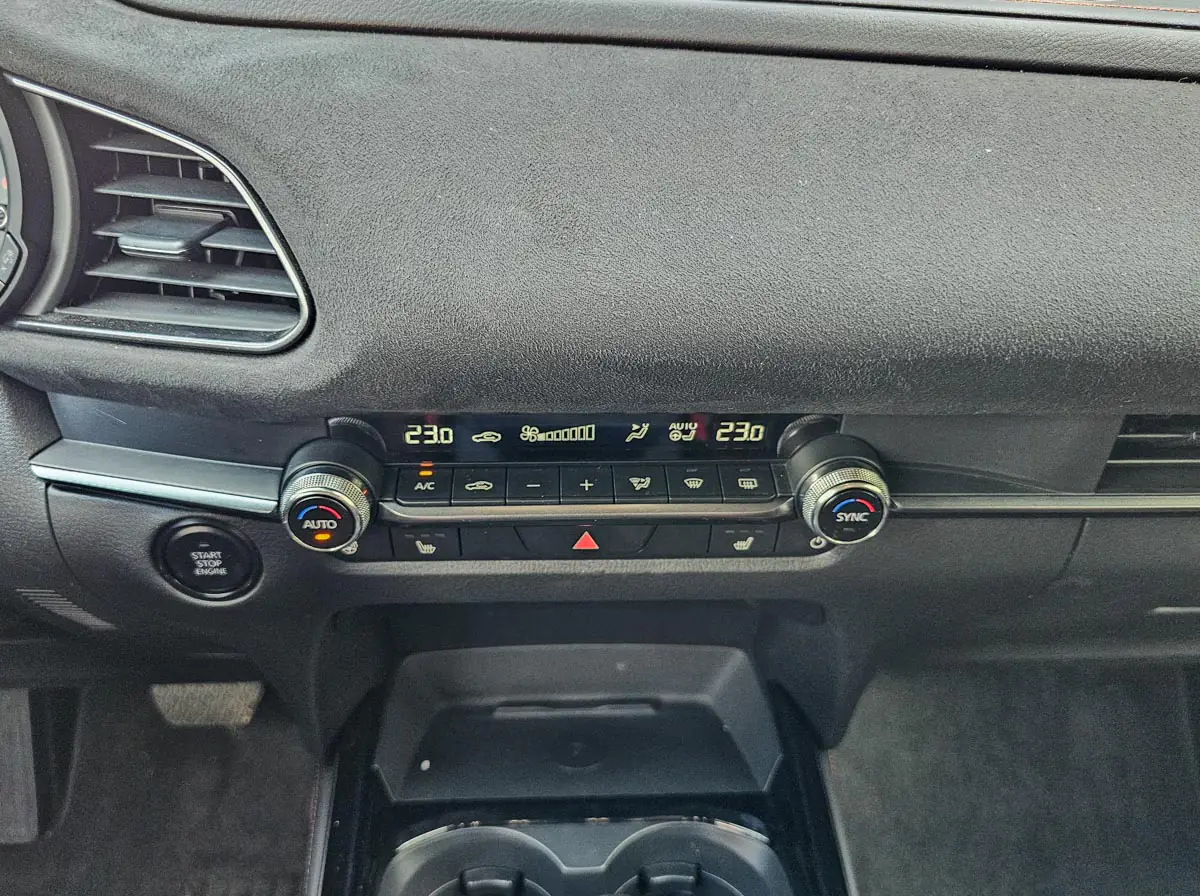
Center console, gear lever, charging and ports
On the center console, there’s a smartphone charging pad with wireless charging capability, a block with two cup holders, and the gear lever. Closer to the driver, you’ll find the button for activating all-wheel drive and the switch for sport mode.
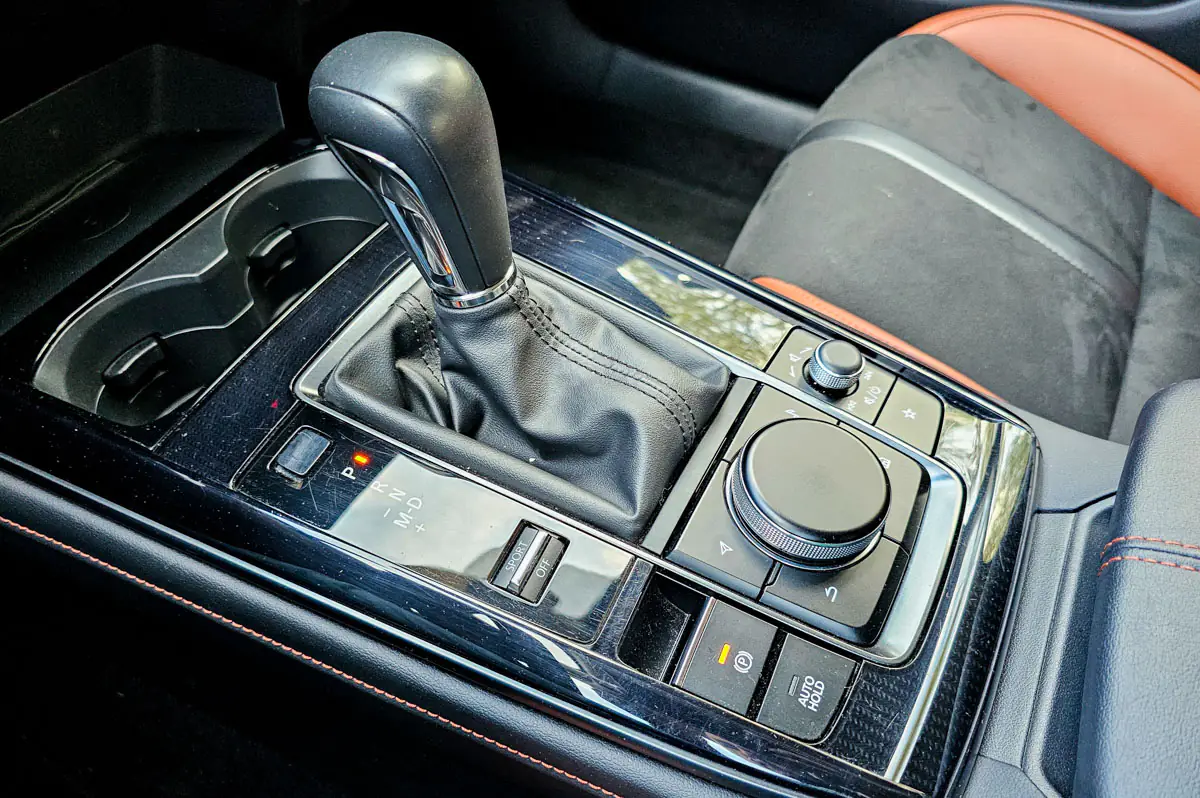
Next, there’s the electronic parking brake, a button to activate the automatic brake hold system when stopped, the multimedia system control panel, and a central storage compartment with a lid that doubles as an armrest, which can slide back.
Inside the storage compartment, there are also two USB-C ports, a 12V socket, and a memory card slot, which, as far as I understand, is for navigation system maps.
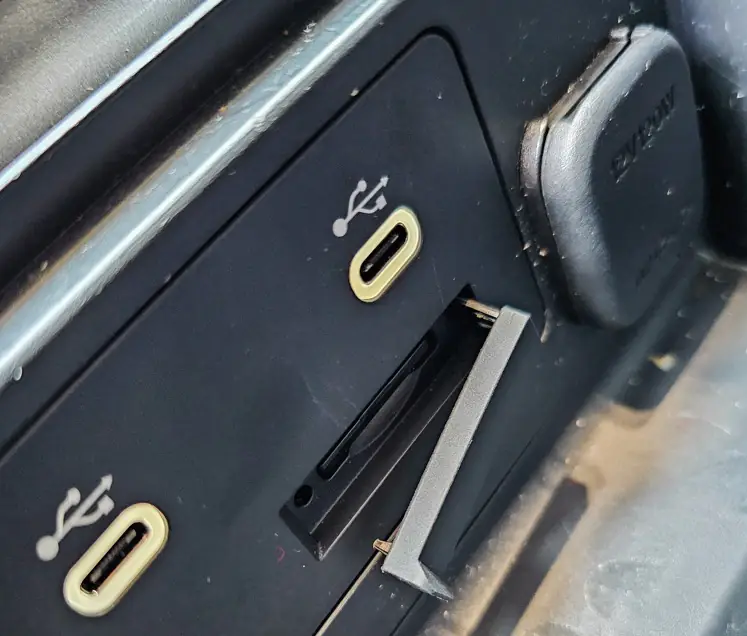
Ceiling, center mirror, upper console, interior lighting
As I mentioned earlier, the Mazda CX-30 has a standard light-colored headliner. The rearview mirror features an automatic dimming function, and its position is adjusted manually. There’s also a storage pocket for sunglasses behind the mirror. The cabin is illuminated by four LED lights (two in the front and two in the rear on the ceiling) and two lights under the sun visors.
“Ambient light” – interior lighting
Unfortunately, there’s no ambient lighting in the car, just the standard point lighting for the control elements. Even minimal footwell lighting for the driver and passengers, as seen in the CX-60, is absent, which is odd. For some reason, the Japanese don’t seem keen on following this global trend.
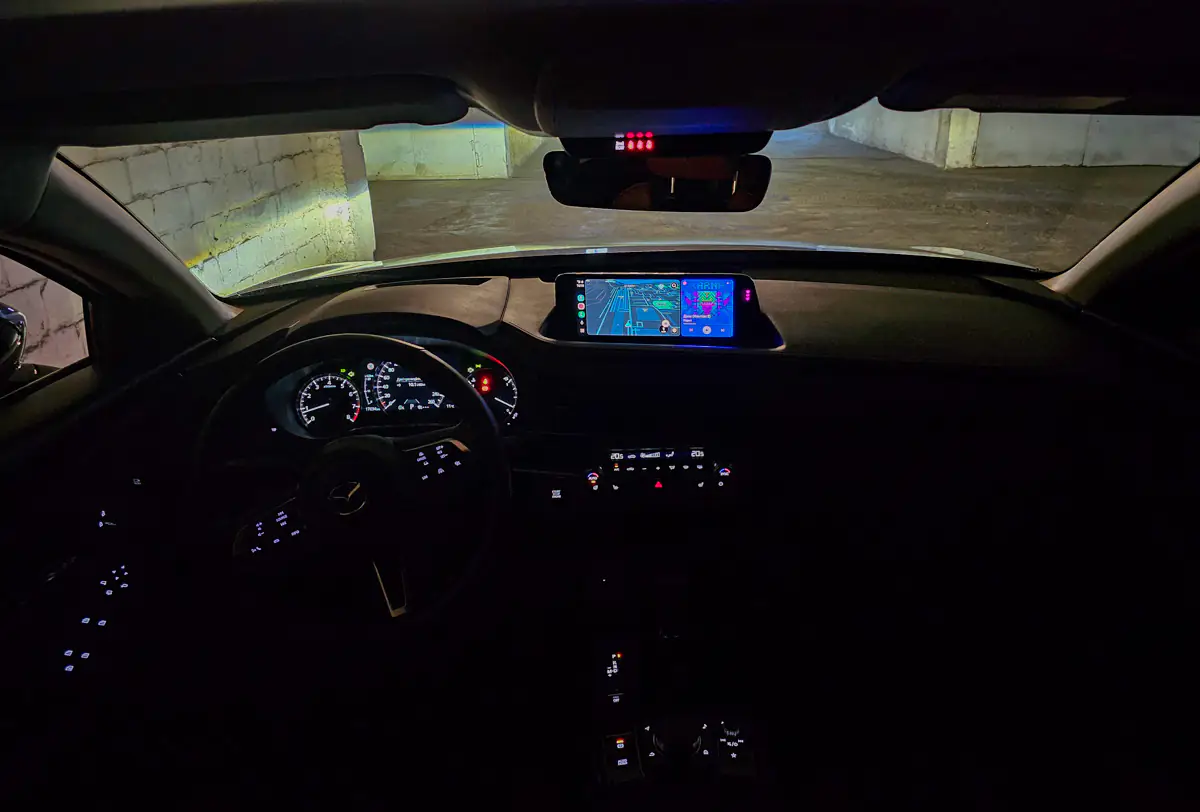
Read also: Škoda Kamiq 2024 Review: Is This Compact SUV Crossover Worth Your Attention?
Impressions of operating and driving the Mazda CX-30
Comfort and safety
Overall, the Mazda CX-30 is a quite comfortable car. During my time with it, I didn’t find any major drawbacks. Of course, there are some features missing, even in the top trims—such as electric adjustment for the front passenger seat and the hands-free function for opening the trunk. The lack of a panoramic sunroof is also a bit surprising. However, this is more about competitiveness, as similar features can be found in other cars at a comparable price.
On the other hand, everything that is included works flawlessly. The smart electronic assistants are implemented at a high level. Automatic headlights, lane-keeping assist, blind-spot monitoring, adaptive cruise control with stop-and-go functionality, parking assistants, cross-traffic alert while reversing, and a 360-degree camera are all present. There’s also auto-hold when stopped and on inclines. All of this allows you to focus entirely on driving the car without getting distracted by minor details. And this directly impacts safety, as you’d agree.
The front seats in the CX-30 are comfortable, and the rear seats are also decent. The sound insulation is average, but considering the price and class, it’s acceptable. Plus, with the pretty impressive audio system, you can turn up the volume and barely hear any external noise.
Dynamics
I haven’t dealt with naturally aspirated engines for a while, so my first impression was that the CX-30 felt like it wasn’t moving at all. But that’s not the case. You just have to be unafraid to push the engine to higher revs, and the performance is just fine. Well… I wouldn’t call this car particularly dynamic—10 seconds to 100 km/h is a pretty typical figure. However, the option to manually shift gears using the paddles or the gear lever is available for a reason. In this mode, you can extract the most from the engine. But if you’re after more exciting performance, you might want to look at the CX-60 with the 3.3L MHEV engine. As for regular, calm driving, I really liked the 6-speed automatic transmission—it works more than adequately, shifting smoothly.
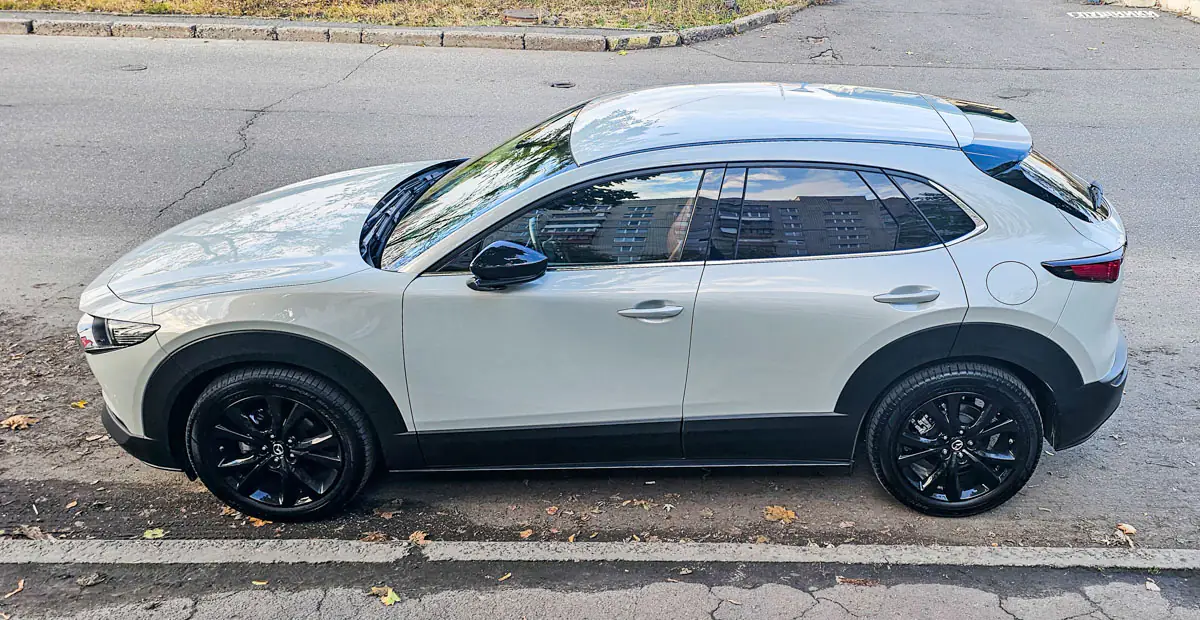
Handling and stability on the road
The main impression of driving the Mazda CX-30 is that the car feels fairly low, with a seating position more reminiscent of a hatchback or estate rather than an SUV. The suspension is of medium stiffness, which feels just right to me (unlike the overly firm ride of the CX-60 Premium-Sport). The CX-30 handles city road imperfections quite well, but I wouldn’t consider it a serious off-roader, despite the presence of all-wheel drive. As a result, this setup affects the handling—it grips well on long turns, but during sharp maneuvers, the car can feel a bit unsettled.
Fuel consumption
In Kyiv, my fuel consumption averaged around 10 L/100 km, which is typical for this class of mid-sized SUVs with 150 horsepower gasoline engines. However, if you avoid pushing the accelerator too hard and keep a relaxed driving style without demanding too much power from the engine, you can lower the consumption to around 9 or even 8 liters, provided there are no traffic jams or frequent stops at traffic lights. On highways, fuel consumption starts from 6 liters per 100 km, and the figure will depend on your speed. At speeds of 140-160 km/h, the consumption stays around 9-10 liters.
Read also: Self-driving cars: how long to wait for revolution?
Conclusions
Overall, I liked the Mazda CX-30. However, it’s worth mentioning that I may be a bit biased towards the brand, as I used to own a Mazda 323 a long time ago, so I’m generally fond of the manufacturer’s philosophy. To be fully objective, though, it’s important to note that the CX-30 may find it challenging to win over unbiased buyers, given the competitive alternatives available in the market.
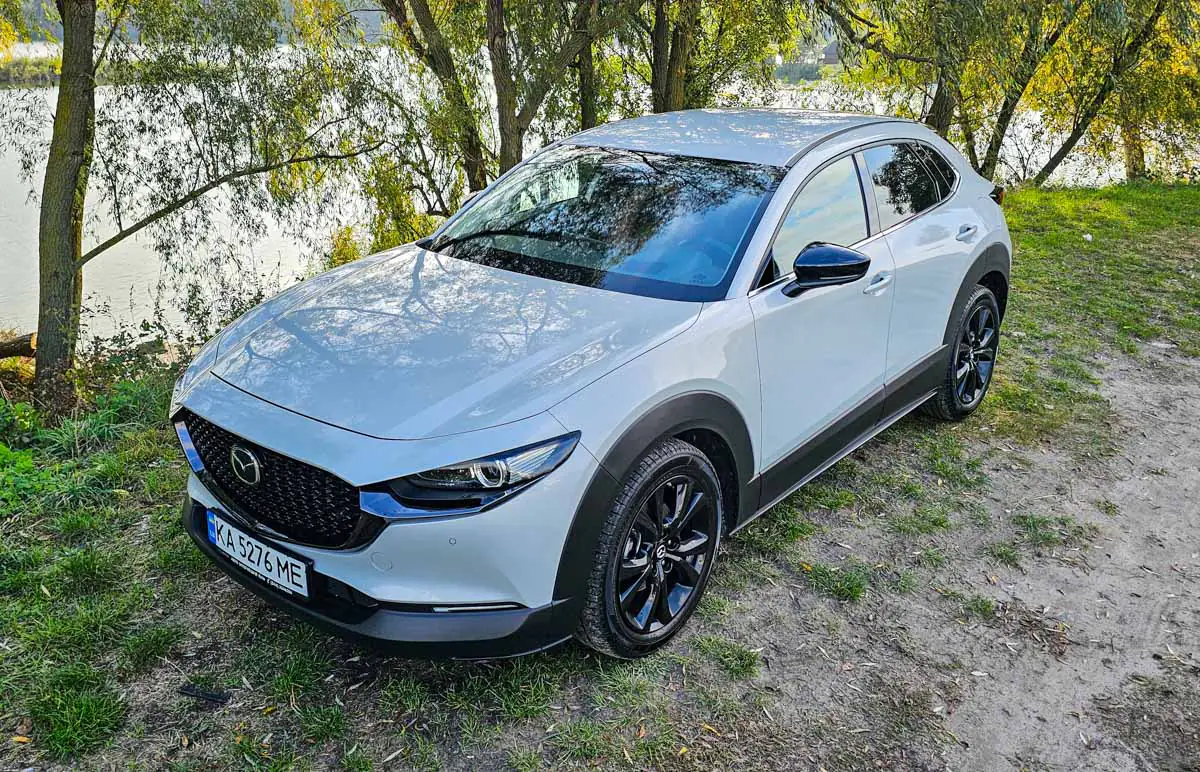
The car definitely appeals to me with its almost perfect design, both inside and out. In addition, it has great lighting and a premium audio system. All the automatic systems and assistants that should be in a modern car are present here, and they work reliably.
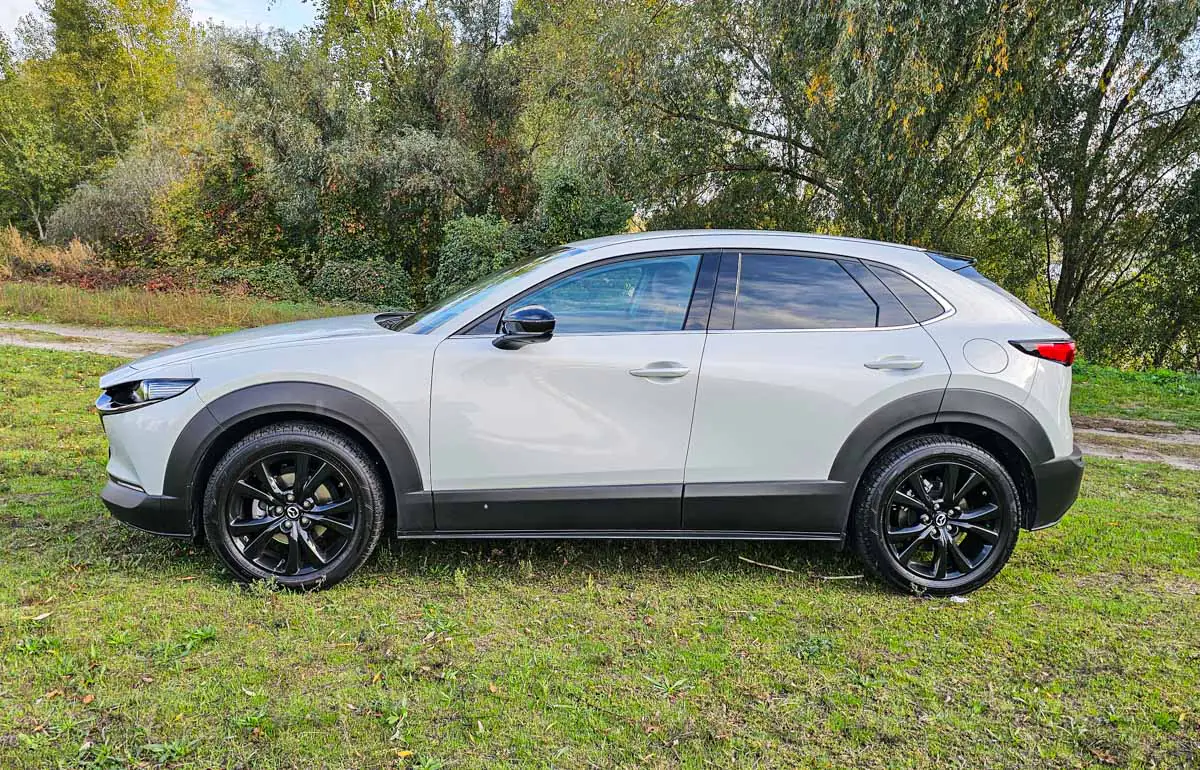
All other parameters and features can be considered average. I didn’t find any significant advantages in the CX-30 that would allow the model to stand out or offer an exceptional experience compared to competitors in its class.
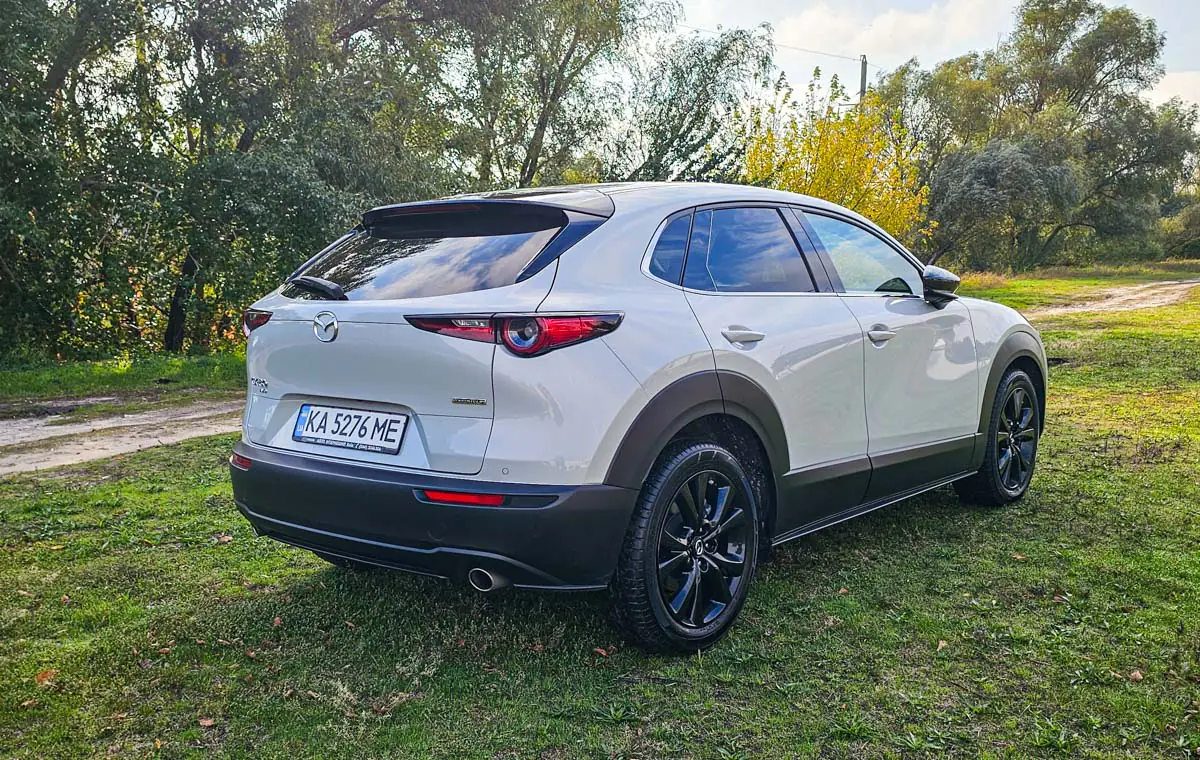
Liked:
- Exterior design of the car
- Stylish and comfortable interior
- Overall quality of materials and workmanship
- Headlights and taillights
- Operation of auxiliary systems and smart safety assistants
- Sound of the BOSE audio system
- Android Auto Apple and CarPlay wireless connection
- Transmission, chassis and handling
Cons:
- No panoramic roof in all trim levels
- Light ceiling in the SPORT BLACK version – out of place in the overall interior design concept
- Lack of ambient interior lighting
- No hands-free function for opening the trunk
- Lack of a mobile application



